Key Issues for Session 6: COVID, Climate and Constitution
This briefing has been produced by the Scottish Parliament Information Centre (SPICe), which is the Parliament’s impartial research service. It identifies some of the key issues that MSPs may face in the Parliament’s sixth Session. It is intended to assist MSPs and their staff, who are encouraged to contact SPICe if they require further information on these or any other topics.
Foreword from the Clerk/Chief Executive
Welcome to the Scottish Parliament Information Centre’s Key Issues for Session 6 briefing – COVID, Climate and Constitution.
The Scottish Parliament Information Centre (SPICe) is the Parliament’s internal research centre. Its subject specialist researchers and information specialists provide impartial, factual, accurate and timely information and analysis to support MSPs in undertaking parliamentary business. This includes support to enable MSPs to respond to constituency enquiries, scrutinise legislation and support the work of the Parliament’s committees.
The Key Issues for Session 6 briefing illustrates the kind of briefing SPICe produces for parliamentarians. It outlines some of the key subjects likely to be of particular interest in the coming Parliamentary Session, providing tailored, expert, impartial analysis of the issues that matter to MSPs and the Parliament.
Whilst the Parliament will undoubtedly engage with a broad range of issues during the next five years, SPICe has identified three broad themes which are likely to feature heavily in the work of MSPs during Session 6.
These themes are:
COVID-19 - The road to recovery.
The climate and ecological emergency and green recovery.
The devolution settlement post EU exit and UK relations.
Alongside these three themes, SPICe has highlighted another 26 issues for Session 6, covering all major areas of devolved policy, from mental health provision to the business base in Scotland, and from changes to family law through to changing car use. You can read the briefing from cover to cover, or you can easily dip into the issues that interest you most. I hope it proves to be a thought provoking and useful reference tool for the months and years ahead.
SPICe is here to support the work of MSPs. If you have any questions about how SPICe can help you in your duties please contact SPICe Team Leaders – their contact details and much more can be found in the SPICe service guide, accessible on the Parliament's intranet.
David McGill, Chief Executive
COVID-19 – The Road to Recovery
Kathleen Robson, Senior Researcher, Health and Social Care
Now that the COVID vaccine roll-out is firmly underway, the political focus in Session 6 will shift to the post-pandemic recovery. As the dust begins to settle, it is perhaps time to take stock and assess where the recovery may need to be focused.
Throughout the pandemic, both the Scottish and UK governments have talked about the four COVID harms:
COVID health harms
non-COVID health harms
societal harms
economic harms.
This serves as a useful model to assess the toll the virus has taken and examine the route to recovery.
It has not all been bad news, some areas such as crime and carbon emissions have improved over lockdown. However, the following details some of the key areas of harm that the recovery may need to mitigate against.

COVID-19 health harms
For the last year we have had daily updates on the level of harm inflicted by COVID-19 in Scotland. The grim totals (at time of writing) include 226,729 cases, 24,578 hospital admissions and 10,097 deaths involving COVID-19, including at least 3,400 in care homes.
There is also the unknown quantity of ‘long-COVID’, that is, those with long term health consequences after infection. It is estimated that around one in five people exhibit symptoms for five weeks or longer and around one in ten exhibit symptoms for 12 weeks or more. A recent ONS study tried to measure the overall prevalence of long-COVID and found 79,000 people in Scotland reporting symptoms.
This level of prevalence could have ongoing implications, not only for the individual, but also for the economy, in terms of productivity, and a potential increase in social security claimants.
It may also require a response from the health service, but treatment options are limited and people have mainly been treated by existing services such as general practice. NHS England is creating a network of long-COVID clinics but we have yet to see if Scotland will follow suit.
Non-COVID health harms
As the NHS responded to the unfolding pandemic, there was a scaling back of ‘normal business’. Screening programmes were suspended, emergency admissions fell to 60% of normal levels, and all admissions were down by 195,000 over the year. This has resulted in a backlog of known health need, with the numbers waiting for treatment and the length of wait increasing. By the end of 2020, more than 15,000 people had been waiting longer than a year for inpatient treatment.
Perhaps more worrying, is the scale of the unknown health impact created by the pandemic in the longer term.
This not only arises from delays in seeking and receiving treatment, but also from an increase in unhealthy lifestyle behaviours like reduced physical activity and unhealthy eating, the harms of which may not be felt for years to come.
More pressingly however, are the outcomes for those with existing disease where the diagnosis has been delayed by the pandemic. For example, there were 7000 fewer cancer diagnoses made in 2020 compared to the previous year. Given the importance of detecting cancer early, this may have a detrimental impact on future cancer survival.
Then there is the impact on the nation’s mental health.
The Scottish mental health tracker has shown almost a quarter (24.1%) of respondents had depressive symptoms at levels that may warrant treatment, with 13.3% reporting suicidal thoughts in the previous week. It is too early to know whether this has filtered through to deaths by suicide in 2020. For more on mental health and COVID, see our dedicated chapter.
The ongoing impact on mental health is likely to bear a direct relation to what is often called ‘the social determinants of health’. This is where the wider societal and economic impacts come in.
Societal harms
It is difficult to know where to start in measuring the impact on society, as no corner of our lives has gone untouched. Some of the indicators used by the Scottish Government include school openings, crisis grants, loneliness, and perceived job security, but arguably this barely scratches the surface.
What we do know about the societal harms is that many have affected younger people disproportionately. This is in contrast to the direct health harms which have tended to fall on the older generations.
The harms falling on the younger generations include disruption to education and learning, a greater fall in employment and a higher number on furlough.
The number of people under 25 claiming universal credit rose significantly and the number of graduate jobs advertised for university leavers fell by as much as 60%.
Many of these impacts have also been experienced more by women, minority ethnic groups, people with disabilities and those on low incomes. The Scottish Government and COSLA’s ‘COVID-19 Wellbeing Report’ recognised that the pandemic has both highlighted and exacerbated existing inequalities. See our chapter on the labour market and the pandemic for more information.
Economic harms
The economic impact comes from both the public health restrictions and the fiscal support measures put in place to mitigate against them.
At its starkest, the economic impact can be seen in the dramatic fall in GDP across the UK in 2020, with the economy not likely to return to pre-pandemic levels for some time.
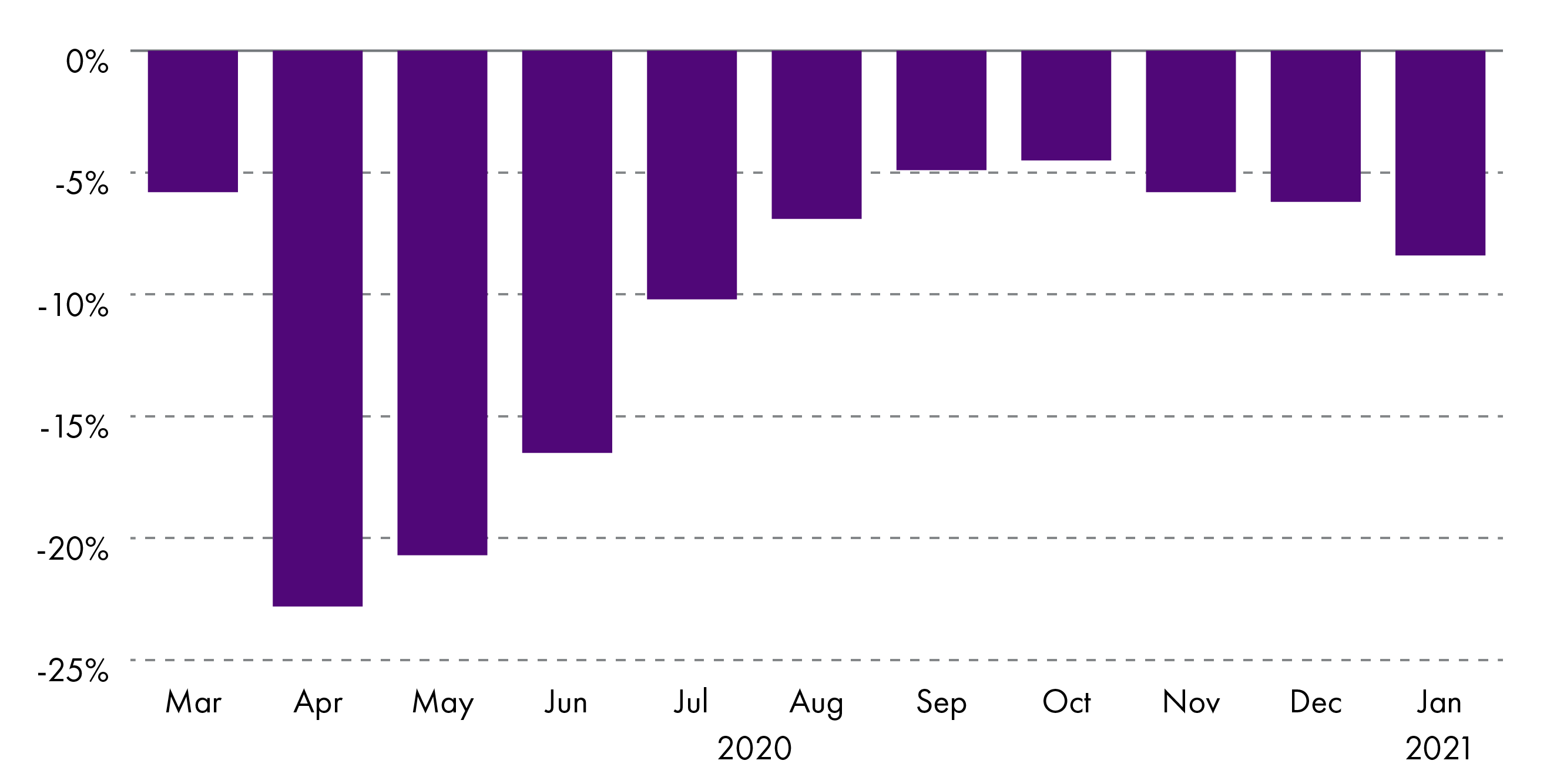
At its low point, the Scottish economy took a near 25% hit to economic activity compared to pre-pandemic levels and 736,000 workers were furloughed. And while the economic figures have recovered somewhat, not all parts of the economy have been impacted equally. Those parts of the economy that depend on social interaction - such as tourism, the night-time economy, arts and culture – have yet to see any sort of notable recovery. For more on the impact on the business base in Scotland, see this chapter.
The impact of the pandemic will be felt on and shape our economy for years to come, touching on issues such as: new business models; changed consumer behaviours, accelerated digitalisation, increased debt levels, youth unemployment, missed human capital and educational opportunities, altered international travel flows, and how we use our urban areas – to name but a few.
Fiscal interventions to mitigate the economic effects of the crisis have also been seen throughout the world, and the UK has been no different.
In 2020-21, £9.7 billion was added in Barnett consequentials to the Scottish spending envelope for COVID mitigation measures. Significant additional COVID resources (£2.3 billion) have also been allocated for the current financial year. £1.1 billion has been carried forward from 2020-21 and a further £1.2 billion allocation has been made. It is possible this might be supplemented depending on how the situation evolves.
The UK Chancellor has indicated that the current extremely high levels of borrowing and debt are manageable in the short term due to extremely low interest rates. However, there will inevitably come a time when the debt requires to be paid down via tax increases, spending cuts, or a combination of the two.
The fragility of the recovery
If the pandemic has taught us one thing, it is that we live in a small and interdependent world. Countries can close their borders and batten down the hatches, but this cannot entirely mitigate against the global impact of the virus.
The vaccine has brought much cause for optimism and the recovery is likely to feature heavily in Session 6. However, the sustainability of any recovery will also depend on access to the vaccine globally.
The UK vaccine effort has been widely praised but until this is matched in the rest of the world, any recovery will be at risk from variants. This will require cooperation between the UK nations and beyond.
Session 6 will be challenging for newly elected Members as they tackle the scale of the recovery needed. But it will also be a fine balancing act to promote recovery while also keeping potential waves of new variants at bay. We are not out of the woods just yet.
Scrutiny in a climate and nature emergency – engaging with disruptive change
Alexa Morrison, Senior Researcher, Environment
We are living through a climate and nature emergency. Politicians are declaring this the world over, but it has been declared by scientists for many decades.
In 1979, David Attenborough stated:
The fact is that no species has ever had such wholesale control over everything on earth, living or dead, as we now have. That lays upon us, whether we like it or not, an awesome responsibility. In our hands now lies not only our own future, but that of all other living creatures with whom we share the earth.
Life On Earth, 1979, Fontana/Collins
This emergency – the ‘twin crisis’ of climate change and biodiversity loss - hasn’t seen the ‘blue light’ response of COVID-19 or even the 2008 financial crash – but it must, and Parliaments have a key role to play – in scrutinising, legislating and approving government budgets.
Excess greenhouse gases (GHGs) are causing global temperatures to rise and long-term changes to our climate, with impacts including sea level rise, flooding, and heat-waves. The average temperature of the Earth’s surface has risen by around 1°C since the pre-industrial period. 2020 tied with 2016 as the hottest year on record, and 17 of the 18 warmest years on record have occurred in the 21st century. Avoiding further dangerous levels of climate change is essential for human safety, health and wellbeing, economies and natural ecosystems.
The Paris Agreement, agreed under the United Nations Framework Convention on Climate Change, commits countries to limit global temperature rise to well below 2°C above pre-industrial levels and to pursue efforts to limit that to 1.5°C. In November 2021, the spotlight will turn to Glasgow, where the UK is hosting the 26th UN Climate Change Conference, ‘COP26’. For the Scottish Parliament, this brings opportunities to enhance climate scrutiny - learning from international best practice and sharing our learning. For more on COP26, see our dedicated chapter focusing on the conference.
Recent global reviews also highlight the extent of biodiversity decline on land and at sea. The landmark 2019 Intergovernmental Science-Policy Platform on Biodiversity and Ecosystem Services or ‘IPBES review’ issued a stark warning that nature is declining at unprecedented rates, and that most of the 2020 targets under the UN Convention on Biological Diversity will be missed. Goals for 2030, expected to be agreed at the 15th biodiversity COP in China later this year, will only be achieved, the review states, through ‘transformative change’.
The climate and nature scrutiny challenge
Recognition of the need to seriously tackle climate change escalated through Session 5 of the Scottish Parliament – including the declaration of a climate emergency by the Scottish Government in 2019. This was followed by the passing of the Climate Change (Emissions Reduction Targets) (Scotland) Act 2019 which set a target to reduce GHG emissions in Scotland to net zero by 2045. This means that net Scottish emissions must be reduced to at least 100% lower than the baseline year of 1990, through a combination of both reducing emissions and removing GHGs from the atmosphere (see the image below). Between 1990 and 2018, there was a 45.4 % reduction in emissions, with the most significant progress made in energy supply (70.1% reduction). However, many other areas, in particular transport, have stalled.
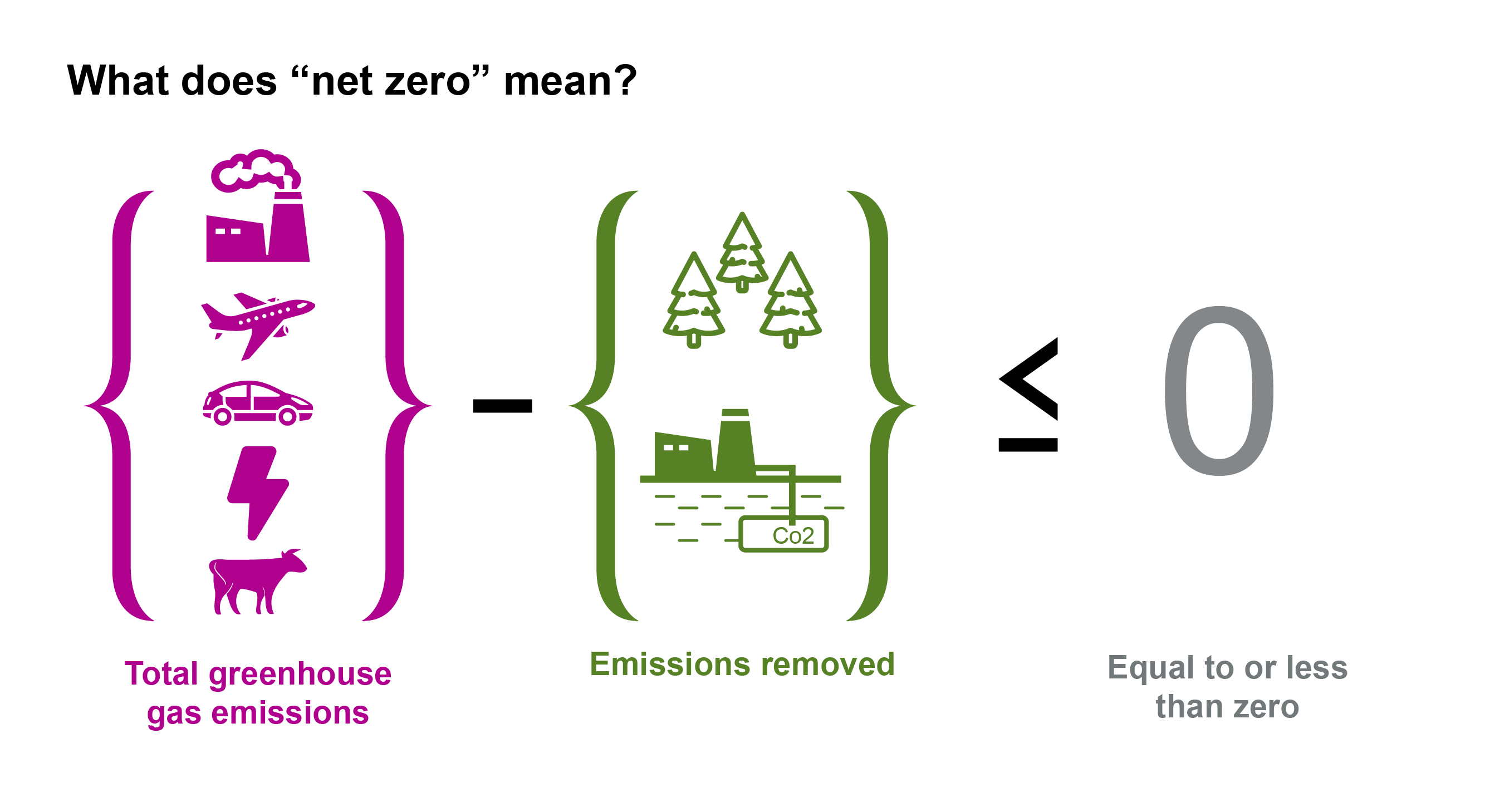
The previous Scottish Government committed to put climate change at the heart of policy-making. With an interim target to reduce emissions by 75% by 2030 now set in law, this Parliamentary session is likely to see climate scrutiny increase as strategies are developed and implemented. The image below shows the emissions reduction anticipated to take place under the current Climate Change Plan. Deep and ‘disruptive’ change is expected across all sectors of the economy including transport, industry, housing, infrastructure, agriculture and land use, and the development of a more circular economy.
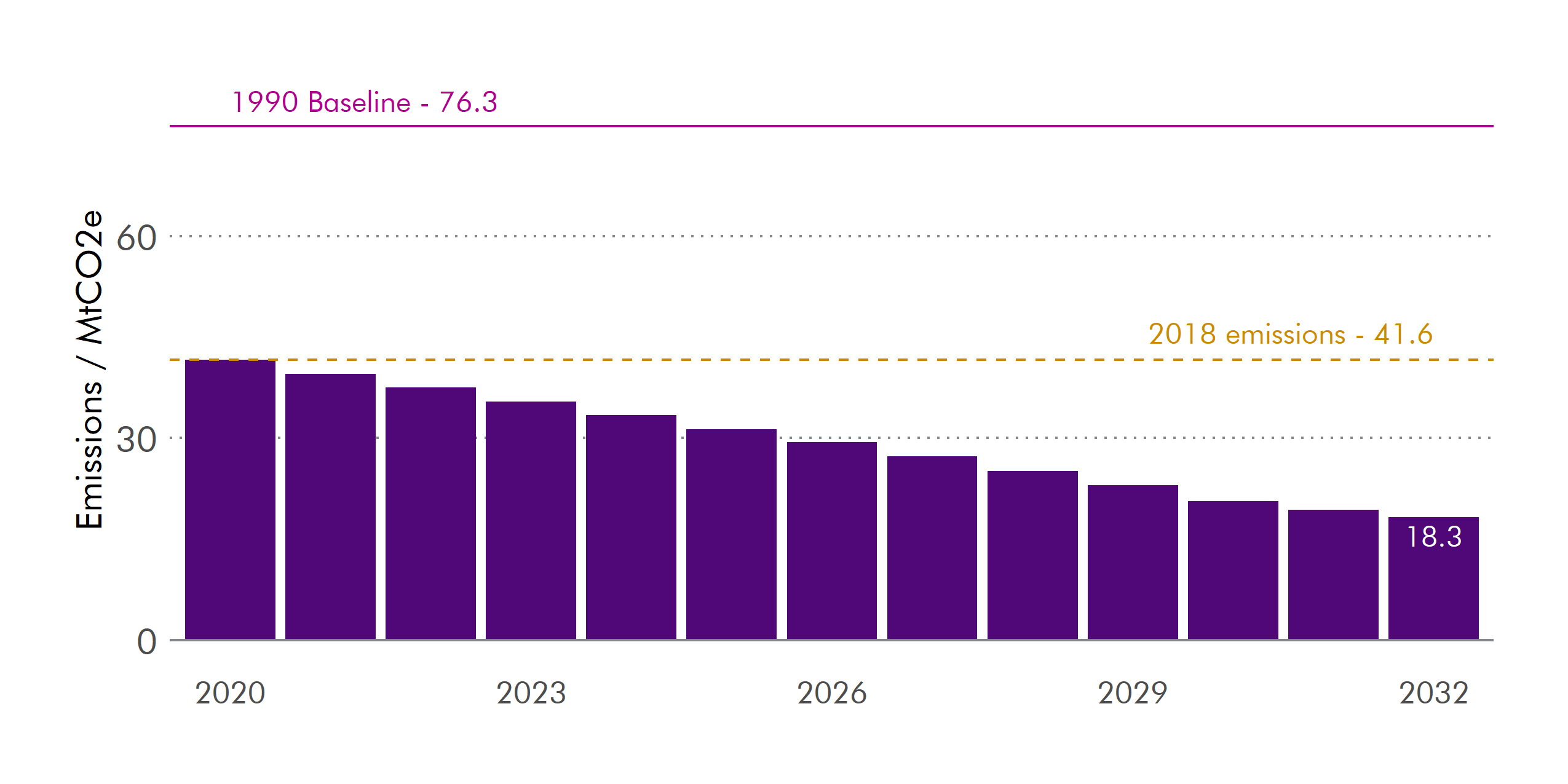
This level of societal change will require coordinated scrutiny and engagement by the Parliament on the implications – including risks and opportunities - for the Scottish people, economy and its environment. Recognising that climate policies have real impacts on livelihoods, the 2019 Scottish Climate Act sought to embed principles of a ‘just transition’ into climate policy-making. The Act sets out the importance of reducing emissions in a way which supports sustainable jobs, and ultimately helps to address inequality and poverty.
Evidence of biodiversity decline and its implications also led the previous Scottish Government to commit in 2019 to a step change in efforts to address it. The 2019 State of Nature in Scotland report mirrored the global picture, illustrating that there has been no let-up in the net loss of nature in Scotland. Nearly half of the country’s species have declined in the last 25 years, and one in nine is threatened with extinction from Great Britain (the scale at which assessments are made) Key pressures include agriculture, climate change, urbanisation, invasive species, upland management and fisheries. Scotland failed to meet 11 of the 20 Aichi biodiversity targets for 2020. The Environment Strategy for Scotland, published in 2020, recognised that the climate and nature crises are intrinsically linked. Climate change is a significant contributor to biodiversity loss and impacts on biodiversity are expected to be significantly greater if warming exceeds 1.5 degrees. Scaling up nature-based solutions to climate change such as peatland restoration and enhancing woodlands, could, on the other side of the coin, be significant in delivering Paris Agreement goals.
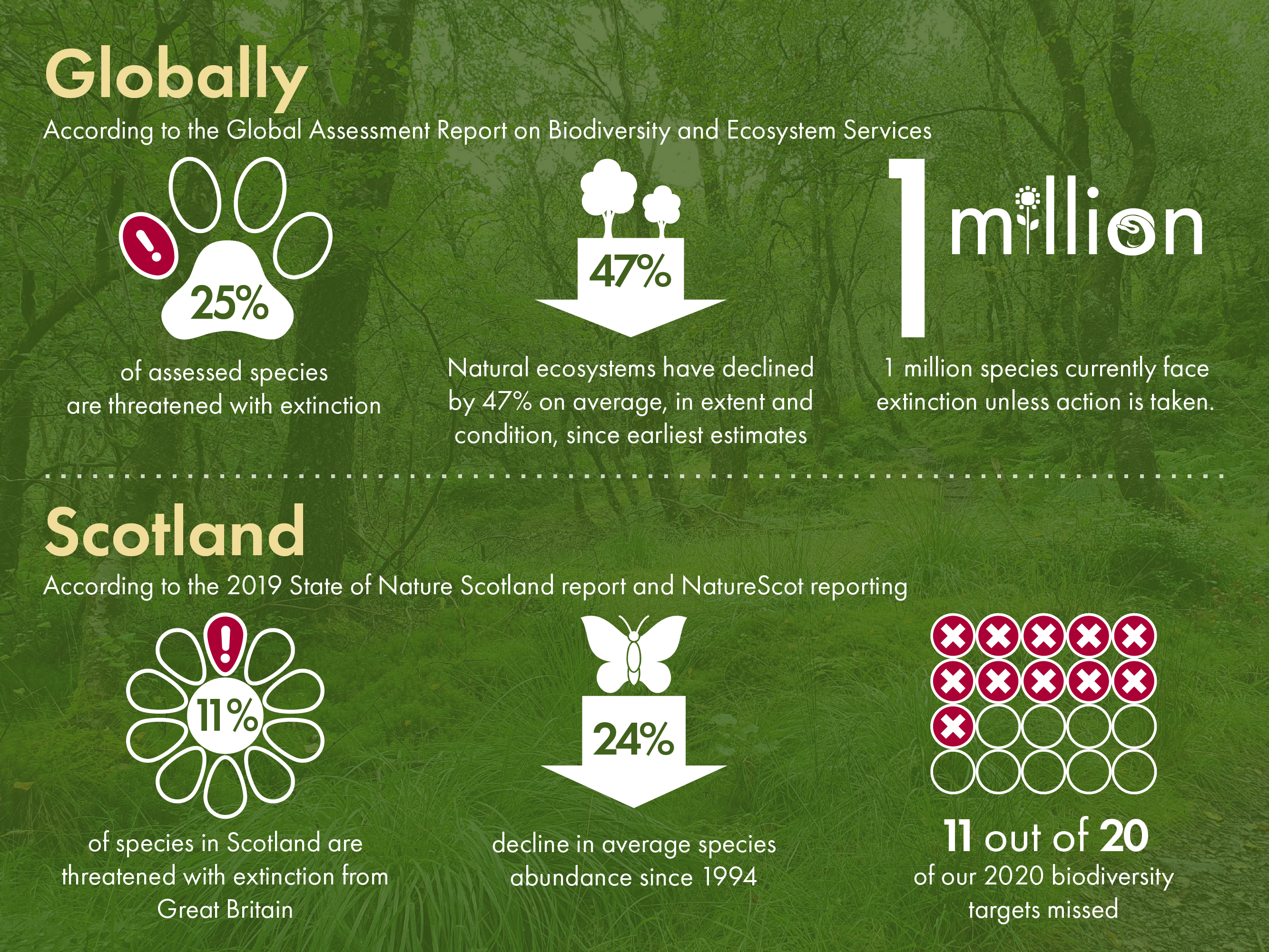
A range of other chapters in the key issues briefing go into different sectors in more detail - for example on Scotland's "blue economy", rural policy and on reducing car travel.
Opportunities for a green recovery – what are we aiming for?
The pandemic has led to calls for a ‘green recovery’ - to achieve dual aims of stimulating our economy whilst transitioning to a low carbon society and protecting the environment. The UK Climate Change Committee has advised the Scottish Government to use climate investments to support recovery, lead a shift in behaviours, and ensure the recovery does not ‘lock-in’ emissions.
The pandemic has also brought some sustainability issues more sharply into public discourse and our day to day lives - the issue of equitable access to green space, for example, or how transport infrastructure should meet changing needs amid Covid-19 restrictions.
EU exit is still part of the ‘setting’ for a climate and nature emergency-response. Brexit has meant a number of significant policy, funding and legal frameworks need to be re-built. For example, the development of post-EU exit approaches to agricultural support, fisheries, or regulating chemicals share a common thread: they matter for the climate and for nature. More information on this is available in the section on Scotland's rural policy and also in the section on Scotland's blue economy.
Looking ahead to other key areas of policy development likely to take place this Parliamentary session, the following could be scrutinised in relation to a green recovery:
How infrastructure investment will support a low carbon, circular economy.
How changes to food policy can contribute to health and sustainability goals.
How economic strategies measure prosperity.
How town centres will be supported to give space to people and nature.
Our sections on infrastructure investment, food policy, a Scottish economic strategy and town centre regeneration cover all these issues in more detail.
Delivering a just transition will not fit neatly within governmental remits, parliamentary committees, and sections of society. Almost every policy area is likely to play a part. Climate ‘governance’ has evolved to recognise this, from the setting of targets and agreement of strategies across governmental remits, through to how those strategies – most significantly Scotland’s Climate Change Plan - are scrutinised in the Scottish Parliament. Governance for nature recovery is less developed in comparison, but there is increasing recognition - internationally and domestically – of the need to ‘mainstream’ the protection of nature.
Parliaments also have a wider role in ensuring Governments deliver on commitments to achieve the UN Sustainable Development Goals (SDGs), which aim to provide a shared blueprint for peace and prosperity for people and the planet. The Scottish Government seeks to implement the SDGs via its National Performance Framework.

The Parliament has committed to establish sustainable development as a scrutiny lens. This involves scrutinising the relationships between social, environmental and economic issues, and identifying joined-up solutions. The Conveners Group Session 5 Legacy Report highlighted that sustainable development is wide-reaching in scope and impact, and that committees must examine their practices to help achieve a step-change in this area. By doing so, this will help the Parliament meet a duty of Scottish public bodies under the Climate Change (Scotland) Act 2009 to act sustainably. There is a lot more about how the Parliament could use the NPF in our chapter titled "your multi-use parliamentary power tool."
The devolution settlement post EU exit and UK relations
Sarah Atherton, Senior Researcher, Constitution
.png)
The UK leaving the European Union (EU) was a seismic constitutional shift. EU exit removed an element of the UK’s constitutional framework which had been in place for nearly 50 years.
The move away from EU membership has brought the devolution settlement into sharp focus for two reasons:
The question of whether competencies previously held by the EU (including in devolved areas) should sit with the UK Parliament or the Scottish Parliament.
The practical and legal changes to the framework of devolution because of EU exit and the approach taken by the UK Government to address the question of competence.
These two issues will be central to much of the work of the Parliament during Session 6. This section provides an overview of the key changes in the devolution framework as a result of EU exit. The consequence of the changes will be felt particularly in policy areas where the EU previously had competence (such as fisheries, agriculture and food).
The devolution settlement
The Scotland Act 1998 (as amended by Scotland Act 2012 and Scotland Act 2016) does not specify matters which are devolved to the Scottish Parliament, but rather matters which are reserved to the UK Parliament. Matters which are not reserved are devolved and the Scottish Parliament has full legislative power (i.e. can pass Acts of Parliament) in these areas.
The UK Parliament retains authority to legislate on any issue, whether devolved or not. By convention - known as the Sewel Convention - the UK Parliament asks for the Scottish Parliament’s consent before making primary legislation (Acts of Parliament) in devolved areas. This consent is not legally binding, meaning that the UK Parliament is able to pass primary legislation in devolved areas even where the Scottish Parliament withholds consent.
Before EU exit, the UK as a member state (and Scotland as a nation of the UK) was required to comply with EU law in many areas. EU law had primacy over areas of domestic law and there were some areas in which the EU alone could legislate and adopt binding acts (known as exclusive competence).
This meant that, before the UK left the EU, the Scottish Parliament could only legislate in areas not reserved to the UK Parliament and in a way that was compatible with EU law.
From 1 January 2021, the need to comply with EU law fell away, meaning there was no longer a requirement for the Scottish Parliament to legislate in a manner compatible with EU law.
Nevertheless, new constitutional arrangements and UK-wide legislation have had an impact on the Scottish Parliament.
Preparation for the UK’s exit from the EU
In preparing for EU exit, the UK and its nations had to manage two things:
ensuring that the laws already in place as a result of EU membership functioned effectively after exit to avoid legal uncertainty in key areas
deciding which legislatures within the UK would gain the powers to change laws or create new laws in areas previously within EU competence.
Given the many UK and Scottish laws as a result of EU membership, there was the potential for these laws to be ineffective once the UK left the EU. To avoid a legislative cliff edge, the UK Government worked to preserve the legal position which existed immediately before 1 January 2021 (the date on which EU law ceased to apply in the UK). This legal continuity was achieved by taking a snapshot of all EU law that applied in the UK and bringing it within the UK's domestic legal framework as a new category of law, known as “retained EU law”.
Changes still needed to be made to retained EU law to ensure that laws in this category functioned effectively by, for example, removing references to EU institutions. This deficiencies correcting exercise saw hundreds of statutory instruments and over 50 Scottish statutory instruments made. A SPICe blog ‘Statute still’ examined the deficiencies exercise in more detail.
The other area which needed to be settled was which legislature would have powers to be able to change or make new laws in areas previously within EU competence. The fact that competencies previously held by the EU were to return to the UK, whilst the need to comply with EU law fell away, meant a potential expansion of the legislative powers of the Scottish Parliament.
However, section 12 of the European Union (Withdrawal) Act 2018 passed by the UK Parliament (the Scottish Parliament withheld consent under the Sewel Convention) amended the Scotland Act 1998, inserting section 30A. Section 30A imposes a restriction on the Scottish Parliament so that it cannot pass an act which modifies retained EU law, nor delegate powers to Scottish Ministers to modify such law, where UK Ministers have made regulations (a form of secondary legislation).
This restriction only applies to areas where the EU had competence immediately before 1 January 2021. As such, section 30A does not shrink the competence of the Scottish Parliament, but it can be used to freeze it so that the Parliament's legislative power is not increased by leaving the EU.
Section 30A ensures that the pre-Brexit parameters of devolved competence are retained for a period of up to five years from the date any regulations are made, while new arrangements (in the form of common frameworks) are developed and implemented.
New constitutional arrangements - common frameworks
EU membership meant that across the UK policies were the same or very similar in many areas. The UK’s exit from the EU saw the potential for significant policy divergence across the UK nations.
Given that possibility, the UK and devolved governments agreed that common frameworks could be used to ensure that, in certain policy areas, the rules and regulations remain consistent across the UK. It is expected that there will be around 24 common frameworks covering areas like animal health and welfare, food labelling and blood safety.
Common frameworks are agreed between governments. Legislatures do not consent to frameworks but scrutinise the decisions of Ministers to enter into them. A SPICe paper on common frameworks explores the topic. The SPICe Post-Brexit hub details all of the work carried out by the Scottish Parliament on frameworks.
As a result of frameworks, intergovernmental relations may assume greater importance through Session 6.
Key legislation
The European Union (Withdrawal Agreement) Act 2020 gives UK and Scottish Ministers new powers in devolved areas that go beyond correcting deficiencies.
These powers have been conferred concurrently, meaning that either UK Ministers or Scottish Ministers can act. The effect of Ministers acting may be to change policy.
The Scottish Parliament has agreed a protocol with the Scottish Government on the scrutiny of any UK statutory instruments made under the European Union (Withdrawal Agreement) Act 2020 and some other Brexit related legislation.
There are two additional pieces of Brexit related legislation which will likely assume central importance in Session 6.
Part 1 of the UK Withdrawal from the European Union (Continuity) (Scotland) Act 2021 enables Scottish Ministers to keep devolved law aligned with EU law.
The Act does not mean that Scots law has to align with EU law, but it does allow Scottish Ministers to make regulations to keep pace where they feel it is appropriate. It will be the Parliament’s responsibility to scrutinise the use of this keeping pace power by Scottish Ministers.
Further information is available in the SPICe briefing on the UK Withdrawal from the European Union (Continuity) (Scotland) Bill.
The United Kingdom Internal Market Act 2020 establishes two market access principles to protect the flow of goods and services in the UK’s internal market:
the principle of mutual recognition means goods and services which can be sold lawfully in one nation of the UK can be sold in any other nation of the UK
the principle of non-discrimination means authorities across the UK cannot discriminate against goods and service providers from another part of the UK.
The market access principles mean that legislation passed by the Scottish Parliament will apply to producers and service providers in Scotland but will have no effect in relation to goods or services coming into Scotland from elsewhere in the UK.
UK Government Ministers have the power to disapply the market access principles where the four governments of the UK have agreed that divergence is acceptable through the common frameworks process.
The provisions of the United Kingdom Internal Market Act may have a significant impact on the exercise of powers by the devolved legislatures. The market access principles have the potential to undermine devolved competence. Further information on the UK Internal Market Act 2020 can be found in a SPICe blog.
Challenges for Session 6
The Session 6 parliament will have to grapple with the complexities of new constitutional arrangements and the practical limits they may place on the Scottish Parliament even in areas over which it has competence.
Health and Social Care integration: are the joins still visible?
Anne Jepson, Senior Researcher, Health and Social Care
This briefing will provide a short overview of the major structural change to health services in Scotland over the last few years. It will highlight some of the ongoing challenges which will continue into the next session, as well as the impact of the COVID-19 pandemic on accelerating reform of the social care sector.
The Scottish Government says that the integration of health and social care has been the ‘most significant change to health and social care services in Scotland since the creation of the NHS’. Whether this has been the experience of staff and the public remains, for the time being, moot.
What has integration entailed: the theory and legislation?
Throughout Session 5, the integration project dominated the work of the Health and Sport Committee, as the public bodies involved sought to implement major shifts in focus and culture from hospital to community-based care.
The Public Bodies (Joint Working)(Scotland) Act 2014 (“the Act”) received Royal Assent in April 2014. Health boards and local authorities were then given two years to put integration arrangements in place. Somewhat confusingly, IAs are also known as Integration Joint Boards (IJBs) and Health and Social Care Partnerships (HSCPs). Each IA is partnered with one of the fourteen health boards.
The aim was to create a new governance structure that brings together health boards and local authorities, without replacing either. The ambition is to embed joint working. This has been done by giving IAs responsibility for directing an £8 billion + budget (allocated from both local authorities and the NHS). The IAs are to design, commission and create services that meet the health and care needs of people at a local level, designed with the person at the centre.
What led up to integration?
The Act was the culmination of years of effort: of different programmes and of legislation, to encourage partnership working between the NHS, social work and the third sector, that had been running since the Scottish Parliament came into being.
Audit Scotland published a timeline of these pieces of work, since 1999, in their short guide to the integration of health and social care services 2018.
What and where are the new bodies?
The 31 new IAs generally map onto local authority areas. However, Clackmannanshire and Stirling councils combined to create a single IA. NHS Highland and the Highland Council opted for a slightly different model.
All IAs are responsible for the governance and resourcing (via the directing of delegated budgets) of social care, primary and community healthcare and emergency hospital care for adults, as well as discharge. Some areas have also integrated additional services such as children’s services and criminal justice. Their reach across local services then is huge, and their existence offers substantial potential for change in how services are designed and delivered.
So far so good. How well has integration progressed?
Throughout Session 5, frustration and concern were expressed by both the Health and Sport Committee, and Audit Scotland, about the pace of change and transformation:
Since 2016/17, integration authority annual budgets have totalled almost £9 billion, with little evidence of a shift in spending from hospital to community care ... Issues noted in integration authority budget processes include delays in agreement, lack of transparency, relationship issues, and inability to make medium or long-term plans.
(source: SPICe Briefing: Health and social care integration: spending and performance update)
The NHS has become recognisable by increasingly enormous physical buildings, where all sick people are cured. The move is to a patchwork landscape of community-based services that focus on the prevention of sickness, the promotion of wellbeing and independent and supported living. This should reduce, in theory, demand on the hospital sector.
The chart below shows how little budgets have changed between hospital and community care, with hospital spending accounting for well over half the total budget. These modest changes continue in the latest figures, although in 2019-20:
The £811m increase in expenditure was not shared evenly across the different sectors. Of the total increase, £499m (62%) was spent on hospital services, £203m (25%) on community services and £99m (12%) on family health services.
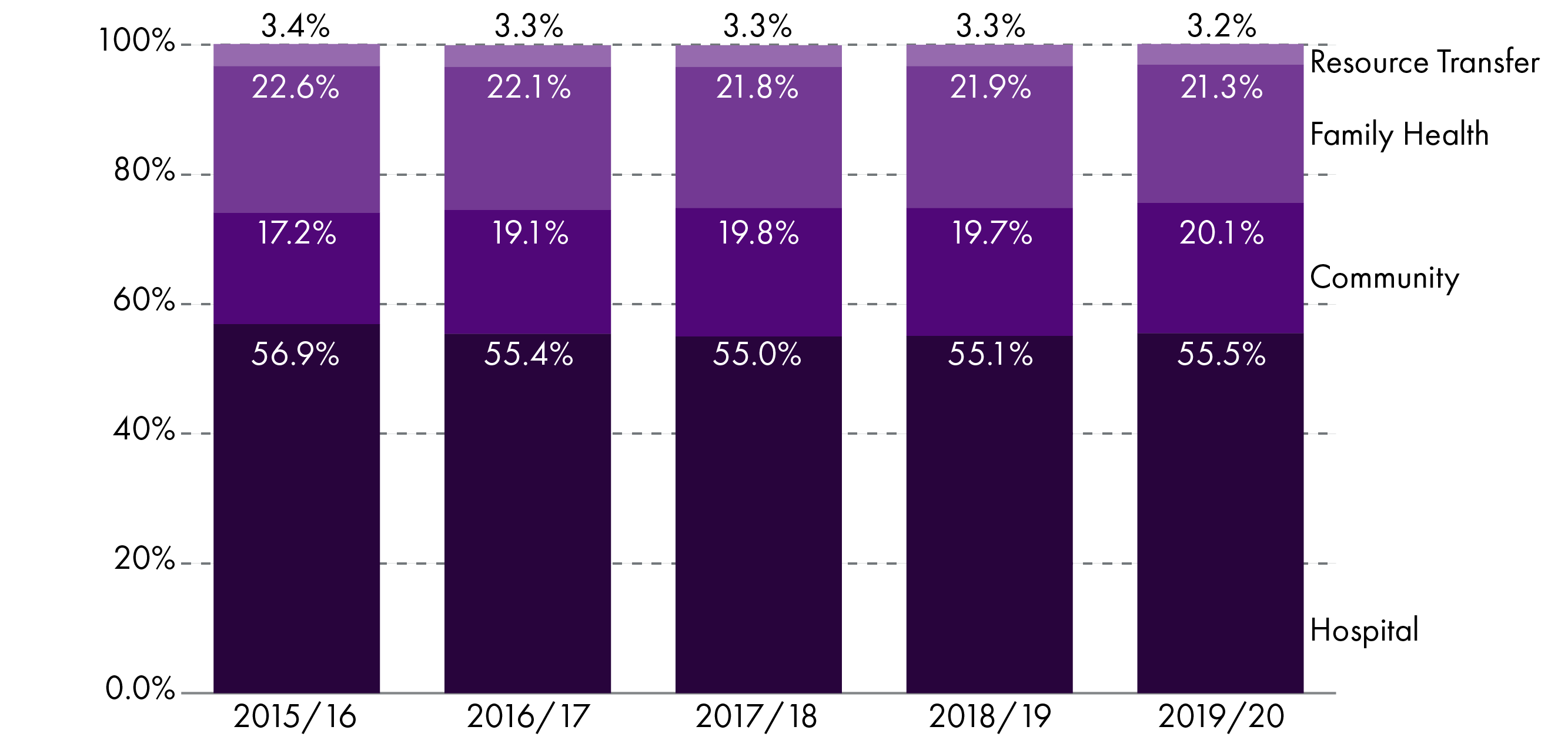
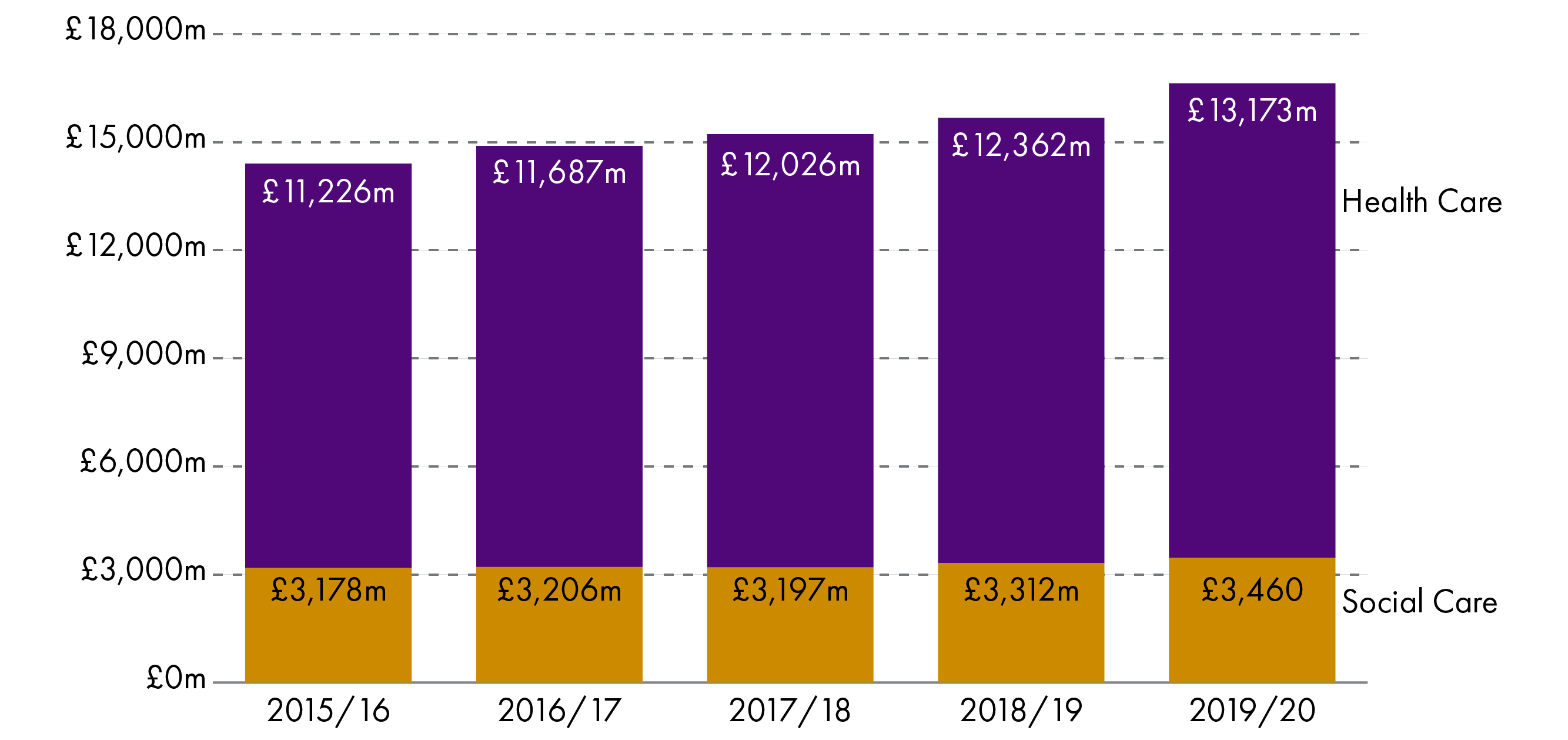
The Act, along with other legislation, such as Self-directed Support (Scotland) Act 2013, was to underpin an approach to health and social care that shared a focus on care and support being delivered as close to home as possible and of maintaining someone’s independence for as long as possible. Emergency care was to be the last resort and delayed discharge would be addressed by making integration authorities responsible for discharge arrangements from hospital.
The government used the Ministerial Strategic Group (MSG) to provide added momentum to integration, and published an update on progress in February 2019. However, the most recent meeting of the group was in January 2020. Will the momentum, post pandemic, be picked up by government and integration authorities?
Key issues for social care
To discuss social care under a different heading sort of undermines the point of the integration project. However, the COVID-19 pandemic highlighted the many disparities between the NHS and social care, and some were considered by the Health and Sport Committee. The most highlighted outcome from these disparities was the high number of deaths in care homes during the pandemic (around a third of the total number). The then Cabinet Secretary for Health and Sport, Jeane Freeman, acknowledged that ministers did not fully understand the needs of the care sector.
Evidence to the Health and Sport Committee stressed that care homes are homes first, and not health facilities. (For how the pandemic impacted the NHS see NHS in Scotland 2020 Report, Audit Scotland). And for more on the wider impact of the pandemic see our first overarching theme in this briefing.
The underlying structures and operation of both health and social care have not changed, despite the legislation and the best efforts of integration authorities to commission services that fulfil the principles of integration.
So, for example, while NHS services remain free at the point of use in most circumstances, social care is in large part means-tested – people pay their accommodation costs, which are hundreds of pounds a week. The realisation of the costs involved shock many families, just at the point when they are in crisis and need care services.
The Scottish Government were conducting a major review of social care before the COVID-19 pandemic hit. The challenges in social care accelerated focus and action and an independent review of adult social care was commissioned, led by Derek Feeley. It was published in January 2021. This called for major reform of social care, which features in a number of party manifestos.
Session 6 will see tension between dealing with the backlog of hospital treatment, and the drive of integration to focus on prevention and community-based interventions. To allow better scrutiny of local and national innovation, a means of assessing and comparing outcomes for individuals is needed. Audit Scotland lays out the challenges of planning for outcomes, and particularly planning and assessing performance against the National Performance Framework.
Mental health and COVID-19
Lizzy Burgess , Senior Researcher, Health and Social Care
Prior to the COVID-19 pandemic there was already high and increasing demand for mental health services in Scotland. This has been exacerbated by COVID-19. How this demand is identified and addressed will be of key interest in Session 6 and will impact on the work across all portfolios. This key issue is linked to COVID-19 recovery and expands on our overarching theme on the topic.
The COVID-19 pandemic and associated restrictions have had a significant impact on the mental wellbeing of many people in Scotland. This has varied across the population and some groups have been more negatively affected than others.
Impact of COVID-19 infection on mental health
Severe COVID-19 infection has been associated with poorer mental health. A report for the Scottish Government by Dr Nadine Cossette, found that up to one-third of COVID-19 patients admitted to hospital develop serious mental health consequences, including depression, anxiety, Post Traumatic Stress Disorder (PTSD), and cognitive problems.
In March 2021, the Scottish Government announced it was setting up a network of mental health clinicians to support people hospitalised with COVID-19.
Long COVID (a syndrome associated with COVID-19 infection that can persist for 12 weeks or more) is associated with reductions in mental wellbeing and can include symptoms of depression and anxiety. The Scottish Government has partnered with Chest Heart and Stroke Scotland to develop its Long COVID Support Service. In England a network of long COVID assessment centres has been established.
Impact of COVID-19 restrictions on mental health
The social restrictions and economic consequences linked to COVID-19 have also had a negative impact on many people’s mental health. For some people this has been a result of:
increased isolation and loneliness
income and job worries
fear of catching COVID-19
worries about childcare and caring responsibilities
fear of eviction or home repossession
disruption to education
higher levels of stress in cramped or confined housing.
In July and August 2020 the tracking the impact of the COVID-19 pandemic on mental health and wellbeing study found that:
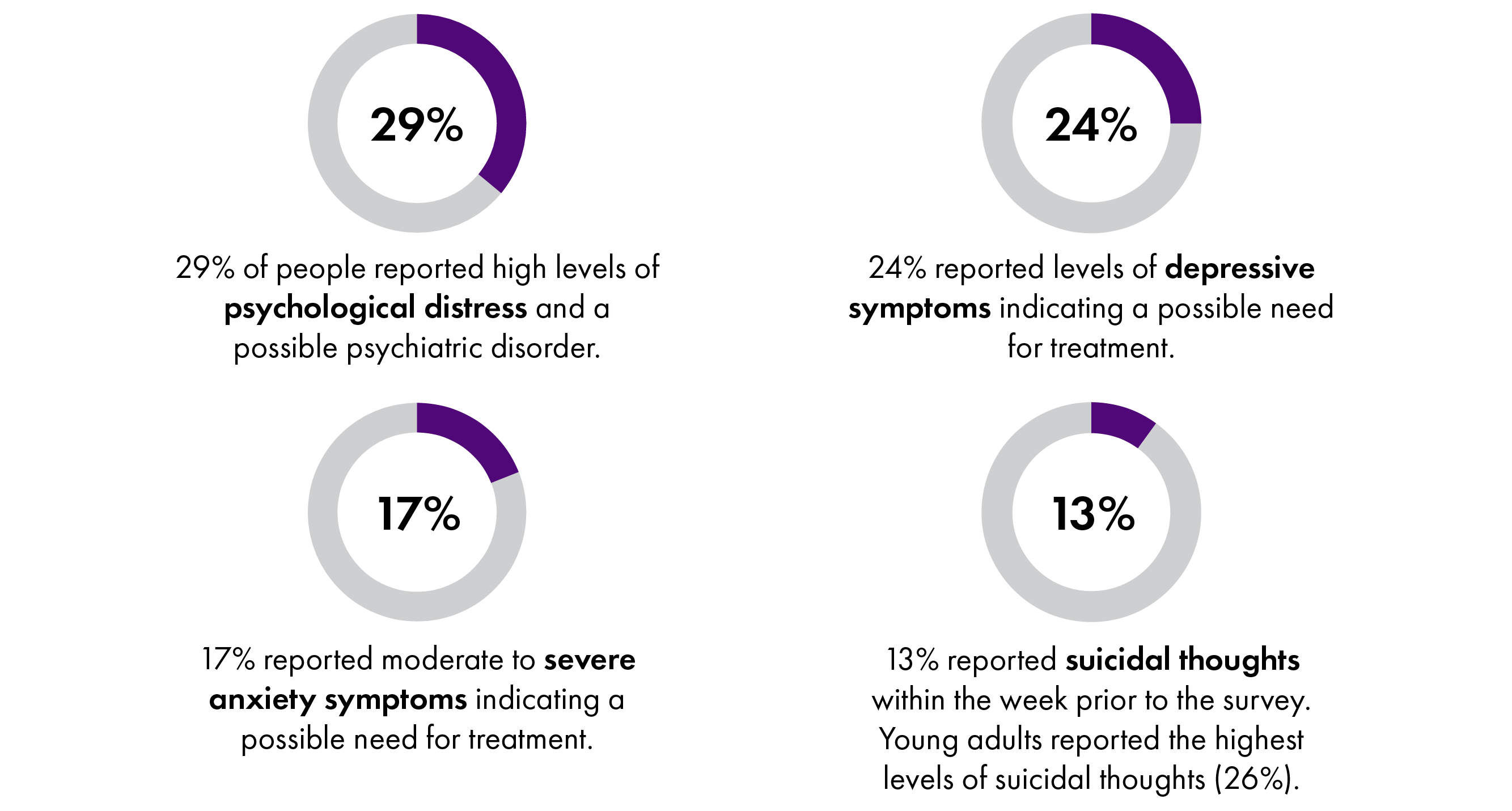
Some groups, including young adults, women, people with pre-existing mental health and those in lower socio-economic groups reported higher levels of mental distress.
The COVID-19 pandemic has widened mental health inequalities. The groups that had the poorest mental health pre-COVID-19 have experienced the largest deterioration. The groups that have been found to be most affected are women and young adults, people from deprived areas and people with low incomes.
The Scottish Government has established an Equality and Human Rights Forum group that will inform policy development and implementation through consultation and representation.
Children and young people have also seen significant mental health impacts resulting from factors including closure of schools and nurseries, problems arising from home schooling and care, reduced opportunity to stay active and socialise with peers. Many older children have issues with mental wellbeing, are anxious about COVID-19, family income, exam pressure and employment prospects.
There has also been a focus on the mental health of healthcare workers, with high levels of anxiety, depression and PTSD identified in staff working with people infected with COVID-19. The Scottish Government has announced funding to provide mental health support for health and social care staff.
Impact of COVID-19 restrictions on the delivery of mental health services
Prior to the pandemic, mental health services in Scotland were already under significant pressure. COVID-19 resulted in restrictions to in-person appointments and closure of support services.
At the start of the pandemic there was a steep drop in the number of referrals to services including Child and Adolescent Mental Health Services (CAMHS) and psychological therapies.
Since May 2020 the numbers increased as services were provided digitally but waiting times have increased. In December 2019, 5.4% of people had been waiting 53 weeks+ for CAMHS. This increased steadily – at the end of December 2020 it was 14%.
At the end of December 2020 there were 11,116 children and young people waiting to start treatment with CAMHS.
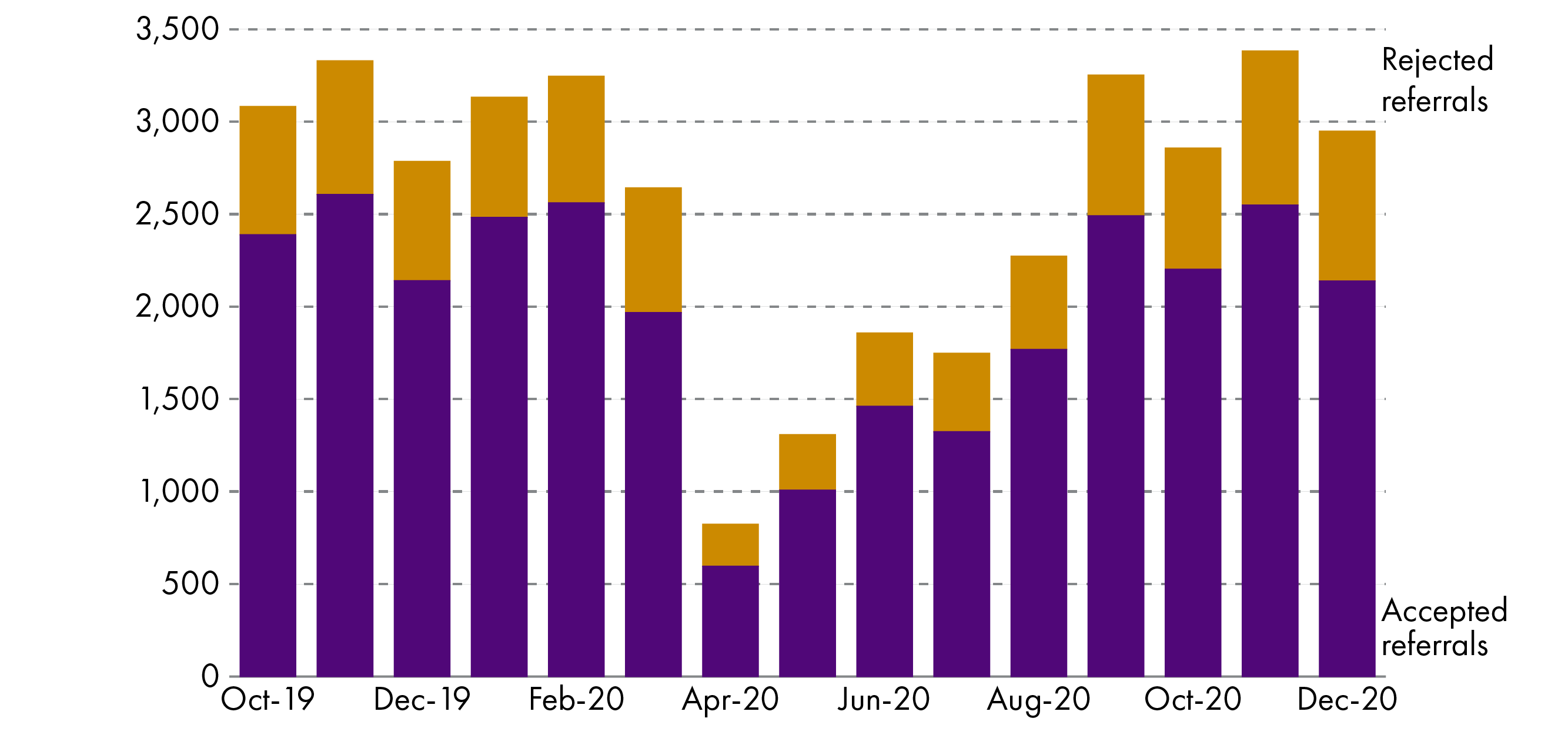
Similarities can be seen with waiting times for treatment with psychological therapies.
GPs serving deprived communities have reported an increase in patients with mental health problems. There has also been an increase in people calling 999 and Breathing Space for help with mental health problems. Calls to Breathing Space increased consistently between September 2020 and January 2021, with January being the busiest month.
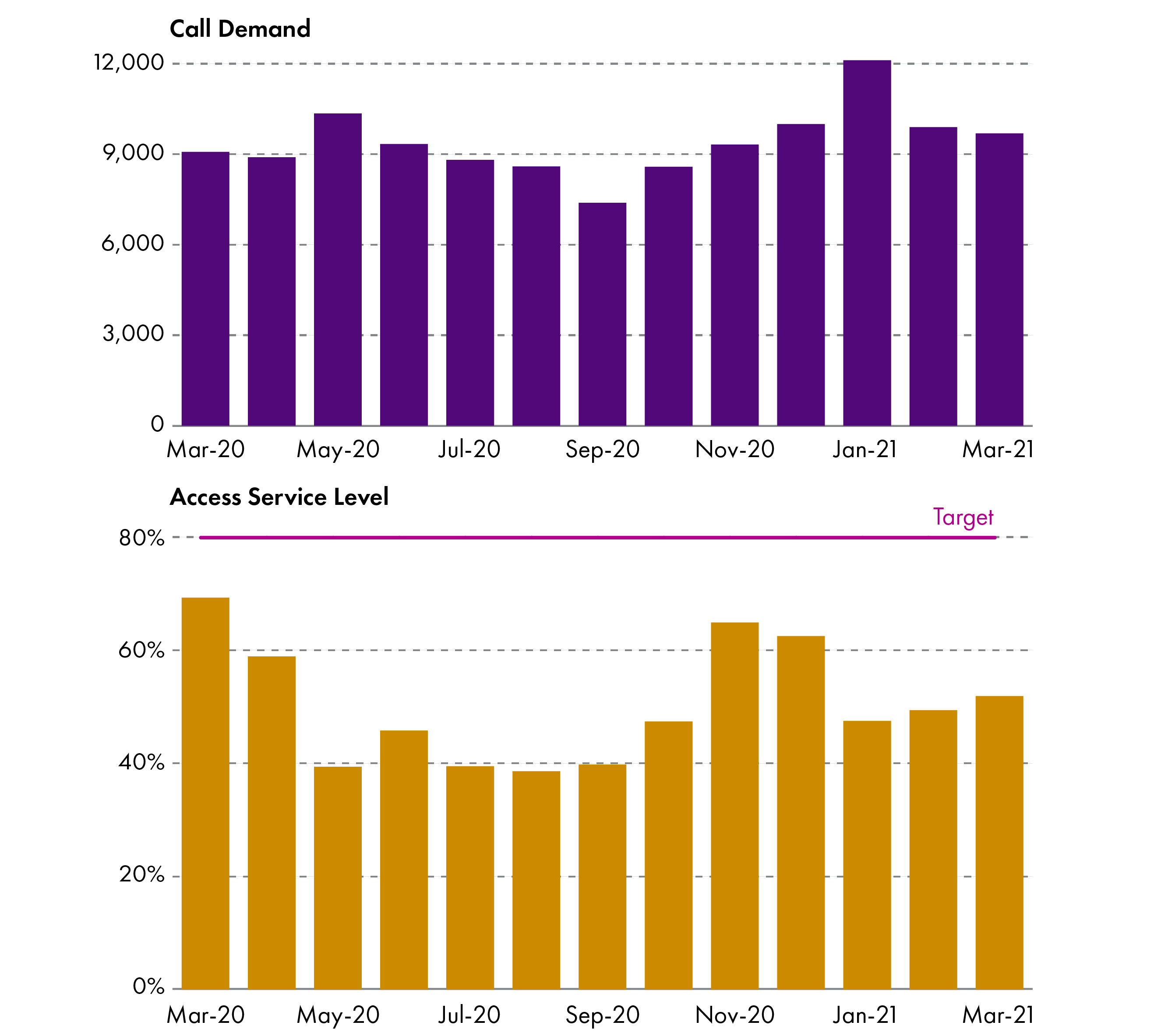
The known and predicted effects of the COVID-19 pandemic mental health and the impact on mental health services was discussed in a think piece by Dr John Mitchell, Principal Medical Officer at the Scottish Government.
Pre-COVID, rising public awareness and demand for mental health treatment was outstripping supply.
Different populations are impacted differently – similar to existing inequalities.
Traumatic experiences for patients, care home residents and staff could lead to mental health issues.
Higher levels of distress at the start of the pandemic will be followed by a possible increase in anxiety and depressive disorders, substance misuse, self-harm and suicide.
It is estimated that there will be an 8% worsening of the incidence of mental health disorders (particularly anxiety and mood disorders and in young people and women).
The challenges will be meeting new demand and remobilising services but there is the opportunity for more individualised approaches.
Cross government work and commitment is needed.
Focus is needed on population wellbeing and mental ill health.
Scottish Government response
The Scottish Government has an overarching 10 year mental health strategy (2017 to 2027) which has 40 actions.
The Scottish Government established a Mental Health Research Advisory Group to inform the development of its mental health policy response to COVID-19. In October 2020, the coronavirus (COVID-19): mental health - transition and recovery plan was published. This details what the Scottish Government has been doing to try to address the mental health challenges. It also highlights a number of commitments in relation to:
whole population mental health
mental health inequality
support for people who are made redundant
children, young people and families
people with long term health conditions and disabilities
older people
Distress Brief Intervention programme and computerised Cognitive Behavioural Therapy
the remobilisation of mental health services.
The Scottish Government has also announced a £120 million Recovery and Renewal Fund for Mental Health, allocated from Barnett COVID-19 consequential funding.
The questions that remain are how the additional mental health needs will be addressed, and how the COVID-19 recovery plan addresses the causes of mental health inequality. The decisions around the improving the wellbeing of people and the delivery and sustainability of mental health services for those who require them will be a key issue which will impact all portfolio areas throughout Session 6 and beyond.
For a further discussion of the direct and indirect health impacts of COVID-19 see the SPICe briefing Health Inequalities and COVID-19 in Scotland.
Gender Recognition Act Reform
Nicki Georghiou, Senior Researcher, Equalities and Human Rights
As SPICe highlighted in the Key Issues briefing for Session 5, each of the five main parties referred to a review of gender recognition law in their manifestos for the 2016 election. By the end of Session 5, there had been two Scottish Government consultations on reforms to the Gender Recognition Act 2004 (GRA), but no legislative action.
However, the potential impact of gender recognition on women – and specifically the move to reform the process to one based on self-declaration – was debated in other contexts, including:
Scottish census, which for the first time would include a voluntary question on trans status. However, there was debate on whether trans people should be able to answer the sex question based on self-identification, or whether this would skew the census data. A recent high court ruling for the census in England and Wales stated that the sex question must be based on legal sex, where individuals answer the question based on their birth certificate or gender recognition certificate.
Gender Representation on Public Boards (Scotland) Act 2018, in which trans women are included in the definition of women. This was challenged in a judicial review with the Scottish Government being found to have acted lawfully.
Hate Crime and Public Order (Scotland) Bill, and concerns that it could criminalise speech that some find offensive.
This time round, the Scottish Parliament manifestos of four of the five main parties (SNP, Scottish Liberal Democrats, Scottish Greens and Scottish Labour) referred to reform of gender recognition law. Scrutiny of reform proposals is therefore likely to loom large in the new session. So, what has happened on the reform of the GRA in Scotland?
What is the current law for gender recognition?
The GRA is UK wide, but is a devolved matter. It provides a way for trans people, aged 18 or older, to apply for legal recognition in their acquired gender. The Gender Recognition Panel makes decisions on the issuing gender recognition certifications (GRCs) and must be satisfied that the applicant:
has provided medical evidence of gender dysphoria
has been living in their acquired gender for two years.
The applicant must make a statutory declaration that they intend to continue to do so for the rest of their life.
There is no requirement under the GRA for an applicant to undergo surgery or hormone therapy.
Once someone has been successful in changing their gender they will be issued with a GRC and their legal sex changes.
To date, 5,583 people have legally changed their sex in the UK through the gender recognition process since 2005.
.png)
The Gender Identity Research and Education Society has estimated the trans population to be between 0.6% and 1% of the population, while the UK Government estimated the trans population to be between 0.35% and 1% (see Annexe E of the UK Government’s consultation on GRA reform).
What did the Scottish Government propose to change?
The Scottish Government first consulted on a review of the Gender Recognition Act 2004 in 2017.
Its view was that applicants for legal gender recognition should no longer need medical evidence or evidence living in their acquired gender for a defined period. In addition, the minimum age should be reduced to 16. It proposed to bring forward legislation to introduce a self-declaration system for legal gender recognition. The consultation also sought views on the recognition of non-binary people.
What did the responses say?
A consultation analysis was published in November 2018. There were 15,697 responses, 15,532 from the public and 165 from groups or organisations. A majority of respondents, around 60%, agreed with:
the proposal to introduce a self-declaratory system for legal gender recognition
the minimum age should be reduced to 16
the recognition of non-binary people.
Those in support of the proposal for a system of self-declaration of gender recognition made the following points:
Gender identity is a personal matter, and gender recognition is sought following thoughtful consideration by people who know their own mind.
The existing system can be complex, intrusive and distressing and act as a barrier to people who wish to change their gender.
Those not in favour frequently stated that:
It could pose a threat to safety in women only spaces (such as toilets, changing rooms, refuges and hospital wards), being open to abuse by men who wish to gain access.
It could undermine measures aimed at promoting female representation by allowing trans women to take up places on all-women short lists, on public boards, or awards.
Why was reform delayed?
On 20 June 2019, the Cabinet Secretary for Social Security and Older People made a statement in the Scottish Parliament. She said that despite support for reform, additional issues had been raised since the consultation, and sought to build consensus on the way forward.
Commitments were made to:
Develop guidance to support the collective realisation of both women’s and trans rights. This was due for publication summer 2020 but has been delayed by COVID-19 and reprioritisation.
Replace the LGBT Youth Scotland schools’ guidance for supporting transgender young people with guidance from the Scottish Government by the end of 2019. Due to the impact of COVID-19, this guidance will now be published “when all pupils have returned to school, or at the earliest opportunity in the new Parliamentary term”.
Establish a working group to address wider concerns about the disaggregation and use of data by sex and gender. The working group has published draft guidance for stakeholder feedback.
The Cabinet Secretary set out plans for a draft bill and announced it would not extend legal gender recognition to non-binary people at this stage. Instead, a working group would be established to identify other ways to improve equality for non-binary people. The work of the group was put on hold due to COVID-19, but was able to restart in February 2021.
Consultation on the draft Gender Recognition Reform Bill
The Scottish Government published its draft bill consultation on 17 December 2019, which ran until 17 March 2020. The proposals included:
Removing the requirement for people to apply to the UK Gender Recognition Panel. Instead, people seeking legal gender recognition would apply to the Registrar General for Scotland.
Removing the requirement to provide medical evidence.
Applicants must have lived in their acquired gender for a minimum of 3 months, and then confirm after a reflection period of 3 months that they wish to proceed.
Applicants would have to confirm that they intend to live permanently in their acquired gender.
Applicants would still be required to submit statutory declarations, made in front of a notary public or a justice of the peace.
It will be a criminal offence to make a false statutory declaration or false application.
Reducing the minimum age of application from 18 to 16.
Why was the draft Bill delayed?
On 1 April 2020 it was announced that the draft Bill, along with a number of other bills, would be delayed due to the impact of COVID-19. Around 17,000 responses have been received. The analysis has been impacted by COVID-19 and the intention is to publish it as ‘soon as practicable’ in the next Parliamentary session, if the administration is returned after the election.
Social Security: completing the (first) project
Camilla Kidner, Senior Researcher, Social Security
By 2025 the programme of social security devolution which started with the Scotland Act 2016 should be complete. This chapter takes a look at what has been done so far and what is still to do.
What has been devolved?
Most carer and disability benefits are devolved along with payments that were made through the social fund, such as funeral expense payments. The Scottish Parliament can create new benefits and top up most reserved benefits. In addition, Scottish Ministers have some, limited, powers over the way Universal Credit is paid.
What has been done so far?
The Social Security (Scotland) Act 2018 provides the framework for creating most Scottish benefits through regulations.
Social Security Scotland is an executive agency set up in 2018. It paid its first benefit – Carer’s Allowance Supplement – that autumn.
Also that year the Social Security Chamber of the First-tier tribunal service was created to hear appeals.
The Social Security Charter, published in January 2019, sets out what people can expect from Scottish social security.
The Scottish Commission for Social Security, established in February 2019, provides independent scrutiny of most social security regulations and the Charter.
In 2021, ‘top-up’ powers were used for the first time to create the Scottish Child Payment.
Throughout, the Scottish Government’s approach is ‘safe and secure transfer’ which means minimal policy differences compared to the Department for Work and Pensions (DWP). The DWP are still administering many benefits on the Scottish Government’s behalf until a Scottish ‘version’ of them can be developed.
So, while the Scottish Government has had financial responsibility for most carer and disability benefits since April 2020, almost all of that spending is still administered by DWP. This should change completely during Session 6.
By the time of the May 2021 election, Social Security Scotland directly administered around 350,000 cases across eight separate benefits with a combined value of around £160 million.
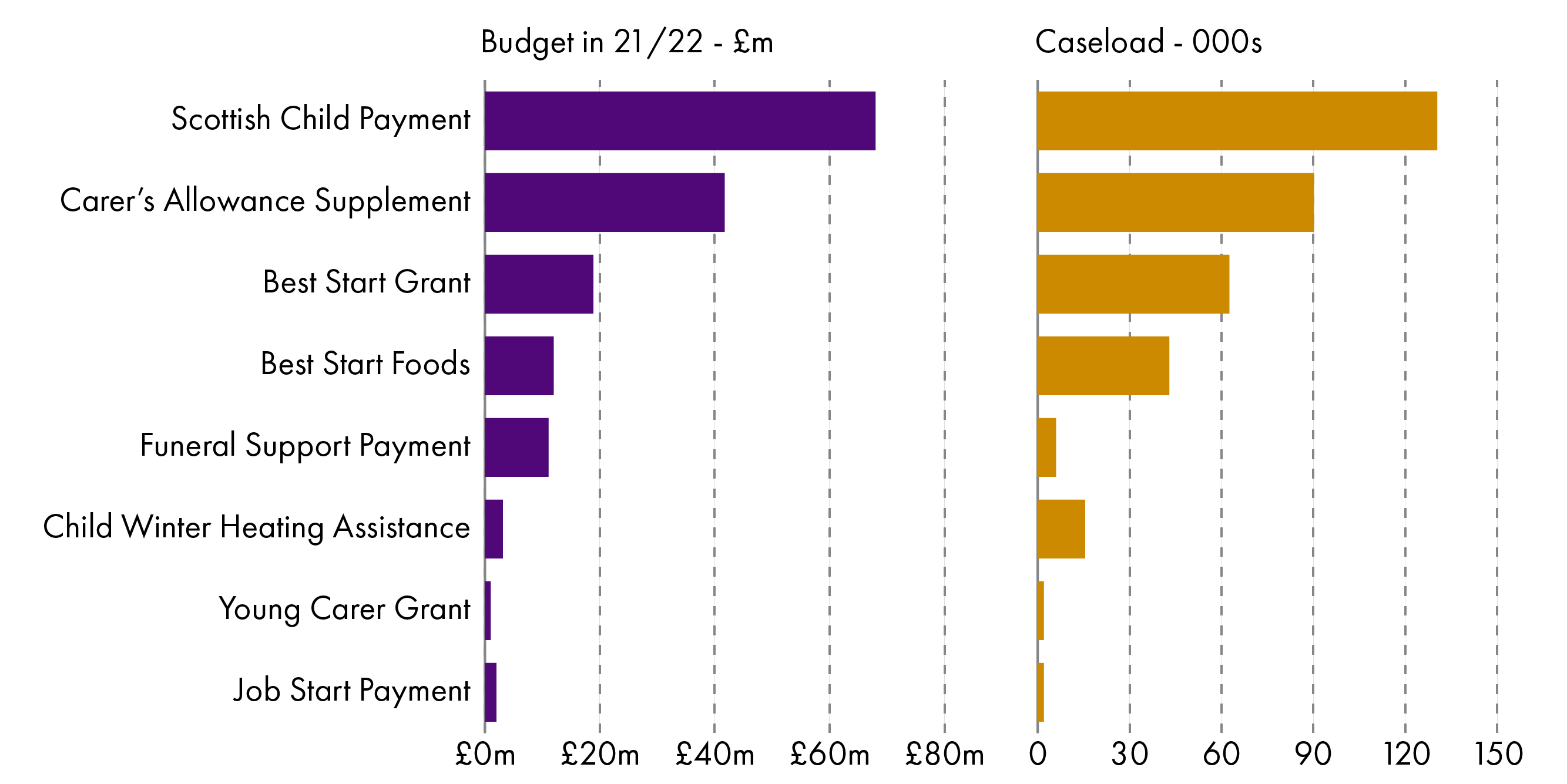
What still has to be done?
The really big devolved benefits (both in terms of caseload and spending) will transfer from the DWP to Social Security Scotland between summer 2021 and 2025. Progress has been delayed – most recently because of COVID-19. The timeline shows the dates known so far.

The regulations for Child Disability Payment were passed in March 2021. A pilot will start in July with national roll-out from November.
The consultation on the regulations for Adult Disability Payment closed in March. A pilot will start in spring 2022, with national roll-out that summer.
The Scottish Child Payment is due to be extended to under 16s by the end of 2022.
There are still substantial gaps in the timetable with no dates yet for the launch of Scottish ‘versions’ of:
Attendance Allowance
Carer’s Allowance
Industrial Injuries Disablement Benefits
Winter Heating Payment
Cold Weather Payment.
Each of these will need substantial regulations to be passed by the Scottish Parliament.
Despite the lack of a detailed timetable, the programme is due to complete by 2025, transforming the scale of Social Security Scotland – from dealing with around £160 million worth of benefits and around 350,000 cases in 2021 to dealing with over £4 billion worth of benefits for nearly two million people by 2025.
Scrutinising this large expansion in Social Security Scotland’s responsibilities and creating ‘Scottish versions’ of the remaining devolved benefits will therefore be key tasks for Session 6.
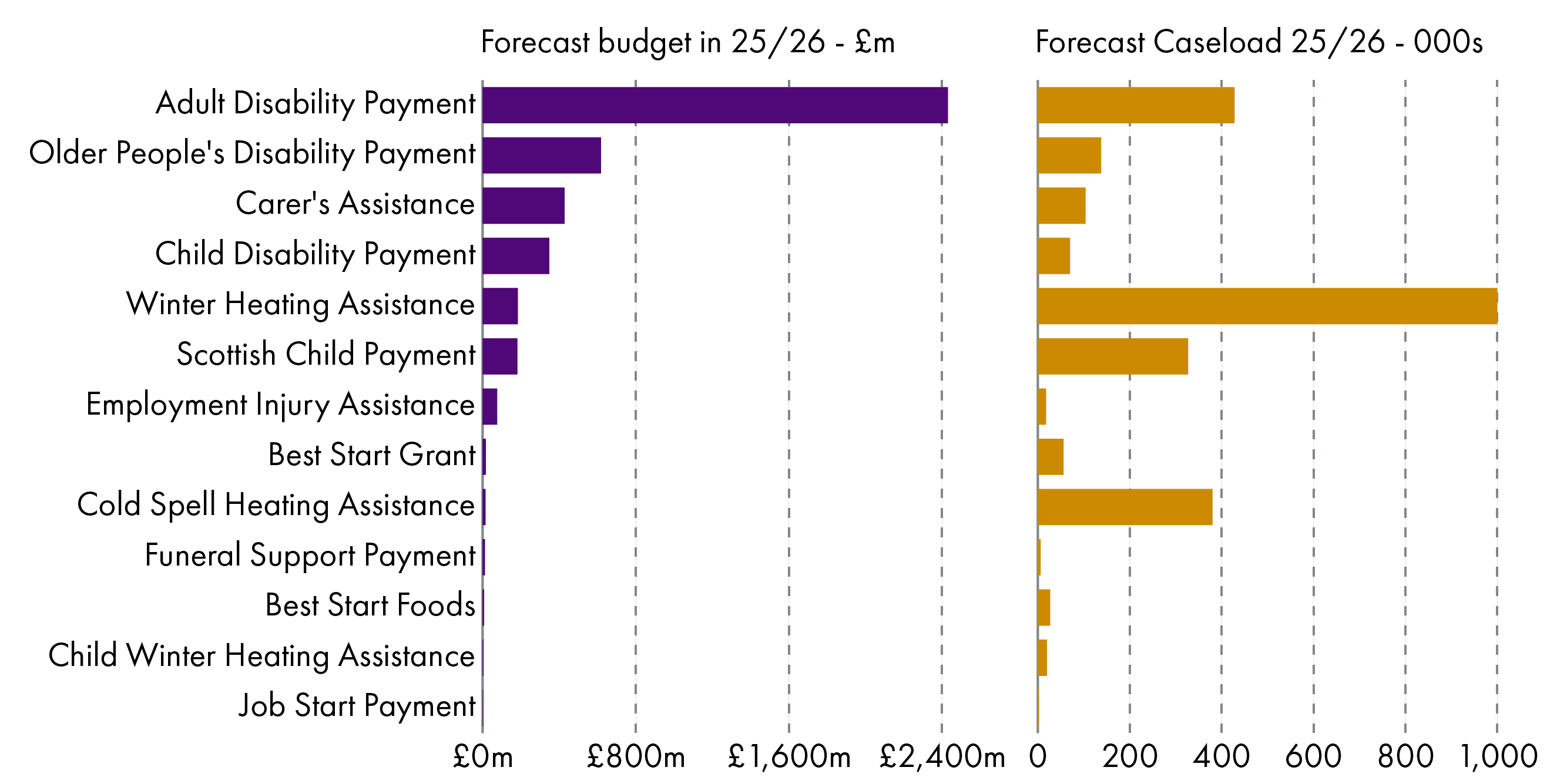
Doing things differently
The initial priority is ‘safe and secure transfer’. However once benefits are safely in place, there is scope to think about further changes. To this end, the Scottish Government has announced an independent review of Adult Disability Payment starting in 2023. The manifesto commitment to start working towards a Minimum Income Guarantee also provides scope for thinking more broadly about Scottish social security.
Budgetary risks: Adult Disability Payment
In 2022 Adult Disability Payment (ADP) will start to replace Personal Independence Payment (PIP). The rules will be almost the same, but the administration and assessment processes are intended to be very different. Because PIP/ADP is a big benefit, even a small policy change could have a large impact on the budget. The Scottish Fiscal Commission will produce costings. However, there could be a high level of uncertainty in costing new policy.
Social security and child poverty
The Scottish Child Payment (SCP) provides £10 per eligible child per week for families on low income benefits. The SNP manifesto includes a commitment to double this to £20 per eligible child per week over the course of Session 6.
The SCP is a key part of the strategy to meet statutory child poverty targets which include reducing relative child poverty to 18% by 2023-24. At the moment child poverty is rising gradually. In 2019-20, 26% of children were in relative poverty.
When it was announced in 2019, the SCP was intended to contribute a three percentage point reduction in relative child poverty.
In 2022 eligibility is due extend from children under six to children under 16. The then Cabinet Secretary expressed concern about whether the DWP would be able to provide data on which children were eligible in time to meet this deadline. In March she told the Scottish Affairs Committee that:
We do not have access to the data for Scottish Child Payment phase 2. We are still awaiting information and I think a level of co-operation that is required for me to feel comfortable that the DWP will work with us speedily enough to allow us to deliver on that.
The UK Minister told the Committee that:
for the older children, that data is not readily available. There is never a situation where we will not share data where we can.
A manifesto commitment to a ‘bridging’ payment to pupils claiming free school meals could capture around half of those entitled to the extended SCP. The SFC forecast 330,000 children aged 6 – 16 will be eligible for SCP, and the bridging payment is estimated to reach ‘up to 170,000’.
Therefore, a key issue for Session 6 will be how successfully SCP affects child poverty.
Conclusion
Session 5 saw the creation of Social Security Scotland, but it will be in Session 6 that it will develop into a truly large scale endeavour. It will become clear whether the agency has achieved ‘safe and secure transfer’ and treats people with ‘dignity and respect’. It is also in Session 6 that the Scottish Child Payment will be judged against the interim poverty targets. Finally, Session 6 offers the opportunity to think more broadly about whether and how Scottish social security ought to differ from DWP benefits.
Minor changes were made to this chapter on 17 May 2021.
A new human rights framework for Scotland
Nicki Georghiou, Senior Researcher, Equalities and Human Rights
The previous Scottish Government announced on Friday 12 March that, subject to the outcome of the election, a new Human Rights Bill will be introduced in Session 6. The aim is to introduce a new human rights framework for Scotland. This is based on recommendations from the National Taskforce for Human Rights Leadership.
The Bill will:
Re-state the rights in the Human Rights Act 1998 (HRA).
Incorporate rights of four United Nations Human Rights treaties into Scots Law, subject to devolved competence, on economic, social and cultural rights, women, disabled people and minority ethnic communities.
And include rights for:
older people
LGBTI people
a healthy environment.
There is no specific UN Treaty on these rights.
Ensuring people have rights sounds positive, but how does it differ from the rights we already have, and why does the Scottish Government think we need a new human rights framework? Why is it likely to be a key issue in the next session of the Parliament?
What rights do we have?
International Human Rights
The modern concept of human rights was developed in the aftermath of the Second World War. The Universal Declaration on Human Rights (UDHR), setting out basic rights and fundamental freedoms, was adopted in 1948 by the newly formed United Nations. It is generally agreed to be the foundation of international human rights law.
Later came the International Covenant on Economic, Social and Cultural Rights (1966), and the International Covenant on Civil and Political Rights (1966).
‘Economic, social and cultural rights’ include, for example, the right to an adequate standard of living, the right to adequate food, and rights at work. For further background, see our SPICe briefing on this topic.
‘Civil and political rights’ include, for example, the right to life, freedom from torture, and freedom of expression.
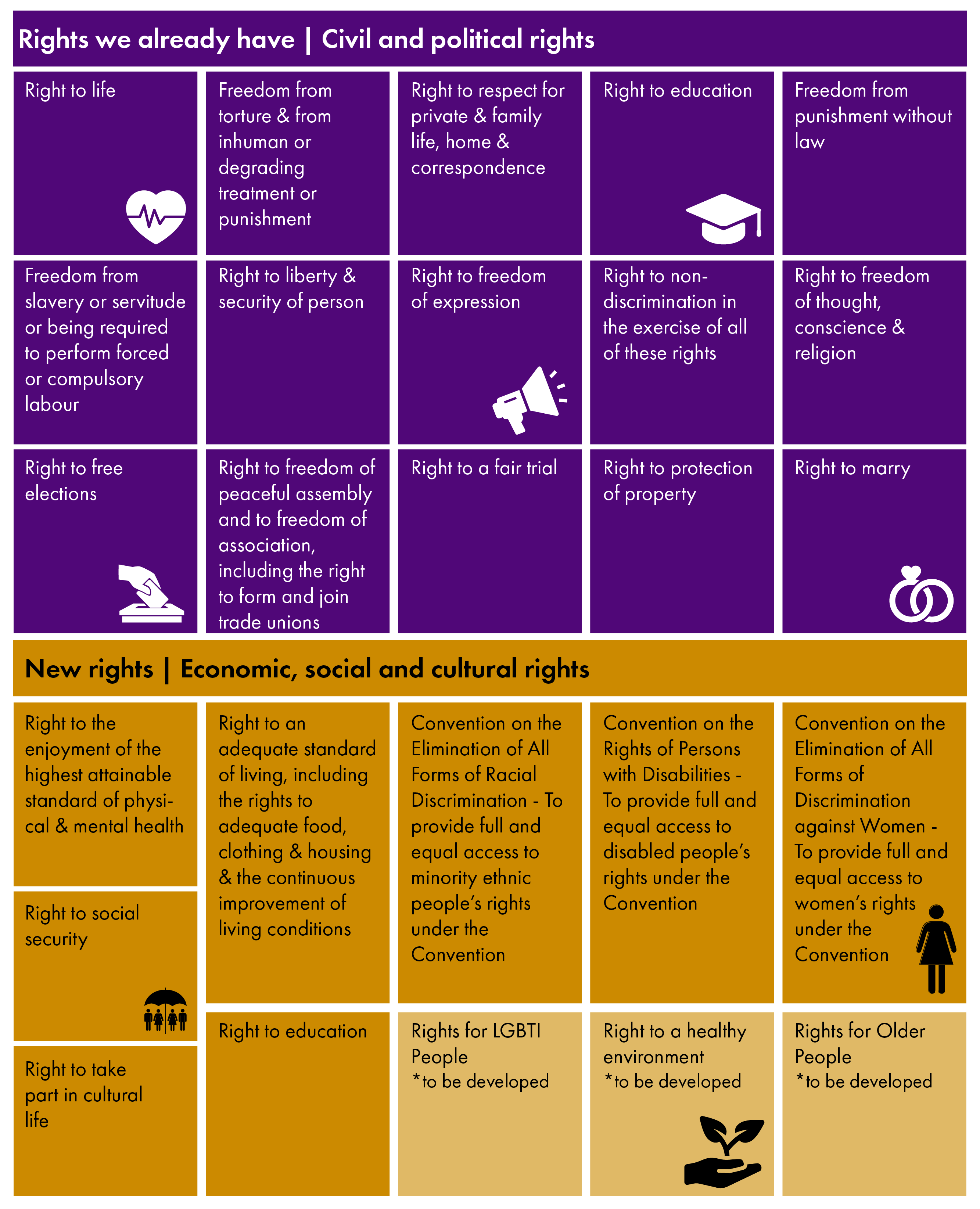
After these UN treaties, there have been numerous international treaties for human rights protections, including those that the Scottish Government proposes to incorporate.
None of the UN treaties currently give individuals legal rights in UK courts. While the UK Government has pledged to make sure its domestic policies comply with the UN treaties, people normally can’t take public bodies to court if their treaty rights are breached in some way.
European Convention on Human Rights
The Council of Europe was formed in 1949. It was set up to promote democracy, human rights and the rule of law in Europe. The Council is separate from the European Union. The UK is one of 47 member states.
The Council adopted the European Convention on Human Rights in 1950, which protects a series of civil and political rights.
Human Rights Act 1998
The European Convention has a different status in UK law to other international human rights treaties. The HRA largely incorporates the rights in this Convention into domestic UK law, giving people rights that are directly enforceable in UK courts. It is unlawful for a public authority to act in a way that is incompatible with a Convention right.
Scotland Act 1998
The Scotland Act 1998 requires that all Scottish Parliament legislation must be compatible with the rights set out in the HRA. If a court finds that an Act of the Scottish Parliament is not compatible with the Convention, it has the power to ‘strike down’ the legislation. This is stronger than the HRA under which courts can issue a ‘declaration of incompatibility’ when it finds that an Act of the UK Parliament is not compatible with the Convention. For further background, see SPICe briefing on Human Rights in Scotland.
Why is this a key issue for session 6?
Impact of Brexit
Now that the UK has left the EU, the EU’s human rights framework (the EU Charter of Fundamental Rights) no longer applies to the UK. The Charter was described by the First Minister’s Advisory Group on Human Rights Leadership (the precursor to the National Taskforce) as one of two pillars of human rights protection in Scotland, the other being the HRA.
However, part of the approach of the proposed human rights framework is to keep “pace through monitoring and adapting future progressive rights developments within the EU, the Council of Europe and the broader international human rights framework”. This will be no small task.
Potential changes to the Human Rights Act
There have also been concerns over proposals by the UK Government to replace the HRA with a British Bill of Rights. This has never materialised. However, the UK Government has consulted on a review of the HRA. A report is due in Summer 2021.
The Scottish Government’s detailed response to the review said that it would “robustly oppose any attempt to weaken or undermine UK commitment to the Convention”, and that any change to the HRA should not be made without the consent of the Scottish Parliament.
Impact and recovery from Covid-19
The Equalities and Human Rights Committee has also identified the significant impacts of economic constraint and the Covid-19 pandemic on equalities and human rights.
How will the new rights work?
A key recommendation is that the Bill would provide access to justice when rights have been breached. What would be the impact for people who have been negatively impacted during the pandemic in terms of housing or access to health services for example? What would be the impact on public authorities with finite resources?
A complex bill
The Taskforce recommends the direct incorporation of four UN treaties and additional rights into one single bill. This builds on the approach used in the UNCRC Bill which incorporates children’s rights into Scots law. The subject matter of the four treaties is broad, including for example, economics, health, housing, culture, and rights for disabled people, women, and minority ethnic people. There will also be additional rights to consider for older people, LGBTI people, and the right to a healthy environment. This is likely to be a complex Bill which impacts on a wide range of policies.
UNCRC Bill and its reference to the Supreme Court
The UNCRC Bill was passed on 16 March. The Bill requires public authorities to comply with the UNCRC. It also gives rights holders the power to go to court to enforce their rights. This is a significant milestone as Scotland will be the first nation in the UK to incorporate the UNCRC.
However, on 24 March the Secretary of State for Scotland wrote to the Deputy First Minister expressing concerns that the Bill would affect the UK Parliament in its power to make laws for Scotland, “which would be contrary to the devolution settlement”. The UK Government has now referred the Bill to the UK Supreme Court for a ruling on this point. Of course, this will delay the Royal Assent of the Bill. If the Court finds that any provision is outside the legislative competence it cannot be submitted for Royal Assent in that unamended form. The Scottish Government could propose that the Bill be reconsidered, or that it be withdrawn, but the Parliament has to agree to do either of those things. The outcome of the case is also likely to have wider implications for the Scottish Government’s plans to incorporate UN human rights treaties into Scots Law.
Violence and harassment experienced by women
Frazer McCallum, Senior Researcher, Criminal Justice

The scale and impact of violence and harassment experienced by women and girls has been highlighted through the work and words of many people – sometimes inspired by the #MeToo movement.
The behaviour involved includes serious criminal offences as well as conduct which, although degrading and damaging, is not criminal.
Some figures from the most recent findings of the Scottish Crime and Justice Survey help to illustrate the scale of the problem. For example, when asked about their experience of various forms of violence and abuse since the age of 16:
21% of women had experienced ‘partner abuse’
6% of women had experienced ‘serious sexual assault’ (e.g. forced sexual activity)
16% of women had experienced ‘less serious sexual assault’ (e.g. unwanted sexual touching).
Wider experience of sexual harassment is explored in a blog by the Scottish Women’s Rights Centre. It notes:
Many women have become so desensitised to so-called ‘low level’ sexual harassment that they would not think to tell anyone about it.
Public attitudes to gender-based abuse are considered in the Scottish Social Attitudes Survey 2019: Attitudes to Violence against Women in Scotland.
In 2014 the Scottish Government and COSLA published Equally Safe: Scotland’s Strategy to Eradicate Violence against Women. It highlighted the need for a broad approach with a focus on prevention.
Although the issue is a wider one, the rest of this briefing focuses on the criminal justice system.
Even with this focus the picture is complex (e.g. including consideration of the approach of the police and prosecution). However, set out below is information on just three areas where debate over the case for further reform of criminal law and procedure is ongoing:
current and possible additional criminal offences
support and protection for complainers/victims in domestic abuse and sexual offence cases
the general requirement for corroboration, the use of juries and the not proven verdict.
The legal provisions outlined are also relevant for male complainers/victims.
Criminal offences
Recent legislation creating, or reforming relevant offences includes the:
Sexual Offences (Scotland) Act 2009 – consolidating much of the existing law on sexual offences as well as seeking to reform and clarify important areas
Abusive Behaviour and Sexual Harm (Scotland) Act 2016 – creating a new offence dealing with non-consensual sharing of intimate images (image-based sexual abuse or ‘revenge porn’)
Domestic Abuse (Scotland) Act 2018 – creating a new offence of domestic abuse against a partner or ex-partner.
In a blog reflecting on the first 12 months of the Domestic Abuse (Scotland) Act being in force, Scottish Women’s Aid referred to it as a “world-leading piece of legislation” but added that:
while we have no doubt that this law has been embraced at a national level, we are convinced that successful implementation is still far off.
Crime involving hatred or prejudice towards people because of their sex is not classed as a hate crime in the same way as crime linked to a range of other characteristics (e.g. race or religion). Whether sex should be treated in the same way as those other characteristics was debated during parliamentary scrutiny of what is now the Hate Crime and Public Order (Scotland) Act 2021.
The 2021 Act will allow the Scottish Government, using secondary legislation, to extend hate crime to cover the characteristic of sex. However, a decision on whether this should happen was put off until a Misogyny and Criminal Justice in Scotland Working Group has reported. As well as looking at hate crime, the Working Group is considering whether any weaknesses in the law should be dealt with by a new offence aimed specifically at tackling misogynistic behaviour.
Support and protection for complainers/victims
Recent examples of legislation seeking to support and protect complainers (or witnesses more generally) and victims include the:
Domestic Abuse (Scotland) Act 2018 – e.g. requiring a court to consider the future protection of the victim, and the possibility of making a non-harassment order, when sentencing an offender in a domestic abuse case.
Vulnerable Witnesses (Criminal Evidence) (Scotland) Act 2019 – e.g. seeking to facilitate greater use of pre-recorded evidence, thereby reducing the need for vulnerable witnesses to appear in court (not limited to domestic abuse and sexual offence cases).
In March 2021, the report of a cross-justice Review Group on Improving the Management of Sexual Offence Cases was published. Its recommendations include:
the creation of a specialist court, with trauma-informed procedures, for serious cases
a presumption in favour of pre-recording complainers’ evidence in serious cases
complainers having access to independent legal representation in objecting to questioning about their previous sexual history
complainers having a statutory right not to be identified in the media rather than relying upon current convention and agreement.
Corroboration, juries and verdicts
Does the general requirement for corroboration (i.e. evidence from more than one source), the use of juries in serious cases, or the availability of the not proven verdict sometimes act as a barrier to justice? That they can has been argued in a range of contexts, with the prosecution of serious sexual offences such as rape being a notable example.
On the other hand, they are seen by some as vital pillars of our criminal justice system – especially corroboration and the use of juries.
The Criminal Justice (Scotland) Bill (introduced 2013) included provisions seeking to abolish the general requirement for corroboration in criminal cases. However, concerns led to those provisions being removed during parliamentary scrutiny. Nevertheless, debate over the need for reform continues (e.g. see the campaigning group Speak Out Survivors).
Juries are not used in all criminal trials but are for more serious cases. There are concerns that the use of juries in some cases (e.g. rape trials) contributes towards low rates of conviction. The issue is examined in chapter 5 of the above-mentioned report on Improving the Management of Sexual Offence Cases. The report recommends that:
Consideration should be given to developing a time-limited pilot of single judge rape trials to ascertain their effectiveness and how they are perceived by complainers, accused and lawyers, and to enable the issues to be assessed in a practical rather than a theoretical way.
It notes that the Review Group was divided on the issue.
Separately from this, the possibility of a more general (although time-limited) use of judge-only trials in serious cases was considered as an option for reducing the backlog of cases resulting from COVID-19 restrictions. The option was not taken forward at the time.
Finally, turning to the not proven verdict; as things stand three verdicts are available in a criminal trial – guilty, not guilty and not proven. In legal terms, the implications of not proven are the same as not guilty in that the accused is acquitted.
Concerns about a possible over-use of the not proven verdict have been highlighted in some situations, including rape trials. The availability of the verdict has also been criticised more generally (e.g. on the basis that it is not well understood). There have been unsuccessful attempts in the past to dispense with the not proven verdict, including in the Criminal Verdicts (Scotland) Bill (which fell in 2016). However, wider political support for the possibility of its removal was expressed in the run-up to the 2021 Scottish Parliament election.
Further and Higher Education – How might the landscape change?
Lynne Currie, Senior Researcher, Further and Higher Education
2020 was a turbulent year for Scotland’s colleges and universities. The COVID-19 pandemic and resulting lockdown put the brakes on in-person teaching, caused significant issues for the delivery of assessment, and meant the Class of 2020 had a very different graduation to students in previous years. See our other chapters on the pandemic for wider information, for example on the road to recovery and the labour market.
There were also question marks around university income as a collapse in the number of international students was predicted.
Sustainability of funding is not a new issue, but it has certainly been exacerbated by the pandemic. Early projections of operating deficits between £384 - £500 million for academic year 2020-21 were later updated to deficits of £176.1 million.
In the year since the pandemic began, both sectors have adapted and found new ways for students to learn.
However, further change lies ahead: the Scottish Funding Council (SFC) is carrying out a review of the post-16 learning landscape. This will likely bring about transformation in the way learning is delivered by colleges and universities.
This briefing summarises the review so far and what might follow in Session 6.
Establishing a review
In June 2020, the then Minister for Further Education, Higher Education and Science Richard Lochhead asked SFC to carry out a review.
The “Review of Coherent Provision and Sustainability” is being carried out in three phases. Initial phase one considerations were published in October 2020; a phase two progress update was published in March 2021; and phase three will conclude in summer 2021.
Almost ten years on from the regionalisation of colleges, which saw existing colleges merged to create 13 college regions, further integration is on the horizon.

The pre-pandemic context
As well as looking at post-pandemic recovery, the SFC review also considers the recommendations of several recent reports. In particular, two reports published in the last two years have set the context. These are:
The One Tertiary System: Agile, Collaborative, Inclusive report. More often called the Cumberford-Little report, this recommends a rebalancing of college and university funding and making supporting business growth a top priority for the sector.
The Driving Innovation in Scotland – A National Mission report by University of Glasgow Principal Professor Sir Anton Muscatelli focused on universities’ role in driving innovation, calling for more collaborative working between institutions.
Phase 1 report: Everything on the table
SFC envisages a central role for universities and colleges in Scotland’s economic recovery from COVID-19. The Phase 1 report of the review set out the immediate focus for academic years 2020-22. Priorities include:
Retaining an emphasis on widening access to students from the least well-off backgrounds and promoting equality and social inclusion.
Support for students facing hardship, including mental health and wellbeing issues.
Funding additional student places resulting from the Deputy First Minister’s decision to reverse downgraded SQA results and revert to teacher-estimated grades.
Protecting Scotland’s research and science base and securing Scottish interests in UK-wide approaches such as job retention, research and development (R&D), post-Brexit and international strategies.
Focusing capital funding on developing digital and blended learning and safe campuses.
Emerging themes for 2022 and beyond were identified from the Phase 1 consultation:
Keeping the interests of students and equalities at the heart of everything.
Supporting the “digital revolution” for learners by developing remote learning and ensuring students have the options of online and in-person learning post-COVID-19.
Moving toward a joined-up further and higher education and skills system – known as a tertiary education - offering clearer course choices to learners and collaboration opportunities for institutions.
Recognising the importance of colleges and universities as national assets.
Building long-term relationships with employers and industry.
Protecting and leveraging research and science excellence.
Driving the innovation agenda, with Innovation Centres continuing work with universities and businesses in areas including digital health, data and biotechnology. Colleges will also be brought into this work.
Enhancing collaborative working between institutions.
Making the most of global connections.
Ensuring financial sustainability and funding.
When the Phase 1 report was published, concerns were raised by staff representative body the University and College Union (UCU) Scotland and others around a suggestion that student numbers might be reduced while funding remained at current levels, as a way of increasing funding per student.
On this, SFC Chief Executive Karen Watt told the Education and Skills Committee in November 2020 that while this was explored as one of a number of “possible options”, expansion of tertiary education was needed “to get through the economic recovery in the next few years.”
Phase 2: A regional focus
SFC published a Phase 2 update report in March 2021. This set out developing thinking across the ten key themes from Phase 1.
On the theme of a connected post-16 education system, SFC highlighted the diversity of the current post-16 education landscape and the distinctive role colleges and universities hold within it as a strength. This indicates final review recommendations may be mindful of subject specialisms of institutions and therefore focus on collaboration between existing institutions, rather than propose mergers.
Access to courses, learner journeys, skills and economic recovery are highlighted by SFC as areas for collaborative working. Thinking appears to be centring around collaboration at a regional level and supporting Senior Phase (S5 and S6) activity is also being considered. The report states:
The progress and success of regionalisation and place-based, collaborative developments were viewed as critical building blocks in the development of a future tertiary system. In Phase 2 we focused on understanding the drivers, hallmarks and shared ambition at the heart of successful regional collaborations.
SFC is now taking forward further work to develop a transparent and sustainable funding model for collaborative projects.
Some institutions are not starting from scratch here. Integrated tertiary education is already delivered in Scotland – the University of the Highlands and Islands (UHI) and Scotland’s Rural College (SRUC) both offer courses at further and higher education level. This allows students to progress from college Higher National (HN) to university degree level courses within one institution.
While setting up new arrangements between existing institutions will potentially be complex, UHI and SRUC show what is possible.
In addition, many colleges and universities already have articulation agreements in place, meaning students can progress from an HN qualification at college level into second or third year of university in certain subjects. Our SPICe blog on articulation explores this topic in more detail.
What lies ahead?
When the SFC review was first announced last summer, the future seemed very uncertain and there was a willingness to consider new ideas.
However, as the road ahead becomes slightly clearer and income losses don’t look as big as first thought, there may be less of an appetite for radical change.
The Phase 3 recommendations of the review are expected in Summer 2021. While it remains to be seen how prescriptive the SFC recommendations will be, they represent a significant opportunity for colleges and universities to innovate in a post-pandemic Scotland.
Will they take the chance to be at the heart of recovery? Time will tell.
The Expansion of Early Learning and Childcare
Ned Sharratt, Senior Researcher, Education and Culture
The Scottish Government funds early learning and childcare (ELC) for 3- to 5-year old and eligible 2-year old children. The statutory amount of funded ELC hours will increase from 600 to 1,140 hours in August 2021. This increase was due to take place in August 2020 but was delayed due to the pandemic.
The Session 5 Minister for Children and Young People, Maree Todd, described the policy as “transformational”. The cost of the expansion (i.e. the difference between 600 and 1,140 hours) will be over £500m annually. This is the third increase in funded hours since directly funded ELC was introduced across Scotland in 2002.
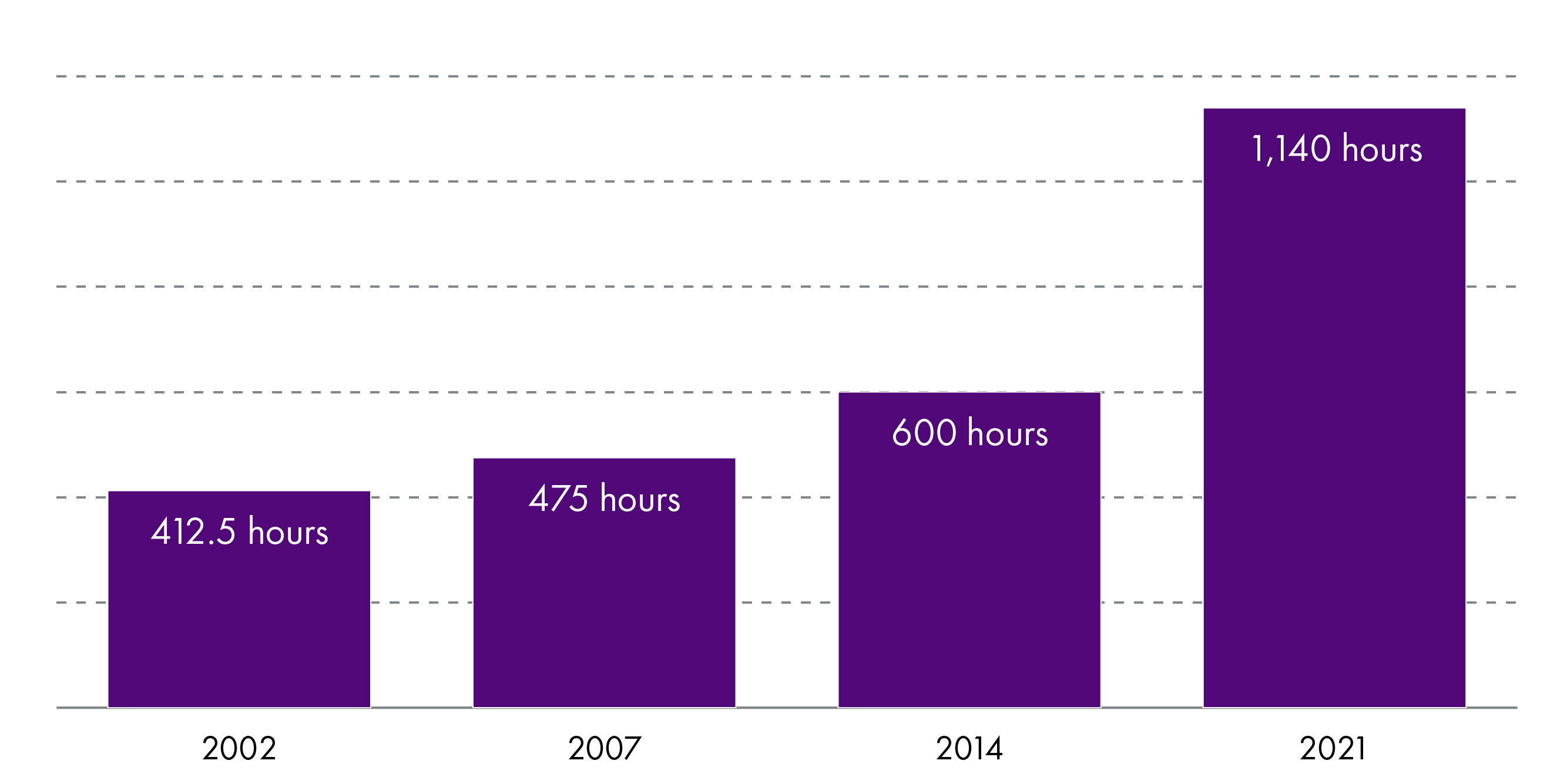
The expansion represents a significant and ongoing increase of state-funded support to families with young children. With such a significant policy development there are risks around the delivery of the policy. In addition, given the resource commitment, the Parliament may wish to scrutinise how the expansion is improving outcomes for children and their families.
Delivery
Local authorities are responsible for securing the funded ELC for families. Local authorities have a dual role of being an ELC provider and a commissioner of ELC services from private voluntary and independent (“PVI”) nurseries and childminders.
Local authorities may provide or secure more than the minimum number of hours. The Improvement Service has reported that in February 2021 86% of children in funded ELC settings were receiving more than the statutory (annualised) 600 hours and 65% received the full 1,140 hours; the individual percentages are set out in the chart below. The Improvement Service noted that “variability at the local level remains a key feature of the progress of expansion.”
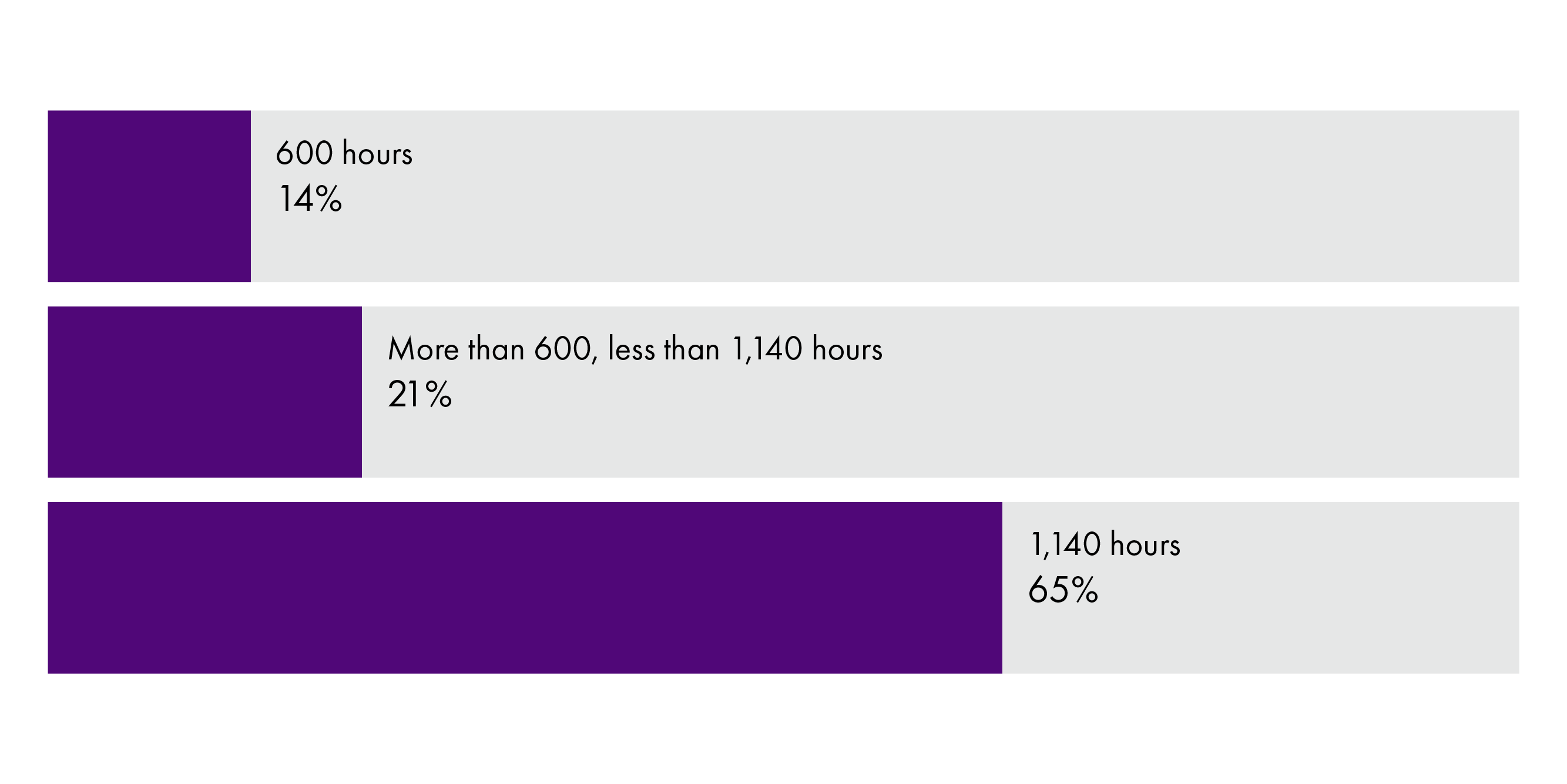
Risks to Delivery
In early March 2020, before the initial lockdown, Audit Scotland published a report on progress of the roll out of the expansion of ELC. This report identified risks in relation to staffing and building projects.
On staffing, the most recent update from the Improvement Service on the ELC expansion, published in April 2021, noted that in February 2021, the “local authority ELC workforce is reported to have increased by 6,948 FTE since academic year 2016/17, including an increase of 505 FTE since August 2020”. A further 1,200 FTE are expected to be employed by local authorities by August 2021.
In the PVI sector, Audit Scotland’s 2020 report noted that “funded providers continue to report challenges with recruitment and retention of staff”. (p17) A 2019 survey by the National Day Nurseries Association found that in Scotland “staff are leaving for jobs in the public sector which offer better remuneration.” Audit Scotland also identified a lack of national monitoring of the movement of the workforce to the public sector from the PVI sector.
The Improvement Service’s Spring 2021 report provided an up-to-date picture on the capital investment in the public sector. Referring to work undertaken by the Scottish Futures’ Trust on the expansion of local authorities’ ELC estate, it said:
As of January 2021, there were 917 projects in the capital programme, 64% of which are now complete. It is forecast that of the capital projects required to support the delivery of 1140 from August, 94% will be complete by August 2021. For the 6% of projects that are providing additional space required for August, but which will be completed after August, local authorities are putting in place contingency plans to ensure that there is sufficient additional capacity to meet forecast demand for 1140 from August 2021.
Flexibility and sustainability
The delivery of the expansion is underpinned by the “Funding Follows the Child” approach and the “National Standard”. The Funding Follows the Child approach will be “provider neutral”. Families will be able to choose their preferred ELC setting, subject to availability. The National Standard is intended to ensure that the ELC provided in any setting is of a high quality and that staff are paid at least a real living wage. Operating guidance for the Funding Follows the Child approach states:
The Funding Follows the Child approach places choice in parents' and carers' hands allowing them to access their child's funded entitlement from any setting – in the public, private or third sector, including from a childminder – who meets the National Standard, has a place available and is willing to enter into a contract with their local authority.
Due to the impact of the pandemic, the Scottish Government has produced interim guidance which notes that some elements of the Funding Follows the Child approach and the National Standard will be delayed.
The Improvement Service reported that in February 2021 “30% of provision was being accessed in private settings, compared to 69% in local authority settings, with the remainder being accessed with childminders.” PVI settings will therefore be crucial to delivery of the expanded hours and in ensuring flexibility and choice. A longstanding concern from the PVI sector has been that the rate set by individual local authorities for contracting PVI providers needs to be sustainable. The Scottish Government has produced guidance to support local authorities to set sustainable rates for providers. This guidance is on how a local authority should approach setting rates, but does not suggest minimum or maximum rates.
There have been a number of financial support programmes for PVI providers through the pandemic. The Scottish Government has identified a number of additional financial pressures on the PVI sector:
higher costs of delivery meeting public health guidance requirements
lower income from private sources
support schemes winding down (e.g. the Coronavirus Job Retention Scheme), and repayments for any support provided through loans (e.g. the Bounce Back Loan Scheme).
Evaluation
The Scottish Government states that the main aims of the expansion are to:
improve children’s outcomes and help close the poverty-related attainment gap
increase family resilience through improved health and wellbeing of children and parents
support parents into work, study or training.
Audit Scotland has noted that the previous expansion of funded ELC in 2014, from 475 to 600 hours, was not accompanied by a plan to evaluate the change in policy. The Scottish Government will evaluate the expansion from 600 to 1,140 hours.
The Scottish Government has commissioned a study, the Scottish Study of Early Learning and Childcare (SSELC), to provide information on funded ELC and the associated outcomes. The SSELC will measure the impact of the policy on long-term outcomes for children and parents by comparing two groups of children: baseline samples of children receiving 600 hours of funded ELC and children receiving 1,140 hours of funded ELC in 2022-23.
Key issues for Session 6
Early in the session, the likely focus is going to be on how local authorities are delivering 1,140 hours and how the PVI sector has weathered the pandemic. As this delivery beds in, the focus may move onto how the goals of high quality and flexible childcare are being met. Towards the end of the session, it may be possible to begin to identify impacts and outcomes of the policy.
Manifestos leading up to the election also indicate a political willingness to further expand state funded childcare. For example, the SNP’s manifesto stated:
In the next Parliament we will [build] a system of ‘wraparound’ childcare, providing care before and after school, all year round. Those on the lowest incomes will pay nothing, and others will make fair and affordable contributions.
We will also expand free early years education to all 1 and 2 year olds, starting with children from low income households in this parliament. (p60)
Tenements and repairs – why should MSPs be interested in this topic?
Kate Berry and Sarah Harvie-Clark, Senior Researchers, Housing and Civil Justice
SPICe regularly supports MSPs with a high volume of constituency enquires in this area. It seems to be the kind of issue which arrives in members’ postbags whether they like it or not.
What is a tenement?
When you think of a ‘tenement,’ you may picture the traditional sandstone building. But, as the current legislation does, we use the term much more broadly here, to describe any building containing flats.
What’s the issue?
Flats are a huge part of Scottish life, accounting for just over one third of Scotland’s housing stock (around 930,000 homes). But the condition of some tenements, particularly the older ones, is pretty poor. Older homes tend to have higher levels of disrepair to ‘critical elements’, that is those that are central to weather-tightness and structural stability.
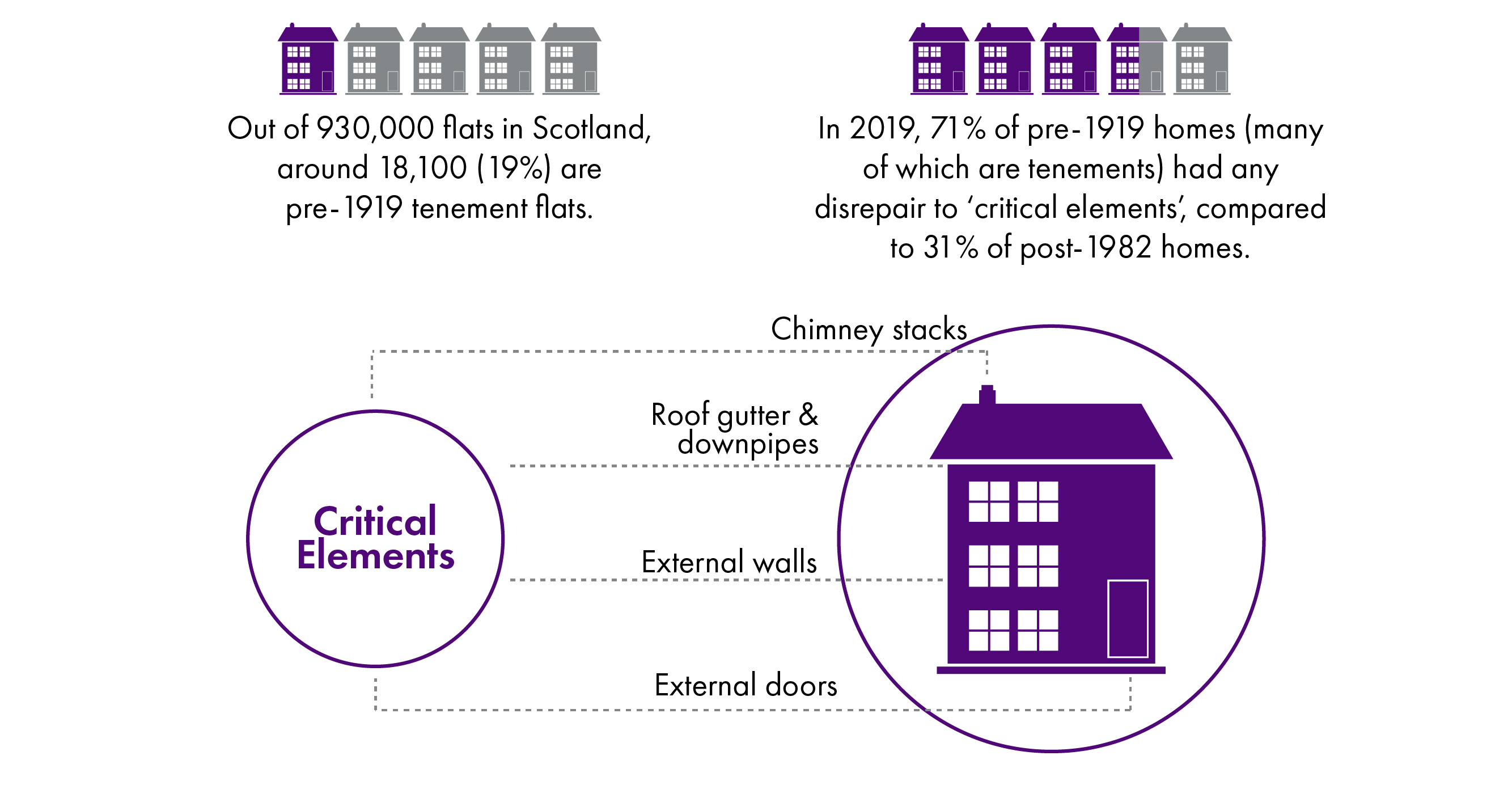
Seventy one per cent of pre-1919 homes (many of which are tenements) had any disrepair to ‘critical elements,’ compared to 31% of post-1982 buildings. Critical elements are those parts of a building central to weather-tightness and structural stability, like roof coverings, external walls, gutters and downpipes, foundations, external doors .
If poor condition is not addressed, tenements will fall into more serious disrepair, becoming more expensive to repair and difficult for owners to sell. Ultimately, they may turn into a ‘ticking-time bomb’ becoming dangerous and, in the worst examples, demolition might be the only option. (Note that there are a wider range of factors involved in some of the high rise buildings that are currently facing problems from having unsafe cladding discovered post-Grenfell).
Legislative reform in the 2000s – not the success story that was hoped for
In the 2000s, there was a round of legislative reforms aiming to address these issues.
Empowering owners to work together
One aim was empowering individual flat owners to work together on repairs and maintenance and so legislation in 2004 introduced the Tenement Management Scheme (TMS). This sets out rules which owners need to follow about maintaining and repairing the common parts of the building. These are defined to include, for example, the roof or the external walls of the building.
The TMS applies to the extent a building’s title deeds don’t specify the position on a particular topic, or if different owners’ title deeds say conflicting things, both of which are common issues.
Significantly, the TMS introduced decision-making by majority rule (with one vote per flat). This improved on the previous situation where unanimous agreement was often required.
Councils can intervene – but probably not with financial help
There was also reform of the systems which allow councils to intervene and compel repairs in certain circumstances. The result is an arguably complicated system, with a range of statutory notices.
One major aim was to greatly reduce flat owners’ reliance on council funds for repairs. Councils now have largely moved away from offering grant assistance to help owners repair their homes.
Why didn’t the reforms work?
Despite these reforms, Professor Douglas Robertson, a housing expert, has argued that,
So, despite this plethora of useful reforms …the actual impact on the ground has proved fairly negligible. If anything, matters now appear to have got worse.
Fundamentally, it can still be very difficult for owners to maintain or improve the condition of their tenements for a variety of reasons.
For one thing, owners can still find it hard to get agreement from other owners, even if the law only requires the agreement of the majority.
In some cases, it can be tricky to identify who owns a flat in a block. Some owners might not have realised they were legally responsible for the common parts, and the news is an unwelcome surprise. Some owners might not be able to afford their share of the costs.
Significantly, there’s not really a culture in Scotland of long-term saving by owners for future repairs, even though this is critical to the long-term health of buildings.
A further complication is that social housing providers must make sure their homes meet certain standards, in terms of their condition and energy efficiency, that owners don’t have to. Accordingly, it can be difficult for social housing providers to achieve their standards if other private owners in blocks can’t agree, or can’t afford, the cost of the work.
Another issue is how disputes are resolved. The current legislation on the TMS suggests owners go to the local sheriff court. While there are some advantages to a court being involved, nobody really wants to end up there. It’s expensive (unless funded by legal aid) and intimidating.
There are other options that policymakers could consider. Mediation might support owners to agree solutions themselves. Specialist decision-makers other than the court might have a role, such as adjudicators, arbitrators or tribunals like the Housing and Property Chamber. Ultimately, it may be possible to use a combination of approaches.
Difficult messages to sell
There are also some difficult messages (for example, about saving for repairs) which policymakers must be prepared to hammer home to the public, whether through legislation, guidance or public campaigns.
Perhaps it has been the unpalatable nature of these messages that made it the easier thing for policymakers to avoid addressing the issues head on. However, the stakes might be getting higher…
A new focus for change
The Scottish Government’s ambitious climate change agenda will require major changes to Scotland’s buildings to make them more energy efficient and use low carbon heating systems. Existing homes may need to be retrofitted to meet the necessary standards.
For tenements, this is likely to require owners to agree on works to common parts. As the Scottish Government signalled in its draft Heat in Buildings Strategy, primary legislation may be needed to support this.
Also important is the 2019 report of the Scottish Parliament Working Group on Tenement Maintenance with its ambition of a parliamentary Bill by 2025. It recommended:
mandatory owners’ associations, to try and involve all owners in decision-making
building reserve funds, to enable long-term saving for repairs
building surveys every five years, for regular identification of repairs issues.
In late 2019, the Scottish Government responded to the Group’s report, agreeing, with some caveats, that action was needed. In terms of legislative change, the Government said that it wanted the Scottish Law Commission to have a role in developing any proposals. However, it thought the Commission might not have capacity to deliver in the Working Group’s desired timescale.
In March 2021, the Scottish Government’s Housing to 2040 strategy was then published.
One solid commitment, likely to be helpful in the context of tenements, is a common housing quality standard for all types of homes backed by an enforcement framework. For this, the Strategy envisages a new law in 2024-25 introduced in phases from 2025 to 2030.
However, where the Strategy refers to the report of the Working Group, or topics covered by it, its approach is lacking detail in places. It’s not exactly clear what the commitments in the Strategy mean for the Group’s goal of legislation by 2025 and fundamental change to tenement law. Given the scale of the issues facing tenements, it is easy to see how the Government might end up facing pressure to achieve faster reform.
One thing SPICe can predict, however, is that the problems will remain very real ‘on the ground’ and so the weight in the constituency postbag is unlikely to get lighter any time soon.
What will be happening in family law in Session 6?
Sarah Harvie-Clark, Senior Researcher, Civil Justice
Here we consider some issues in family law to look out for in the new parliamentary session.
However, there are several other key areas to keep an eye on, all associated with how family law treats adult relationships.
The choice between marriage, a civil partnership or living together
Entering into a civil partnership, an option for same sex couples since 2005, will become available to different sex couples in Scotland in June of this year.
The legislation underpinning this change followed an earlier ruling by the UK Supreme Court. This said the law in this area was discriminatory in not offering the same options to all couples.
Accordingly, every couple will soon have the same three options: to live together, to marry or to enter into a civil partnership.
Faced with a range of choices, constituents may ask their MSPs what is distinctive about each option.

The law for cohabiting couples
At present, Scots law gives cohabiting couples some rights and obligations in relation to each other. These are relevant, for example, on the breakdown of the relationship or the death of one person.
The rights and obligations can be strengthened by conscious legal choices by one or both people, such as making a will or entering into a legal agreement saying what should happen when the relationship ends.
However, overall, the rights and obligations that bind cohabiting couples together are much weaker than their equivalents for married couples and civil partners.
One policy question is whether this is still the correct approach.
Possible reforms ahead…
Later in 2021, or in 2022, we are expecting a report from the Scottish Law Commission on cohabiting couples, specifically, on the law associated with relationship breakdown. This is a timely project, as more and more couples are choosing to live together before, or instead of, marriage.
We can only speculate as to the content of the Commission’s report at this stage. However, it is likely to recommend to the Government improvements to key legislation from 2006. This legislation has been criticised for being unclear and overly complicated, making it hard for lawyers to advise their clients on what to expect.
Given the way society is changing, it is possible the Commission will recommend fundamental reforms to how the couple’s property and finances are treated at the end of the relationship.
Here the Commission has explored making the law which applies to cohabiting couples the same as that which applies to married couples and those in a civil partnership. A key principle at the end of a marriage or a civil partnership is fair sharing, usually equal sharing, of all the property acquired during the marriage or civil partnership. This principle applies regardless of which person owns that property.
Depending on how this reform project progresses, in future, the legal boundaries between cohabitation and other options for couples might become more blurred, perhaps significantly so.
Distinguishing a marriage from a civil partnership – law and policy
Under the current law, the rights and obligations offered by marriage and civil partnerships are virtually identical.
Part of the history here is that a civil partnership was, in the early 2000s, a pragmatic way for policymakers to offer a comprehensive set of legal rights and obligations to same sex couples. This was at a time when society was strongly divided on marriage as an option. Marriage for same sex couples then came a decade later.
So, if the two institutions (marriage and civil partnerships) aren’t legally different, what is the current benefit to having both choices?
The institution of marriage remains very important for many religions. Conversely, the concept of a civil partnership may be popular with non-religious couples.
However, crucially, both marriage and civil partnerships have civil and religious options. Civil marriage was introduced in Scotland in 1940. The registration of a ‘religion and belief’ civil partnership has also been possible since 2014.
It seems that, for some people, a key benefit of a civil partnership is that it is a recent concept.
Marriage, on the other hand, is an institution with a long history. Go far enough back, and this includes a law which said that a women’s money and property becomes her husband’s on marriage.
Some people find this history deeply unpalatable. They argue marriage is still an old-fashioned and patriarchal institution. Others see marriage as an institution which has evolved over time, and which can continue to do so.
During the most recent round of reforms on civil partnerships, different views were expressed on how popular civil partnerships would be with heterosexual couples.
Soon we will be able to watch the published statistics and see just how many couples embrace their new choice.
The end of a marriage or civil partnership – does anyone need to be at fault?
There is also likely to be interest this session on the law on divorce or on the ‘dissolution’ of a civil partnership.
Reforms in England and Wales
In 2020, England and Wales passed legislation to introduce what is known as ‘no fault’ divorce or dissolution, with the new system expected to come into effect in autumn 2021.
This will allow a person to end a marriage or civil partnership without having to prove their spouse or civil partner was at fault in any way. It aims to encourage a good relationship between the former couple afterwards.
The Scottish system
In Scotland, there is currently a ‘mixed system.’ A person can obtain a divorce or dissolution by proving fault on the part of their spouse or civil partner. Specifically, adultery by a spouse is relevant (on divorce), as is a spouse or partner’s unreasonable behaviour (on divorce or dissolution).
A person can also obtain a divorce or dissolution simply by showing they have lived apart from their spouse or partner for a certain period. This is one year if the spouse or partner consents to the divorce or dissolution, two years if they do not consent.
Possible pressure for reform in Scotland
SPICe blogged in 2018 about the possible need for a solely no-fault system in Scotland. It was somewhat cautious. For in Scotland, a fault-based divorce or dissolution seems to occur in only 5% of cases anyway. This compares to 55% of the total cases in England and Wales.
However, the recent reforms in England and Wales encourage you to look at Scots law with a more critical eye, as some legal commentators have done. Are the required periods of separation opportunities for reflection and possible reconciliation? Alternatively, do they leave a couple in limbo for too long?
Another issue is that, at present, one spouse or partner must always raise court proceedings against the other, even if they both agree on all issues. Assuming hostility between the couple, even as a formality, might be old-fashioned and unhelpful. This is especially so where children are involved. Numerous studies show that minimising conflict between parents who are separating is important to the children’s future wellbeing.
SPICe now believes the Scottish Government may come under pressure to look again at this area in Session 6.
The National Performance Framework – your multi-use parliamentary power tool
Simon Wakefield, Senior Researcher, Economy
MSPs have a number of tools they can use to scrutinise the government and Scotland’s public bodies, to assess whether they are achieving their stated aims. One of these is the National Performance Framework (NPF).
What is the NPF?
In 2007 the Scottish Government introduced a new outcomes-based National Performance Framework, which it hoped would underpin most of what it does. Part of the impetus for this was a desire to move away from a focus on inputs (for example budgets for the police) and outputs (for example numbers of police officers), and focus more on outcomes (for example reductions in crime and safer neighbourhoods). It was also part of an attempt to go beyond GDP, and provide a more holistic set of measures of Scotland's social progress and wellbeing (based on an assessment of what matters to people).
Key aspects of the NPF are based in legislation. The Community Empowerment (Scotland) Act 2015 includes a requirement for National Outcomes to be produced, following consultation; a requirement that they are reviewed every five years; and that Scottish Ministers report on progress in achieving their aims.
The NPF is intended to be for all of Scotland, not just the Scottish Government. Its 11 National Outcomes, measured by 81 statistical indicators, are shown here:

The United Nations Sustainable Development Goals (SDGs) are ‘global goals’ and targets, part of an internationally agreed performance framework, to be achieved by 2030. The NPF also provides a localised means of measuring Scotland’s progress against the 17 SDGs. See our overarching theme for more on the SDGs.
In 2017, the Budget Process Review Group took a hard look at outcomes-based budgeting, and proposed a greater role for the NPF (see Chapter 6 of the report especially). The National Outcomes were reviewed by the Parliament in 2018, whilst in 2019 the Finance and Constitution Committee set out its budget guidance, including that committees should use the NPF throughout the year, to help them scrutinise the budget. Under the terms of the legislation the National Outcomes are currently due for review in 2023.
Some tool functions
The NPF can be used by MSPs for a number of parliamentary jobs. Some of these are set out below:
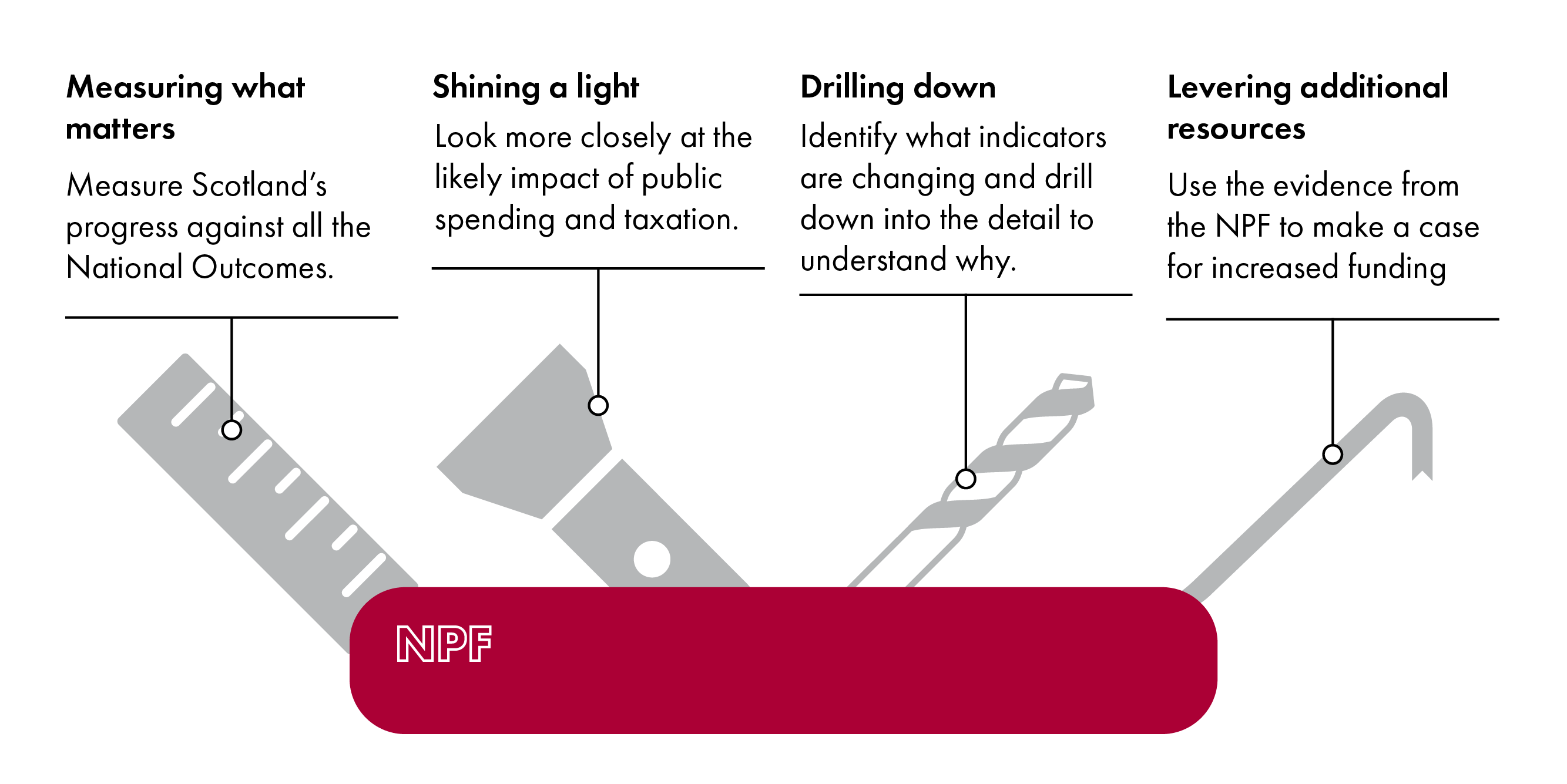
Measuring ‘what matters’
According to a famous speech in the 1960s by US Senator Robert Kennedy, the Gross National Product is a measure of everything “except that which makes life worthwhile”. In recent years there have been attempts across the world to develop wider measures of wellbeing going beyond GDP. This note from the Scottish Government describes the public consultation in Scotland on the NPF, and how themes like human rights, poverty, communities and the environment were identified by the public, alongside those on jobs and the economy.
The NPF therefore provides a tool to allow MSPs to measure Scotland’s progress against the government’s stated National Outcomes across a wide range of policy areas, drawing on statistical indicators in what is intended to be a transparent and open manner.
Shining a light (on the budget)
The NPF can be a valuable tool in helping MSPs understand and scrutinise the Scottish Government budget, as set out in this SPICe briefing. If MSPs wish to look at a particular area of spending, they can examine how the relevant National Outcomes have changed, as well as the performance of the underlying statistical indicators. The NPF won’t tell us what spending and which policies have caused any changes in outcomes, but they do provide a baseline for further questioning.
As an example, the Rural Economy and Connectivity Committee (February 2020) used the NPF to help them formulate their questions to the Cabinet Secretary on the Scottish Government budget.
Drilling down
The NPF allows MSPs to move from the big picture down into individual policy areas and get into the detail. For example the Local Government and Communities Committee carried out some post-legislative scrutiny of parts 3 and 5 of the Community Empowerment Act 2015 (relating to participation requests and community asset transfers). The Committee looked at the data and specifically the fact performance was judged to be worsening on ‘social capital’. This allowed the Committee to drill down into what was happening, and ask why.
Levering additional resources
The NPF can also be used as a lever, to help make the case for additional resources.
For example following the Equality and Human Rights Committee’s pre-budget scrutiny in 2019,which included a focus on the NPF and relevant statistical indicators, the Scottish Government indicated that it had increased the Equality and Human Rights budget to £30.2 million (from £24.6m in 2019-20) “representing our commitment to embedding equality, inclusion and human rights across all portfolios”.
Some add-on tools
People who like the NPF parliamentary power tool may also like:
Health and safety when using your NPF multi-use parliamentary power tool
The NPF does have some limitations, including the following:
There are inherent challenges in an outcomes-based approach, as this paper from Audit Scotland sets out. For example, it is difficult to separate out what impact public services have on outcomes, as many factors are outside the direct control of the public sector. However, effective joined up working, early planning, and an understanding of the evidence, and its gaps, all help.
There are some gaps in the data. For example, as at April 2021, of the 81 National Indicators, nine were “in development” (for example to measure childhood resilience or to measure secure work), and for a further four indicators, an assessment of performance could not yet be confirmed (due to limited data).
The NPF no longer has time limited targets, as explained in this SPICe blog, though MSPs suggested that more could be done to make indicators more specific and measurable
The pandemic has posed challenges. As this SPICe blog indicates, the NPF, and in particular the data lags in the indicators, mean that it is not the ideal tool for scrutiny of a fast-moving pandemic. The Scottish Government has nevertheless taken a close look the "significant and wide ranging" impact the pandemic is having on National Outcomes.
Overall, use of the NPF in the Parliament has increased since 2018 but remains patchy across committees’ work on pre-budget scrutiny.
Finally - to get the most out of the NPF, you don’t always have to DIY – please contact SPICe if you need help.
Where next for a Scottish economic strategy?
Alison O'Connor, Senior Analyst, Economy
In 2019, SPICe published ‘Evolution and dilution in devolution: economic policy in Scotland’ to mark 20 years of the Scottish Parliament. This publication detailed that there had been ten strategies, plans and frameworks to develop Scotland’s economy since 1999. Here we explore what we have we learnt, what’s our current strategy, and where to next.
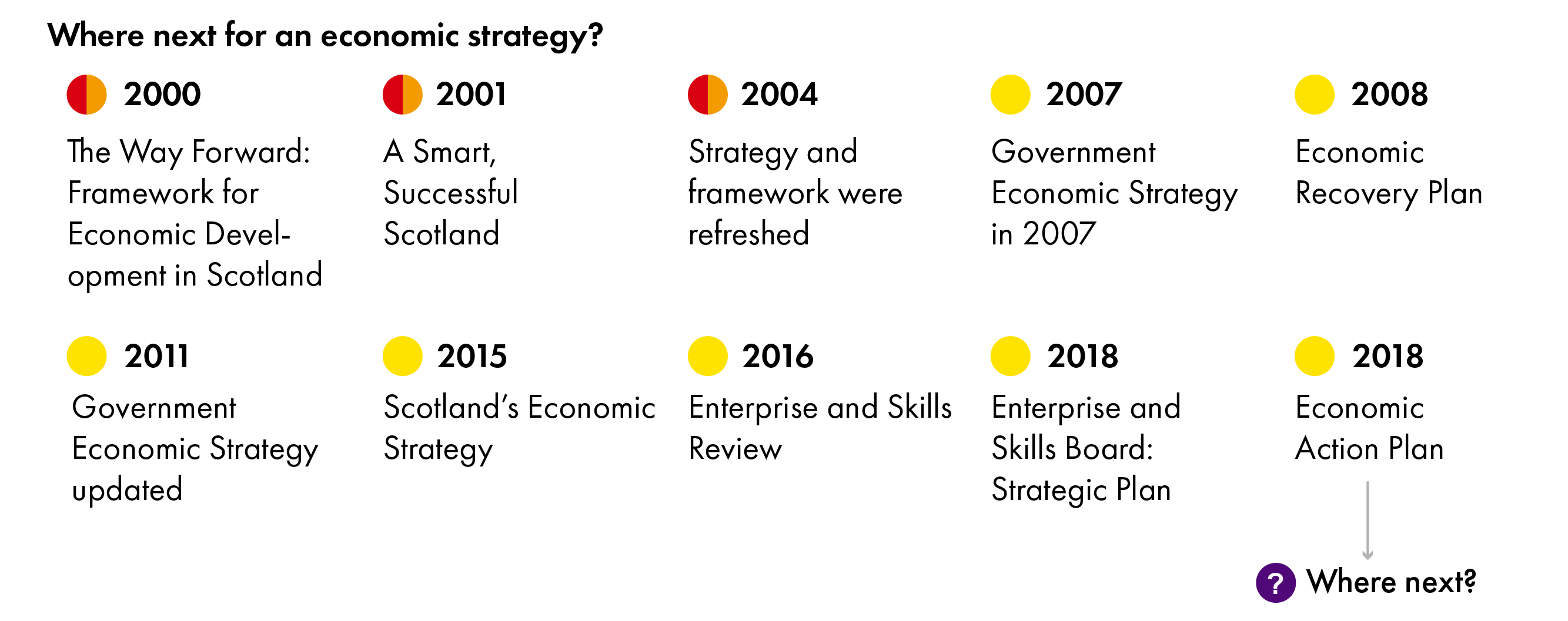
Looking back – 22 years of economic strategies
The first strategy, following devolution, started out as direction for the enterprise networks. Successive strategies gradually tackled wider social challenges and offered direction for the wider public sector. Scotland’s Economic Strategy published in 2015 is currently Scotland’s main strategic economic policy document, but there has been continued policy churn to support this since. The Enterprise and Skills Review was launched in 2016, resulting in the Enterprise and Skills Board: Strategic Plan in 2018. And late 2018 saw the arrival of the Economic Action Plan. Though this could be classed less a plan, and more a website, capturing a range of initiatives linked to the economy.
The purpose of the 2015 strategy was to create a more successful country, with opportunities for all of Scotland to flourish, with sustainable economic growth at the core. This strategy introduced the concept of the “four Is” (investment, innovation, inclusive growth, internationalisation). Overall it was a broad, high-level strategy and did not set out in detail how underpinning policies and initiatives would be implemented.
Over last five years we saw some attempts at rethinking the ‘enterprise and skills’ landscape in Scotland. But did this achieve the change that was originally anticipated - The Enterprise and Skills Review – achieving its aspirations? – some would argue the landscape is still cluttered
Over the last two decades, Scotland’s economic policy landscape has evolved from a narrow enterprise agency approach to a wider whole government approach. SPICe’s 2019 blog stated that while there is merit to this more holistic approach to economic policy, it has weakened accountability, and makes evaluating what actually works all the more difficult. There have been no formal procedures in place to form an overall assessment of the success of successive economic strategies.
Where to now?
Looking to the next five years, it’s likely we’ll see further evolution of economic policy. Given the last strategy was published in 2015, the unparalleled impact of COVID-19 on the economy, and a range of competing policy priorities, a new coherent strategy is required for the Scottish economy.
Any future economic strategy will be starting at a much more difficult place than its predecessors due to COVID-19. At its peak, the economy took a near 25% hit to economic activity compared to pre-pandemic levels and 736,000 workers were furloughed. And while the economic figures have recovered somewhat, the scarring effects of the pandemic will impact the economy for years to come. A large number of businesses have higher debt levels likely to impact future investment levels and productivity. In addition, there are long-lasting social and economic consequences of unemployment (particularly for the youth); negative impact on human capital from disrupted education; changed consumer behaviours; and greatly changed views on how and where we work. For more on the impact of the pandemic, see our other chapters, for example on the recovery, the business base, and the impact on the labour market.
Even before COVID-19, GDP growth rates over the past decade in Scotland had slowed significantly. Structural issues such as slower population growth and lower productivity rates have been factors in Scotland’s slower economic growth. And on top of this, the aftermath of Brexit has left uncertainty around trade, regulation, and funding.
Beyond the recovery from the pandemic, pre-existing structural issues, and the impact of Brexit, there are some key challenges that could require big shifts in the type of economic policy interventions that are prioritised in Scotland over the coming years, as now explored.
Likely themes over next five years
Any future economic strategy would likely reflect the 25 recommendations of the Advisory Group on Economic Recovery not only targeting economic growth, but making it inclusive and fair, and focusing on wellbeing. Though some were sceptical about the Scottish Government’s subsequent response to the recommendations, feeling it lacked any sense of urgency and was “layered with a gloopy civil service policy syrup, combining defensive past commitments with often vague future plans”.
The UK and Scottish Government’s commitments to net zero by 2050 and 2045 respectively will require that green economy-linked interventions will be at the heart of any future economic strategy.
The new Scottish National Investment Bank (SNIB) was officially launched in late 2020 and is likely to feature more prominently across economic policy interventions, as it establishes its role in the Scottish ecosystem. SNIB’s investments are targeted to support the three somewhat differing aims of the transition to net-zero, building communities, and harnessing innovation. Given its wide remit, some would question whether its £2 billion funding over ten years is sufficiently generous.
Internationalisation – attracting inward investment to Scotland and increasing Scottish exports – was a key strand in the previous two strategies and is likely to continue as a key policy ambition.
Technological and digitalisation developments are leading to new types of jobs, skill needs, and ways of working. While Scotland already has a number of policy initiatives underway to deal with these challenges, the need for re-training, upskilling, lifelong learning, and aligning the skills/education system to the needs of businesses will need to be a feature of economic policy initiatives.
In 2020, the Scottish Government published a review into the ‘Scottish Technology Ecosytem’, known as "the Logan Review". It was a widely well-accepted and frank review of where Scotland’s tech ecosystem was at and where it needs to improve to achieve Scotland’s ambition of creating more large scale-up firms. It would be expected that these would feature and be built on in any future economic strategy. Driving innovation and scaling were prominent ambitions in past strategies but lacked the targeted actions that the Logan Review has provided.
It’s hard to talk about economic policy in Scotland without the phrase ‘inclusive growth’ featuring and more recently the 'wellbeing economy' and 'fair work' have become prominent. In May 2020, the then Economy Cabinet Secretary told us “the time of a wellbeing economy has well and truly arrived”. Scotland has made progress in setting out the strategic direction for inclusive growth, but we are yet to see direct evidence of this strategic direction translating into a step change on the ground.
More than words
Delivering an economic strategy that can coherently pull together all of the above themes, as well as responding to the impact of COVID-19 and Scotland’s pre-existing structural issues (demography, business base productivity), to build an economy that is inclusive and that promotes sustainability, prosperity and resilience, delivering local growth and wellbeing will not be an easy feat.
Any such strategy cannot be developed in isolation. Instead, it will require collaboration and engagement with industry, employees, trade unions, third sector, etc.
It is key that the strategy ‘will be more than words’ and not once again a high-level vision of the economy we want for Scotland. The ambitions of the strategy need to be accompanied with targeted actions, rather than succumbing to the trend of increasingly well-meaning jargon, to achieve change. And it must include evaluation and measures of success to ensure it remains relevant and fit for purpose.
Tax powers: a process not an event
Ross Burnside, Senior Researcher, Finance
Famously described as “a process not an event”, devolution in the United Kingdom has evolved since the devolved legislatures were established in the late 1990s. One of the many stories of Scotland’s devolution years has been the addition of powers held by the Scottish Parliament, particularly in the area of taxation.
When the Scottish Parliament was established by Scotland Act 1998, it was only historically local taxes that were set and collected in Scotland. Council Tax was set and collected by Scotland’s local authorities, and Non-Domestic Rates (NDR) were set by the Secretary of State for Scotland. Around 90% of public spending authorised by the Scottish Parliament came via a block grant from the UK Parliament.
Things changed after the 2007 election, which for the first time in the devolution years saw the SNP emerge as the largest party in the Scottish Parliament. The “Unionist response” to the SNP minority administration came via the Calman Commission which considered what powers might be devolved. Scotland Act 2012 followed and legislated for many of the Calman recommendations.
The 2011 election majority for the SNP set the wheels in motion for the 2014 Scottish independence referendum. In the lead up to the referendum, the leaders of the UK Conservatives, Labour and Liberal Democrats pledged to devolve further powers to the Scottish Parliament in the event that independence was rejected at the referendum. The cross-party Smith Commission for further devolution of powers to the Scottish Parliament and Scotland Act 2016 followed.
The 2012 and 2016 Scotland Acts have increased the taxation powers held by the Scottish Parliament. Whilst many taxes paid by Scots remain reserved to the UK Parliament, revenues from taxes set by the Scottish Parliament now account for nearly 40% of the day-to-day devolved Budget.
How have the tax powers of the Scottish Parliament evolved?
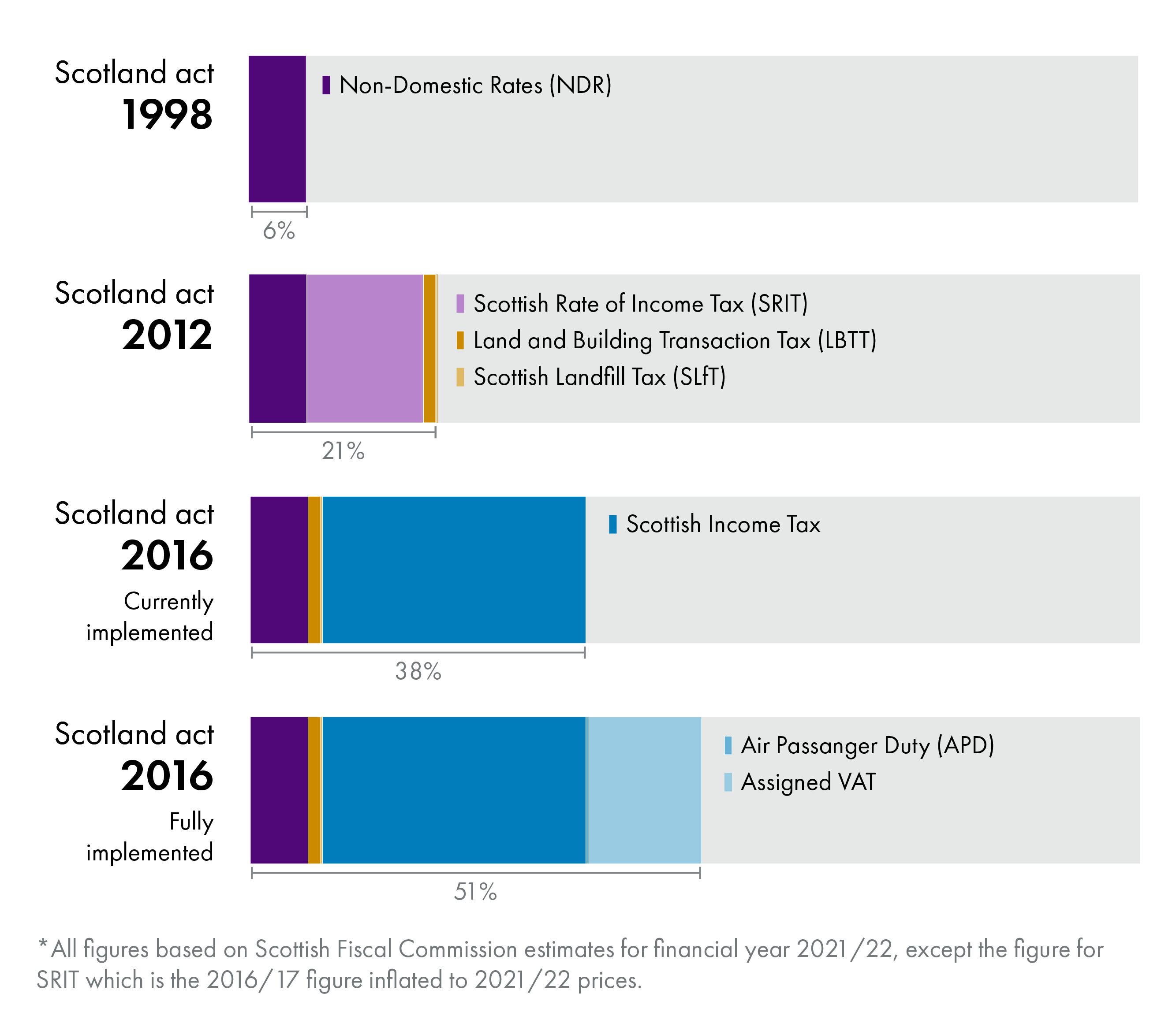
Tax powers have changed the types of debates held in the Scottish Parliament in recent years. A Budget process, which previously was about dividing up a public expenditure cake, has shifted to consider issues around the ingredients and size of the cake, like tax impacts on individual Scottish taxpayers, as well as behavioural and revenue impacts of tax policies. And that’s before you even get around to considering the Scottish and UK Government agreed Fiscal Framework which governs the process, and the various block grant adjustments, reconciliation processes and borrowing powers. So what might session 6 hold for the suite of tax powers held by the Scottish Parliament?
Scotland Act 2016 – unfinished business?
As the above figure shows, Scotland Act 2016 has still not been implemented in full, with issues around the practicalities of assigning VAT to the Scottish Budget and implementing the Air Passenger Duty power (or Air Departure Tax, as it is to be called in Scotland).
The Scotland Act 2016 provides that half of VAT raised in Scotland is assigned to the Scottish Budget. Assignment is not the same as devolution – the Scotland Act 2016 did not give the Scottish Parliament powers to vary any aspect of VAT rates or policy, which remain a function reserved to the Westminster Parliament.
However, implementation of this power has proved challenging. The Scottish and UK Governments have failed to agree the model which will be used to calculate VAT assignment in Scotland by estimating the value of VAT raised in Scotland. In October 2020 the UK and Scottish Government agreed that a new implementation date will be established as part of the review of the Scottish Government’s Fiscal Framework. The review of the fiscal framework is due to take place later this year.
The Scottish Parliament passed the Air Departure Tax (Scotland) Act 2017 on 20 June 2017, which gave Scottish Ministers the power to replace Air Passenger Duty with an Air Departure Tax (ADT) to be paid by aircraft operators in Scotland. However, there have been ongoing issues around implementation of this tax due to the Scottish Government wishing to continue exempting journeys from airports in the Highlands, which required EU approval under state aid rules. The Scottish Government announced on 23 April 2019 that the introduction of ADT would be deferred beyond April 2020.
Might Brexit impact on Scotland’s powers?
When the Smith Commission looked into devolving Value Added Tax (VAT) in 2014, it was constrained by the fact that European Union (EU) rules prevented member states having different rates of consumption tax within that jurisdiction. The final report decided to recommend the assignment to the Scottish Budget the first 10 percentage points of the standard rate of VAT.
Now that the UK has left the EU, might consideration be given to devolving VAT to the Scottish Parliament in full? The answer is uncertain. The EU membership barrier may be gone, but there are still some big complexity challenges in devolving VAT to the Scottish Parliament, around identifying points at which VAT would apply (for example with online shopping) and costs on business from tracking VAT due in different VAT jurisdictions.
Similarly, the State Aid barriers mentioned above around Air Departure Tax will presumably be reduced, if not eliminated, now that the UK has left the EU and the transition period is complete. However, any debate on how these powers might be used will now possibly be more focused on Climate Emergency considerations, after the previous Scottish Government dropped its policy of halving the airline tax in Scotland. For more on the impact of Brexit, see our overarching theme on the devolution settlement.
The role of taxation in Scotland?
Another ‘one to watch’ in the new Parliament, is work the previous Session’s Finance and Constitution Committee recommended be undertaken. In its final Budget Report of the session, the Committee concluded that a:
fundamental examination of what the Scottish tax system is designed to achieve must be undertaken. In particular, the role of tax policy in achieving a just, sustainable and strong economy as we recover from COVID […] The review should also include the following: the breadth and nature of the tax base; the impact of economic activity on the size of the tax base; the relationship between local, Scottish and UK-wide taxes.
The Committee’s view is that this requires a national conversation jointly led by the Government and Parliament and which includes a wide range of voices across Scotland.
This work has the potential to be a significant stock take of where we are in terms of how we have used the powers available in Scotland, and how they should be used in the future.
It might also usefully consider the impact of the pandemic on how we tax businesses in Scotland in the future. Will non-domestic rates, which charge by business premise rateable values, have a different future if the way Scots work shifts significantly towards greater home-working and there is greater reliance on online shopping? Will further consideration be given to taxation of online activities in Scotland?
And finally, the extent of taxation in Scotland?
Only time will tell what range of tax powers the Scottish Parliament has available to it.
As always, it will be the political lie of the land that drives change, and ultimately Scottish voters who decide on the extent of any change.
Supporting the Scottish business base: ensuring a strong recovery
Alison O'Connor, Senior Analyst, Economy
The Scottish business base – some facts and figures
Scotland’s business base totals approximately 364,310 businesses operating, as at March 2020. These latest data don’t capture the impact of COVID-19 on the business base, and updated data is expected in late 2021. Just under half of Scotland’s businesses (179,460) were registered for VAT and/or PAYE. And 51% were “unregistered businesses”, these are sole proprietorships and partnerships that are not large enough to be VAT registered (i.e. have an annual turnover below the VAT threshold - £85,000 as at March 2020) and are not PAYE registered (i.e. do not employ others). The following infographic highlights some other key characteristics about the Scottish business base.
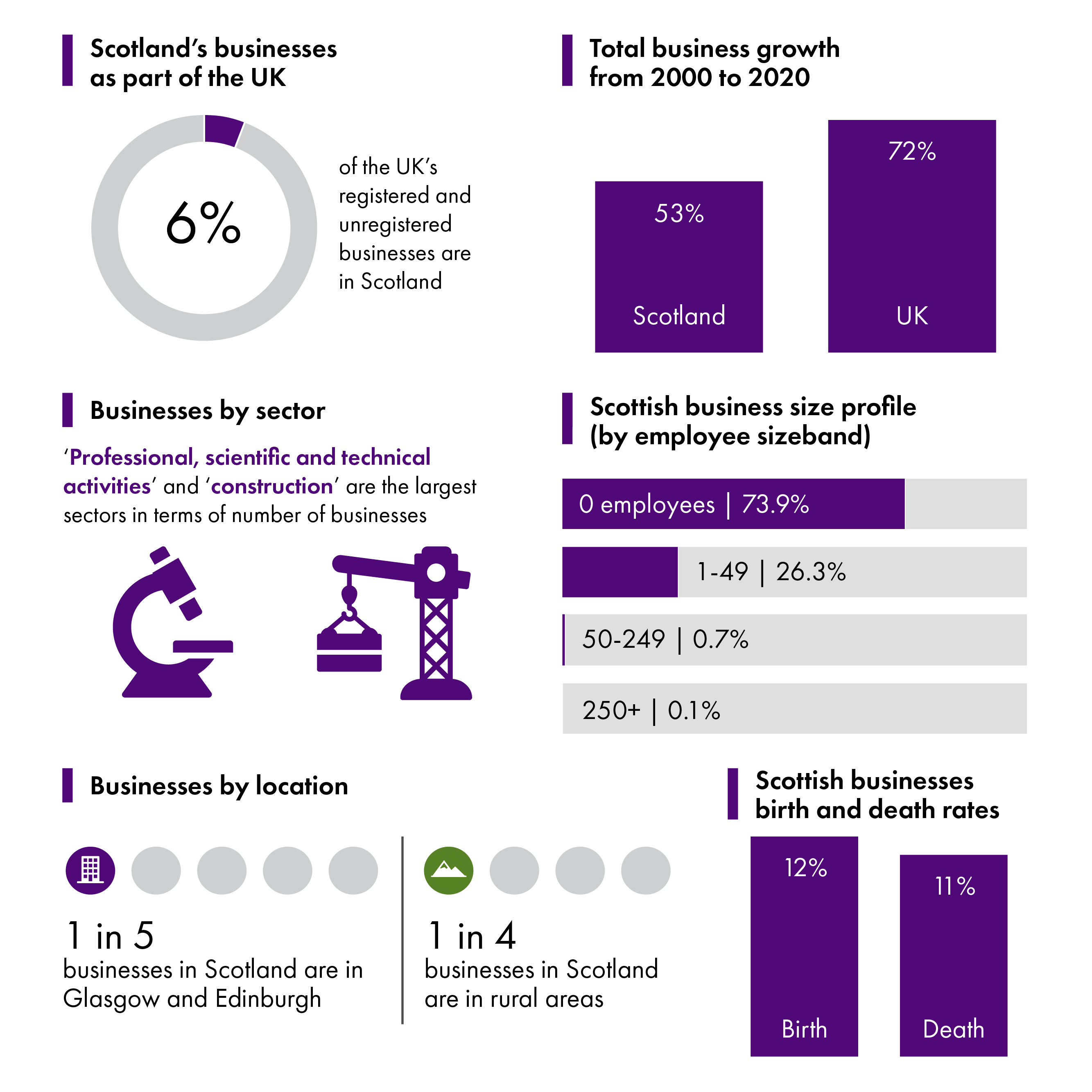
Issues for business base – COVID-19, Brexit and more
One of the greatest issues facing Scottish businesses, and businesses globally, is the impact of the COVID-19. They are having to navigate a broad range of issues that include:
keeping their employees and customers safe
depleted reserves and increased levels of debt
reorienting business operations
changed consumer behaviours and preferences
navigating government support
and most of all, vast uncertainty.
However not all businesses have felt the same impact. Some industries were hard-hit, especially those classed as highly consumer-facing non-essential services. Amongst the Scottish business base the ‘accommodation & food services’ and the ‘arts, entertainment & recreation’ industry sectors have been the most negatively impacted. The gloomy reality is that we can’t expect all of Scotland’s over 364,000 businesses to survive the impact of the pandemic.
Unfortunately, smaller firms and those self-employed will be most vulnerable to closure, being less likely to have reserves to draw on. A concern is Scotland’s rural areas, where smaller businesses are more prominent. Rural areas have slightly higher shares of jobs in the most-exposed sectors. Also, rural areas have much less sectoral diversity of employment, meaning the loss of businesses impacts the sense of place and community resilience. Business closures not only mean job losses, but scarring effects on the local economy.
For more on the impact of the pandemic see for example our related chapters on the recovery and the labour market.
On top of navigating a global pandemic, Scottish businesses have also had to deal with what some have called the ‘double-whammy’ of Brexit on top of COVID-19. In particular, Brexit has caused complications for exporters reaching international markets. Furthermore, some sectors are concerned about labour shortages without access to EU nationals, once the economy is fully reopened.
And we can’t forget that the issues faced by Scottish businesses prior to the pandemic haven’t gone away. These included:
increased costs (including utilities, taxation, etc.)
concerns about regulation/red tape barriers
low average wages and productivity
and staff recruitment and skill issues.
Scottish businesses will also have to grapple with more fundamental long-term changes in the economy, society and policy. These changes will be to the benefit of some businesses but no doubt some will feel disgruntled. Areas of change include:
Scotland’s transition to net-zero carbon
increased emphasis on fair work and the well-being economy
changing working practices (more remote working, four-day weeks, etc.).
Business support, some considerations over the next five years
By “business support” we mean the ways in which governments can help businesses to stabilise and grow, by investing in areas such as skills and innovation, by managing the regulatory burden by providing finance, information, advice and guidance.
It goes without saying the immediate business support priority will be responding to the impact of the pandemic. The levels of government-funded business support over the last year have been unprecedented. The rationale for these interventions was valid - to save jobs and ensure businesses were there to start again when the economy reopened. However, there will come a point where this lifeline support will be fully unwound, and some businesses will face difficult decisions about viability.
Beyond the pandemic support, policymakers will have wider issues to consider about Scotland’s business support landscape to ensure a strong recovery for Scotland’s business base. A select few of these issues are explored here but the wider list is long. For example, we’ve not touched on the new Scottish National Investment Bank, the digital economy, internationalisation, role of enterprise agencies and local authorities, to name but a few.
The 2016 Enterprise and Skills Review (ESR) aimed to significantly improve enterprise and skills support, to help Scotland progress towards achieving the Scottish Government’s aim of ranking among the top quartile of the Organisation for Economic Cooperation and Development (OECD) countries in terms of productivity, equality, wellbeing and sustainability.
Five years since the ESR was launched, the extent to which it is achieving its aspirations is still not clear with the “transformational step-change” in our economy the Scottish Government spoke about five years ago yet to materialise. However, given the 20-year time horizon linked to ESR activities and the unforeseen impact of COVID-19, some ESR activities will likely need to be revisited if Scotland’s top quartile aspirations are to be achieved.
A focus on growth sectors has been a feature of Scottish business support and enterprise policy over recent years. People will have their own views about the effectiveness of this approach. Will this approach continue, or maybe an updated list of sectors, or are we likely to see a more broad-brush approach?
Concerns have been raised about the transparency and value for money of some recent business support investment decisions (Prestwick Airport, Burntisland Fabrications (BiFab), Ferguson Marine Engineering Ltd) by the Scottish Government. Audit Scotland said there should be a clear outline of ministers’ plans for future investment in private companies. Linked to this was an Advisory Group on Economic Recovery recommendation that the Scottish Government should build its professional capability to manage ownership stakes in private businesses.
There have been concerns about the lack of transparency, accountability and alignment in relation to some business support services targeted at SMEs and start-ups. While work has been underway to remedy these concerns, and the response to COVID-19 by Scotland’s business support bodies demonstrated increased alignment, this is an area that should be monitored in future.
The impacts of business support programmes have typically been measured in terms of numbers of jobs created or supported, and the associated Gross Value Added (GVA) (for examples see Scottish Enterprise’s evaluation portal). This reflects the value that governments place on employment. As a result, business support, especially that offered by the enterprise agencies, has often been targeted at those firms who offer the opportunity to create or support large numbers of jobs. Is this still the correct approach, given the increased prominence of fair work, inclusive growth, and the wellbeing economy?
While economic strategies have been prominent in framing Scotland’s policy landscape over the last two decades, is there now a need for a distinct industrial strategy for Scotland? And how would any such strategy interact with the UK Government’s ‘Build Back Better: our plan for growth’ which sets out plans to support growth through investment in infrastructure, skills and innovation.
Ensuring a strong recovery
Getting Scotland’s business community back on their feet will be crucial in securing a strong recovery. The two major indicators of economic success are often viewed as GDP and employment. Yet, the key driver of these indicators, the business base of the economy in question, is often overlooked.
To leverage economic success, it is important policymakers attain the right policy mix that responds to the issues highlighted above and moves strategically in terms of the wider considerations, with focus and clarity, from day one in the next iteration of the Scottish Government.
Infrastructure investment: a balancing act
Nicola Hudson, Senior Analyst, Finance
Infrastructure includes a wide range of assets essential to the functioning of society and the economy. This includes housing, schools, hospitals, prisons, water and waste management facilities, transport networks, energy networks, telecommunication facilities and digital and internet infrastructure.
Infrastructure investment is generally held to be essential for a thriving economy – creating jobs and fostering an environment that supports economic growth. Reflecting this, the previous Scottish Government committed to increasing annual investment in infrastructure so that it is £1.5 billion per year higher in 2025-26 than in 2019-20.
However, deciding what to build, how much to spend, and how to pay for it is not straightforward for any government. Balancing limited budgets and competing priorities is challenging.
What to build…
Given its strategic importance, many governments set out their plans for infrastructure investment over a multi-year period. The previous Scottish administration published a five-year Infrastructure Investment Plan (IIP) covering the period to 2025-26. This set out plans for spending on infrastructure projects, within the context of three priorities:
enabling the transition to net zero emissions and environmental sustainability
driving inclusive economic growth
building resilient and sustainable places.
The IIP also identified three long term trends considered to be relevant to infrastructure investment decisions:
climate change
technological developments
demographic change.
Inevitably, given the timing of the IIP publication, the role of infrastructure investment in responding to the economic, health and social impacts of COVID-19 also featured in the plans for the next five years.
Balancing investment priorities is a challenge for governments as each priority will call for different types of investment and these can sometimes conflict. For example, an investment in road infrastructure might have positive employment impacts and support connectivity between regions, but would score less well in relation to ambitions for reducing emissions. Infrastructure investment plays into various other chapters in this briefing, for example on the climate and nature emergency, expansion of early learning and childcare, and reducing car travel.
What type of economic growth?
Another challenge might come from the type of economic growth considered desirable. An investment that maximises economic growth will not necessarily deliver inclusive economic growth, which has previously been defined by the Scottish Government as ‘growth that combines increased prosperity with greater equity; that creates opportunities for all and distributes the dividends of increased prosperity fairly’.
Even an ambition to strive for inclusive economic growth can present challenges, as inclusivity can have a number of different interpretations. Choices might have to be made as to whether to target income inequality or regional inequality, each of which might imply different decisions on how to invest scarce resources.
The Scottish Government's various priorities – which can be competing – must all be balanced when deciding on how best to spend limited capital budgets. There is also a balance to be struck between investment in large-scale national infrastructure projects which might impact on large numbers of people, and smaller scale local interventions that can be important in tackling inequalities. See our chapter on economic strategies for the history of some of these concepts.
…and when not to build
A further challenge comes from the need to spend money on maintaining existing assets as well as building new assets, again balancing limited resources across these areas. The 2021 Infrastructure Investment Plan (IIP) placed a much higher emphasis on asset maintenance expenditure, stating a preference for enhancing and maintaining existing assets over building new assets wherever possible.
Where does the money come from?
The money available for infrastructure investment constrains all decision-making in this area. Many projects will be competing for limited funds. The Scottish Government can fund infrastructure investment in a number of ways, including:
Traditional capital investment – using the annual capital grant from the UK government to pay upfront for investment. In 2021-22, the capital grant is £5 billion, but amounts for future years will not be known until the UK government sets out its Spending Review.
Borrowing – the Scottish Government’s borrowing powers allow for annual capital borrowing of £450 million up to a cumulative limit of £3 billion.
Financial Transactions money – in recent years, the Scottish Government has received money from the UK Government classified as ‘Financial Transactions’ (FTs). The Scottish Government can only use FT funds to support equity or loan schemes beyond the public sector, such as shared equity housing schemes. The previous administration also used FT monies to provide initial capitalisation for the Scottish National Investment Bank (SNIB) which will, in turn, support private sector led infrastructure investment. FT funding has reduced in recent years and totals just over £200 million in 2021-22. Future amounts are uncertain.
Revenue-financed investment – public-private partnership (PPP) models, such as the Private Finance Initiative (PFI) and the Scottish Government’s non-profit distributing (NPD) model, have been used to finance infrastructure investment, including many schools and hospitals. Under these schemes, a private sector consortium provides upfront financing for the infrastructure project and the public sector then pays for the project (and related maintenance) once it is completed through regular payments over a period of 25-30 years. Importantly, the annual payments come out of the revenue budget, leaving the capital budget free to spend on other projects and increasing the overall level of investment that can be made. The design of these schemes has had to be adapted to meet internationally accepted public sector accounting standards, so the use of private financing has been very limited in Scotland in recent years. The previous administration announced plans to introduce a modified version of the NPD model, known as the Mutual Investment Model.
Reserve drawdown – the Scottish Government can carry forward any underspends on its budget to build up reserves that can be used in future years. There is an overall limit of £700 million on the Scotland Reserve, which is split between resource, capital and financial transactions (FTs). If capital reserves are available, the Scottish Government can (within certain limits set by the Fiscal Framework) draw on these to supplement capital spending in any given year. Normally, £100 million can be drawn down per year from capital reserves. However, if there is deemed to be a Scotland-specific economic shock – as is currently the case – the limit is waived for three financial years. The Scottish Government’s 2021-22 budget included planned drawdown of £200 million in FTs from the Scotland Reserve. This leaves very limited capital reserves for future years, until further additions are made. On current plans, only £10 million of capital reserves and £2 million of FT reserves remain.
Capital receipts and income – finally, the Scottish Government may be able to supplement the funds available for infrastructure investment through selling existing assets or through income generated by assets. This is a relatively modest source of funding (estimated at £62 million in 2021-22).
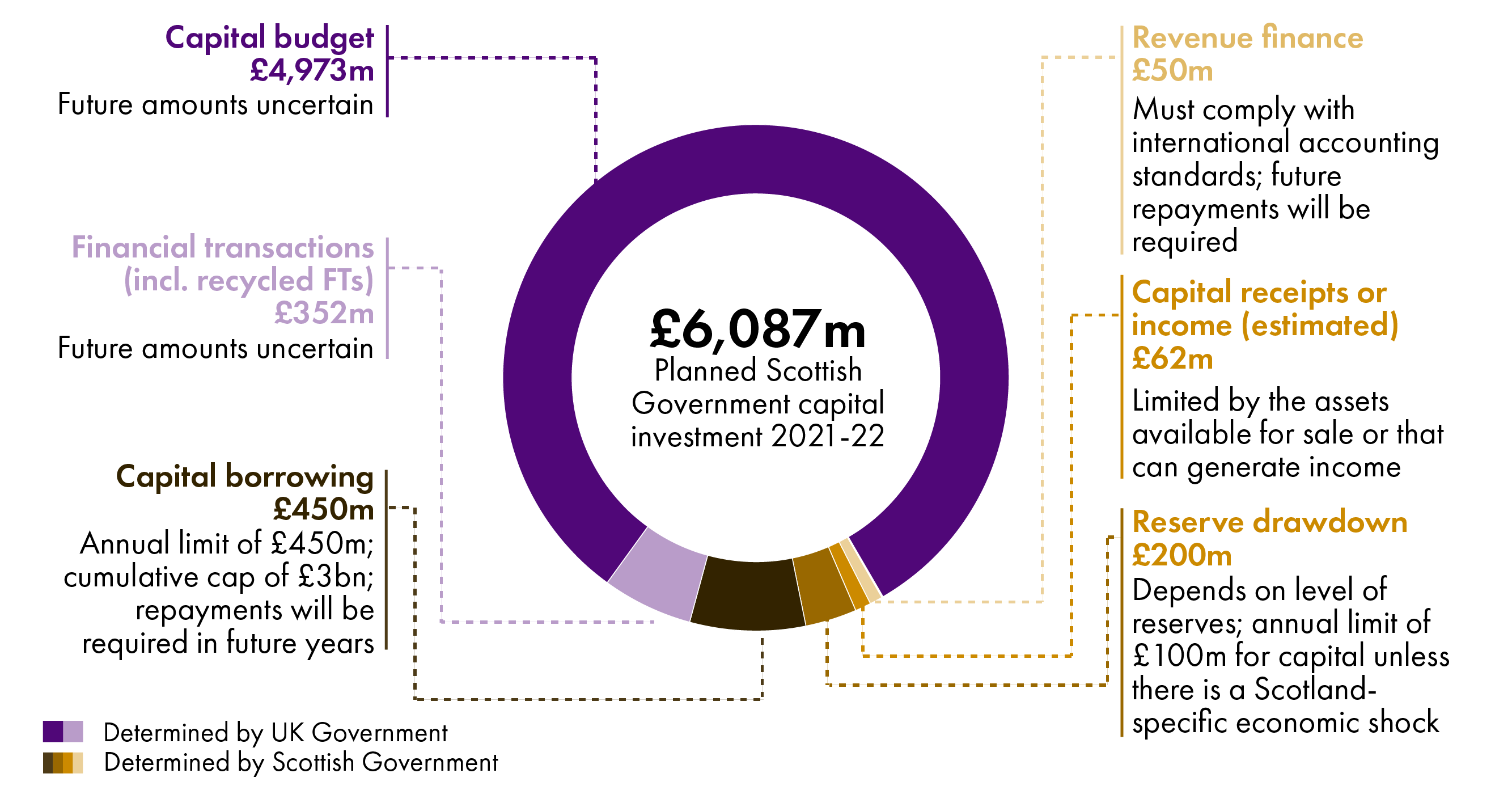
While the capital and FT elements of the budget are determined by the UK government, it will be for a future Scottish Government to determine levels of borrowing and revenue financing to supplement this. Capital borrowing is subject to annual limits and both borrowing and revenue financing imply repayments in future years, so there are constraints in both cases. The previous Scottish Government imposed a cap on the annual value of borrowing and revenue finance repayments, equivalent to 5% of the revenue budget (excluding social security), to ensure that future commitments were sustainable. For more on the budget and tax powers, see our dedicated chapter on that topic.
Was it all worthwhile?
Choosing which projects to fund and deciding how to fund them is not straightforward and there are many constraining factors. Deciding whether the right decisions were made is more complex still. A comprehensive framework for assessing whether investment achieved the outcomes intended remains in development but ensuring progress in this area should be a priority for Session 6.
How has Scotland’s labour market fared during the pandemic?
Andrew Feeney-Seale, Senior Researcher, Labour Market
The COVID-19 pandemic and the lockdown restrictions in response have had a significant impact on Scotland’s economy, as outlined in our introductory overarching theme. And the decline in output during the first lockdown was the largest ever recorded, as set out in the chapter on the business base. Such a dramatic fall has had a significant impact on the labour market, but UK and Scottish Government policy has mitigated this to an extent and the headline unemployment rate has not risen nearly as much as the drop in output.
This chapter will look at the context for Scotland’s labour market on the eve of COVID-19, and the latest data we have on the impact so far of the pandemic.
How did Scotland’s labour market perform between the financial crisis and COVID-19?
The financial crisis of 2008-09 had a significant impact on Scotland’s labour market. Unemployment rose to a peak of over 8.5 per cent during 2011, and remained above the pre-crisis norm until 2016. However, compared to European peers, the UK and the Scottish labour markets experienced smaller peaks in unemployment, and more rapid recoveries. Indeed, in both the UK and Scotland, the headline unemployment rate has been low by historic standards for the past few years, falling to below four per cent for much of 2018 and 2019.
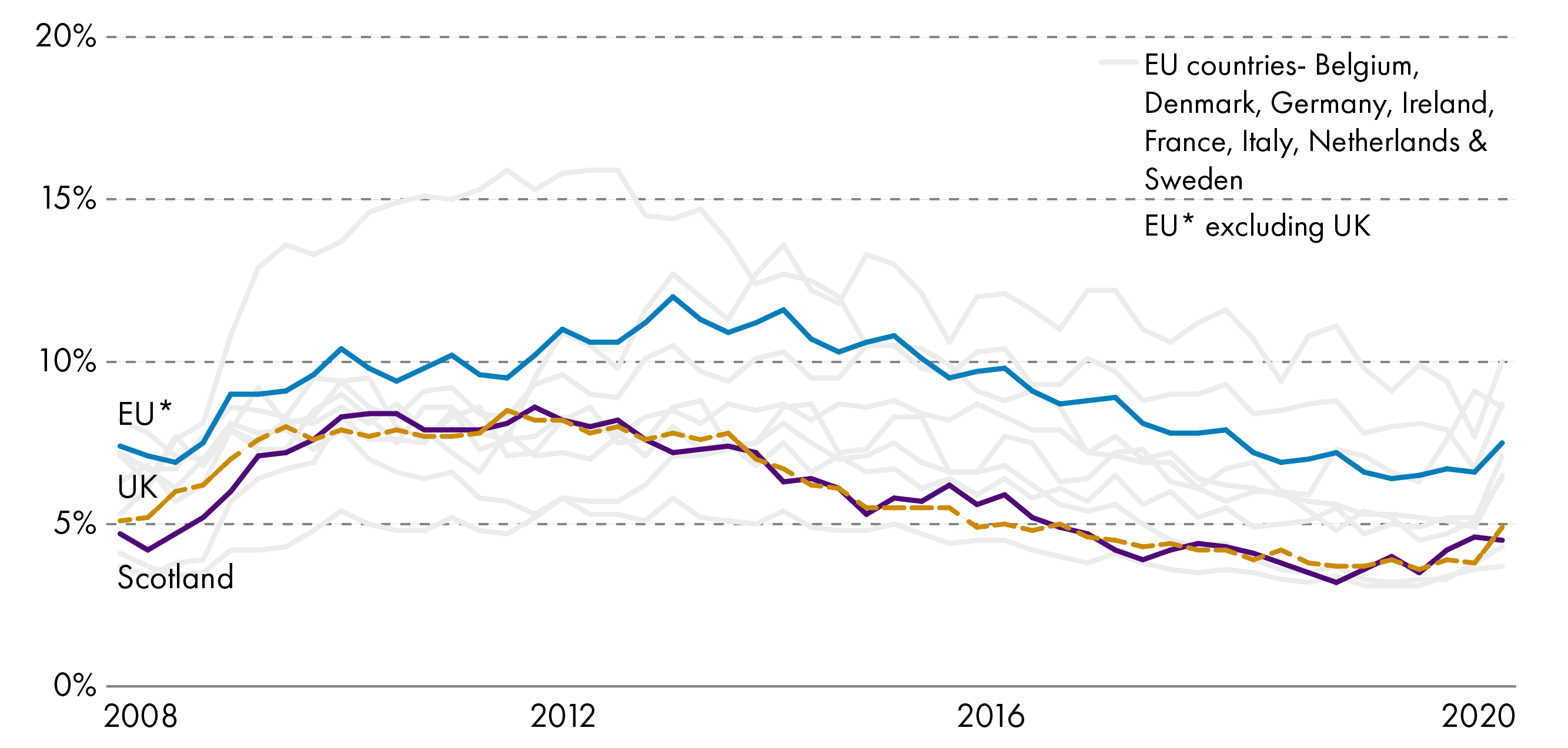
Unemployment, particularly youth unemployment, can have a scarring effect on people in terms of career, physical and mental health. In both Scotland and the UK, youth unemployment rose above 20% between 2010 and 2013, before falling to below the pre-crisis norm. The reduction in youth unemployment in Scotland was sustained for longer, and from 2016 to 2019 tended to be around two percentage points below the UK rate.
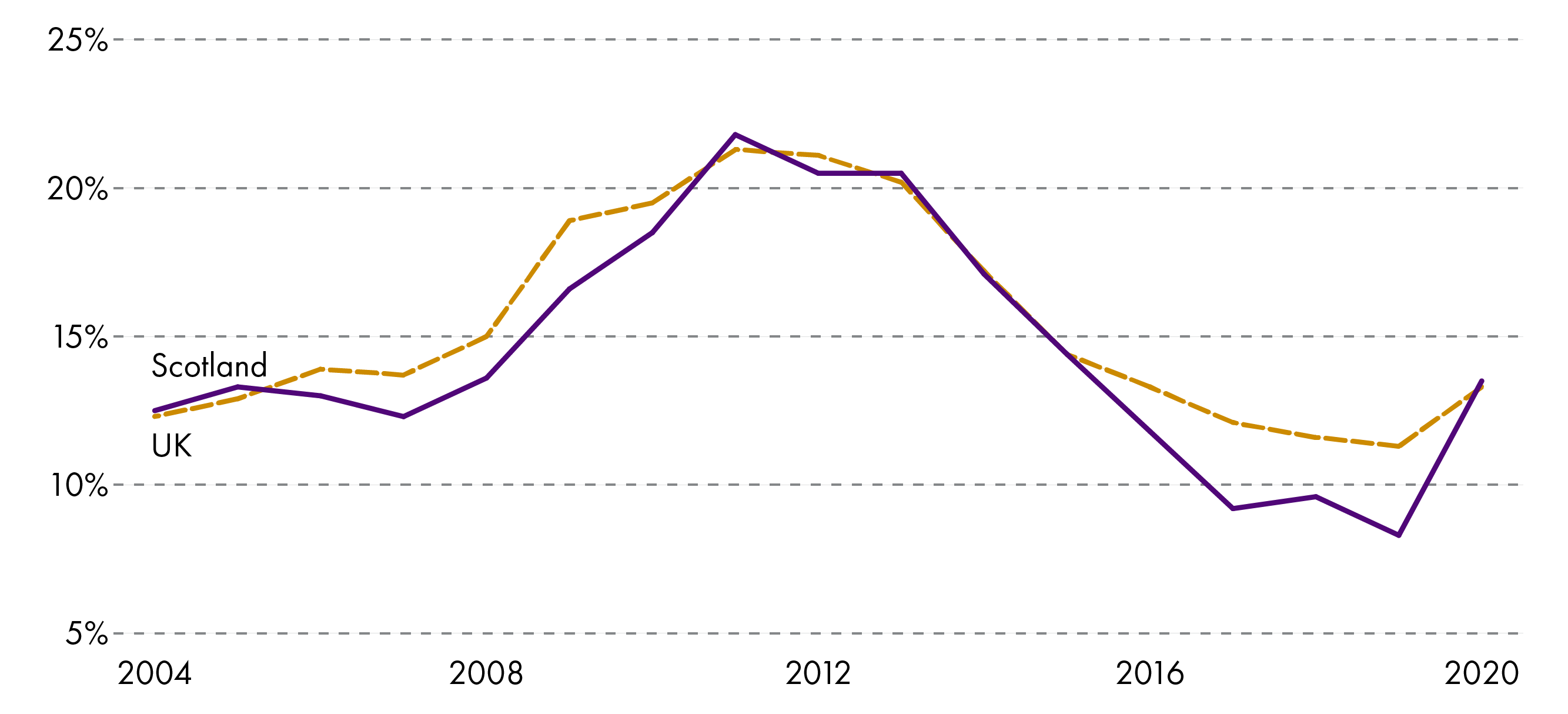
The headline numbers can mask some challenges in the labour market. People may have taken jobs which they are overqualified for, or work fewer hours than they would like. The Scottish Government publish data on underemployment in Scotland (limited to those who are seeking more hours or additional employment). Data is available from the ONS for the UK going to back 2002. This shows that the rate of underemployment in the UK before the financial crisis was around six to seven per cent, but that this rose in the years following the crisis. Since 2013, the underemployment rate in both Scotland and the UK has been falling, but more slowly than the headline unemployment rate. The rate has stagnated around seven per cent since late 2018.
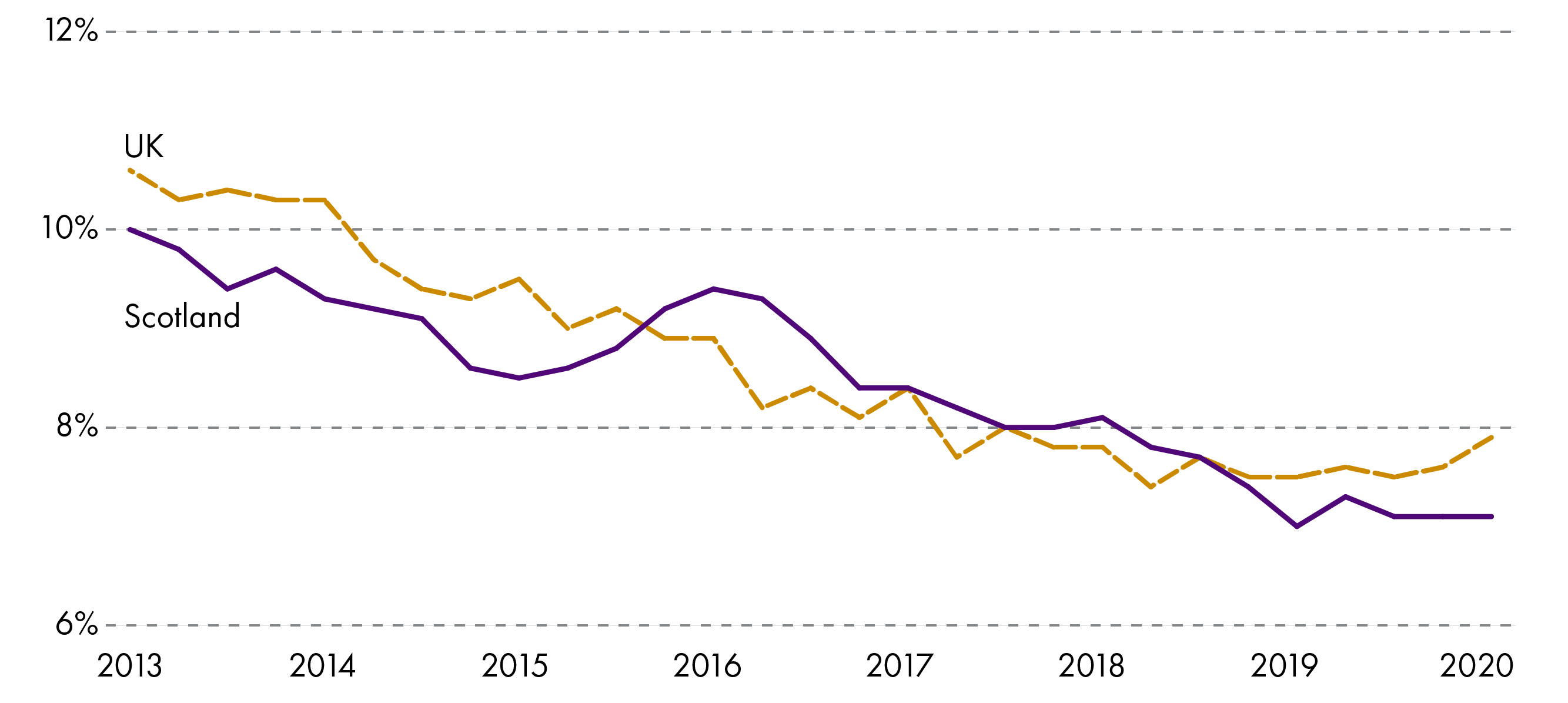
The impact of the pandemic
The COVID-19 pandemic resulted in the closure of a significant part of the Scottish economy, with output falling dramatically, by 19.4%, in Q2 2020.
The latest data on the Scottish labour market was published by the Scottish Government on 22 April 2021. In the year to February 2021 the unemployment rate in Scotland increased by 0.6 pp to 4.4%, slightly below the UK rate of 4.9%. However, we need to be cautious when looking at the difference in rates – the Fraser of Allander Institute note that rates are subject to confidence intervals which overlap when looking at small differences. The rise in unemployment was not uniform – the female rate increased slightly more (+0.8 percentage point - pp) than the male rate (+0.5 pp). Looking at different age groups, those aged 16-24 saw the most significant increase in unemployment, up 5.2 pp over the year. Those aged 25-34 saw a small decrease in the unemployment rate (-0.6 pp). The monthly publication also includes data on the employment rates by the highest level of education achieved, covering the period January 2020 to December 2020. Those with a degree experienced the lowest decrease in employment, down just 0.2 pp, while those whose highest qualification was SVQ level 1 or below saw the greatest falls, down over 5 pp. The disability employment gap, defined as the difference in employment rates of those with a disability under the Equality Act and those without, rose by 1.1 pp to 33.7%.
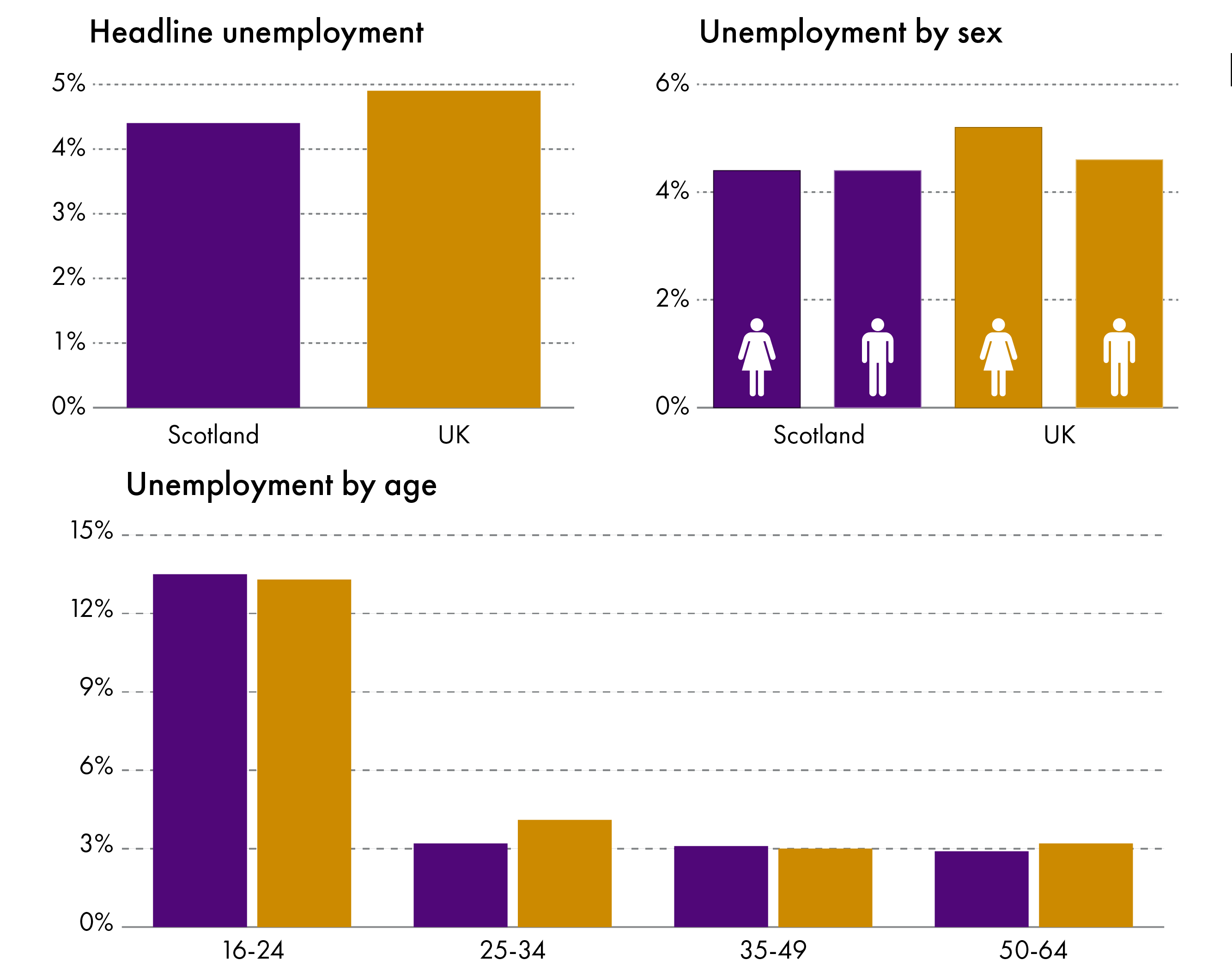
As part of the response to the crisis, the UK Government announced the Coronavirus Job Retention Scheme (CJRS) also known as the “furlough scheme”, which covers up to 80% of salaries for businesses unable to trade or facing significant falls in demand.
Data from HMRC shows that in Scotland the uptake of the CJRS has increased during the course of the second lockdown, from 11.9% of eligible jobs at the end of December 2020 to 14.9% at the end of February 2021. The number of furloughed jobs during the latest lockdown peaked on 19 and 20 January. This was below the peak from the first lockdown. The sectors with the largest number of employments furloughed at the end of January 2021 were accommodation and food services, and wholesale and retail, which together account for 44.4% of all furloughed jobs.
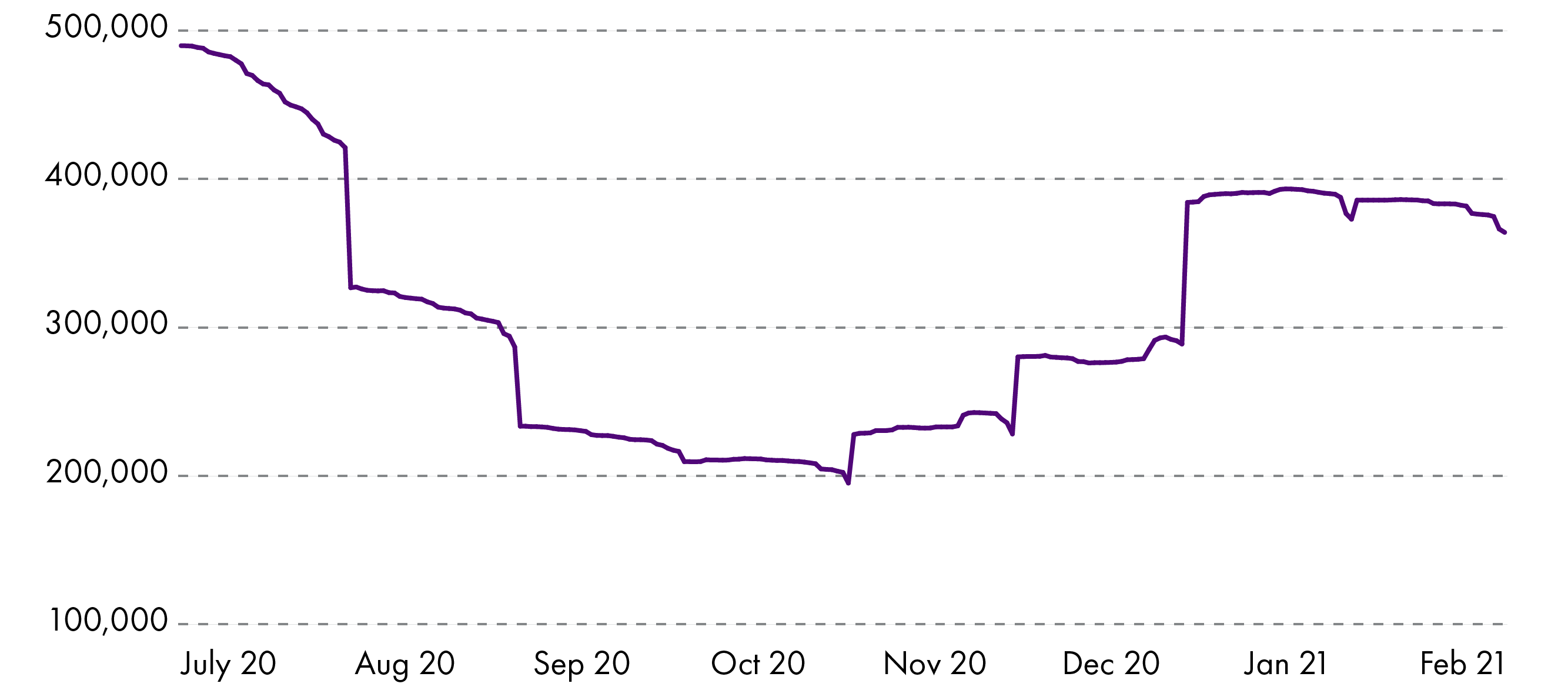
Skills Development Scotland published data on the modern apprenticeship (MA) programme which covers data up to the end of December 2020. COVID-19 has had a considerable impact on the number of apprenticeship positions available: the number of MA starts is around 50% lower than in 2019-20. Prior to the COVID-19 pandemic, the MA programme had increased the number of starts for eight successive years, and was on course to meet the target of 30,000 annual starts.
What are the prospects for Scotland’s labour market?
The Scottish Fiscal Commission (SFC) published updated economic forecasts alongside the Scottish Government’s budget proposals on 28 January 2021. These forecast that unemployment will peak at 7.6% in Q2 2021, before slowly reducing to 4.5% by the end of 2025 – above the pre-COVID normal. These forecasts were made ahead of the UK Budget in March when the CJRS was expected to end in April 2021. This explains the peak of unemployment coming in Q2 this year in the SFC’s forecast.
The Office for Budget Responsibility (OBR) published their updated economic forecasts to accompany the UK Budget in March 2021. This takes account of the extension of the CJRS until September and the rollout of the vaccine. The OBR expect output to reach its pre-crisis level by mid-2022, six months earlier than expected in the OBR’s previous forecast in November 2020. Unemployment is expected to rise from 5.1 per cent at the end of 2020 to 6.5 per cent at the end of 2021, before falling slowly back towards the pre-crisis normal.
The House of Commons Library notes that there were some signs that the pandemic’s impact on the labour market might be plateauing, as the number of vacancies and hours worked started to increase, and redundancies fell from their peak in Autumn. However, all forecasts expect that there will be a significant increase in unemployment once the CJRS scheme ends.
Key questions for the next session
While UK and Scottish Government policies have cushioned the labour market to a degree, there are clearly fewer opportunities available, which is particularly affecting younger people with fewer qualifications. This summer a second cohort will be vying to enter the labour market for the first time, and a key challenge for the next Scottish Government will be to deliver the young persons’ guarantee to ensure as many of these young people can find an opportunity to work or train.
The announcement of the extension to the CJRS to September should avoid the increase in unemployment expected in Q2 2021 by the SFC, but commentators still expect that there will be an increase once the scheme ends in the Autumn. A key challenge for government policy will be encouraging economic activity so that as many furloughed workers as possible can return to the workforce.
The Local Governance Review and beyond - where now for the local government - Scottish Government relationship?
Greig Liddell, Senior Researcher, Local Government

Whilst the media frequently focusses its attention on Holyrood and Westminster, the world of local government can often slip under the popular radar. Should you need a reminder of the importance of local authorities though, just imagine what our lives would be like without the services they deliver. These include schools, nurseries, social services, housing services, adult social care, refuse collection and recycling, roads maintenance, leisure and sports facilities, parks, planning, licensing, the list goes on and on. Outside of the NHS, local government is probably the one part of the public sector which has the most profound impact on all our lives.
This chapter explores elements of the Local Governance Review – a joint effort between the previous Scottish Government and local government, set-up to examine “how powers, responsibilities and resources are shared across national and local spheres of government, and with communities”. With the SNP continuing to lead the Scottish Government, the Review’s recommendations could be published relatively soon, depending on discussions between the Scottish Government and COSLA, and could propose some major changes.
Great expectations - setting the scene for change in Session 6?
Many policies relating to council services are actually determined by the Scottish Parliament or Scottish Government, be it those on educational attainment in schools, free personal care or social housing supply. The relationship between local government and the Scottish Government is therefore occasionally strained, not least when it comes to the small matter of budget. As is explored elsewhere, Scottish Government revenue funding for local government, some of it ring-fenced, amounts to more than half of local government’s total revenue income and funding.
Late in the last parliamentary session, the then Cabinet Secretary for Communities and Local Government reiterated her Government’s commitment to the principles of subsidiarity and local self-determination. Decisions on local issues should be made at the local level, unless there are compelling reasons for the Scottish Government to override. To reinforce this commitment, the Scottish Government also backed Andy Wightman MSP’s bill on the European Charter of Local Self-Government, which for the Cabinet Secretary “symbolises an opportunity to create the conditions for further and more ambitious reforms and strengthens our relationship with local government by putting it on a legal footing”. So, even before the election campaign there was some big talk about “transforming” local democracy. More recently, the SNP manifesto includes a commitment to introduce a new Local Democracy Bill in the next parliamentary Session which will “further empower local communities and ensure decisions are taken as close as possible to those they affect most”.

The Local Governance Review
Three years ago, the Scottish Government and COSLA launched a joint review, to examine the relationship between local government, national government and Scotland’s communities. In their update to council leaders in late 2019, they set out “three interconnected empowerments” which had arisen from the review’s initial engagement exercise:
community empowerment - through a new relationship with public services where communities have greater control over decisions
functional empowerment of public sector partners to better share resources and work together
fiscal empowerment of democratic decision-makers to deliver locally identified priorities.
The update confirmed that a “fiscal framework” is being developed between the Scottish Government and local government. This would recognise the importance of multi-year funding arrangements, which has been an ask of local government for a number of years. Details of this framework are not yet available. How the new arrangements will work, and what role the Parliament will have in scrutinising the processes and allocations, should hopefully become clearer between now and the next Scottish Government budget.
It is COSLA’s view that local taxes should account for a much higher proportion of local government’s total income than it currently does. Their 2014 Commission on Strengthening Local Democracy found that “the most singular limitation on local democratic choice … is the lack of fiscal powers at local level”, and called for at least 50% of local government budget to come from local taxation (it is currently less than 20%). Local communities should decide on their own priorities, for example whether to increase or reduce these local taxes. This could be aided by “democratic innovations” for example deliberative assemblies and participatory budgeting.
As part of the current Local Governance Review, researchers studied systems of governance in various countries across the world, including New Zealand, Denmark, Canada, Germany and England. Among other things, they found that financial arrangements between national/regional governments and local government are far from uniform. For example, New Zealand municipalities receive no government block grant, and in Quebec most municipal revenue comes from local taxes. Denmark has a local income tax system, whilst local property taxes exist in almost all of the case study countries/regions.
Council tax reform…or not
The issue of council tax reform has simmered away for almost 20 years. Readers with good memories will recall the SNP’s 2007 manifesto commitment to “scrap the Council Tax and introduce a fairer system based on ability to pay”, whilst more recently, the 2015 Commission on Local Tax Reform's main recommendation was “the present Council Tax system must end”. The Government accepted some of the Commission’s recommendations, agreeing, for example, to introduce higher rates for those in higher tax band properties (E-H). It’s worth remembering that council tax now is based on values of property in 1991, yet the Scottish Government decided not to commit to a revaluation, stating that such an exercise would lead to some households seeing “significant and dramatic” changes to their bills.
The left-of-centre thinktank, IPPR Scotland, recently published a briefing calling for the current council tax to be replaced with one based on a percentage value of present property values. This would make local taxation more progressive, according to the authors, whilst increasing overall yield, thus helping future administrations pay for COVID-19 recovery policies. However, some indication of the political difficulties facing any reforms to council tax were apparent the day after the IPPR report appeared. Under the headline “Fears for homeowners in council tax revamp plan”, the Daily Mail told its Scottish readers that “middle-class families are facing the threat of more tax hikes under plans to overhaul council charges”. Meanwhile, the Herald spoke of “concerns Scots pensioners could be penalised if major reform is adopted by councils”. With local elections taking place next year, it’s possible that the current council tax system will be with us a while longer.
Wait and see
The previous Scottish Government, alongside COSLA, have been preparing the ground for some radical (“transformational”?) changes in the relationship between national and local government. Work on this stalled, firstly because of the pandemic, then the Scottish Parliament election. Whether dramatic change will happen over the next Session, only time will tell. Given the new SNP Government’s electoral mandate, its manifesto commitment to introduce a new Local Democracy Bill will surely become reality. However, details of what this will include are currently thin on the ground and will be developed through further engagement. Until then, this paper has hopefully highlighted areas where change could be coming.
Note: minor editing changes were made to this chapter on 17 May 2021.
Community empowerment – more than a feeling?
Greig Liddell, Senior Researcher, Local Government
Community empowerment is an elusive concept; tricky to define but quite obvious when you see it in action. Last year, the Parliament’s Local Government and Communities Committee heard a lot about empowerment in action, from towns, villages and cities across Scotland where people have joined together to improve their communities, often in partnership with local authorities. Some were helped in their efforts by the 2015 Community Empowerment Act, particularly Part 5, which is about their community’s right to request ownership of assets.
The Committee also heard from people who felt their communities were not empowered, from areas of the country where the 2015 Act has seemingly had little or no impact. This can be seen in the findings of the 2019 Scottish Household Survey which show that only 18% of Scots believe they can influence decisions affecting their local area, a significant reduction since the Act was passed.
This chapter looks at the previous Scottish Government’s community empowerment agenda, exploring some of the main provisions of the 2015 Act and their impacts. Given the crucial role of community organisations during the COVID-19 pandemic, and likely reforms of local governance, we ask “what next for community empowerment?”
The aims of the Community Empowerment Act?
According to its 2014 Policy Memorandum, the Scottish Government’s Community Empowerment Bill would help “empower community bodies through the ownership of land and buildings and strengthening their voices in the decisions that matter to them.” Perhaps most significantly, the Bill aimed to extend to urban areas the community right to buy which had been established for rural areas a decade earlier. Six years after the Bill was passed almost unanimously, what has the legislation achieved?
First of all, despite the Act receiving Royal Assent in July 2015, there are still two important provisions – relating to supporter involvement in football clubs and participation in public decision-making - which have not been brought into force. For Part 7 (fan involvement in football clubs), the Government held a consultation in 2016 but very little has been said about the matter since. It’s worth noting, however, that the SNP manifesto spoke about creating ‘Fan Banks’ “to empower communities and groups and strengthen local decision-making by supporting communities to acquire a share or control of their local sports club”. So, there may be some movement on this issue after-all.
Of those sections of the Act which have been brought into force, the two most significant for most communities are probably Parts 3 and 5, relating to participation requests and community asset transfers respectively. It was these areas that the Local Government and Communities Committee was particularly interested in during their recent inquiry, and they were also the focus of two Government-commissioned evaluations published in 2019.
The impact of community asset transfer changes
Measuring the impact of any policy or piece of legislation is tricky, especially if it’s one aimed at improving an outcome as intangible and protean as “empowerment”. Nevertheless, it is possible to measure some outputs associated with the Act, for example the number of assets owned by communities or the number of communities submitting participation requests.
Community ownership is one of the National Performance Framework’s ‘national indicators’ (for more on the NPF, see our dedicated chapter). Data published last year by the Scottish Government shows a continuous rise in the number of assets owned by communities since the early 2000s; however, it’s not clear that Part 5 of the Community Empowerment Act has led to any obvious acceleration in this trend. In 2019, there were 590 assets in community ownership, compared to 445 in 2015, the year before Part 5 was brought into force. This represents a 32% increase. For comparison purposes, the increase between 2011 and 2015, i.e. the equivalent period before the Act, was 37%.
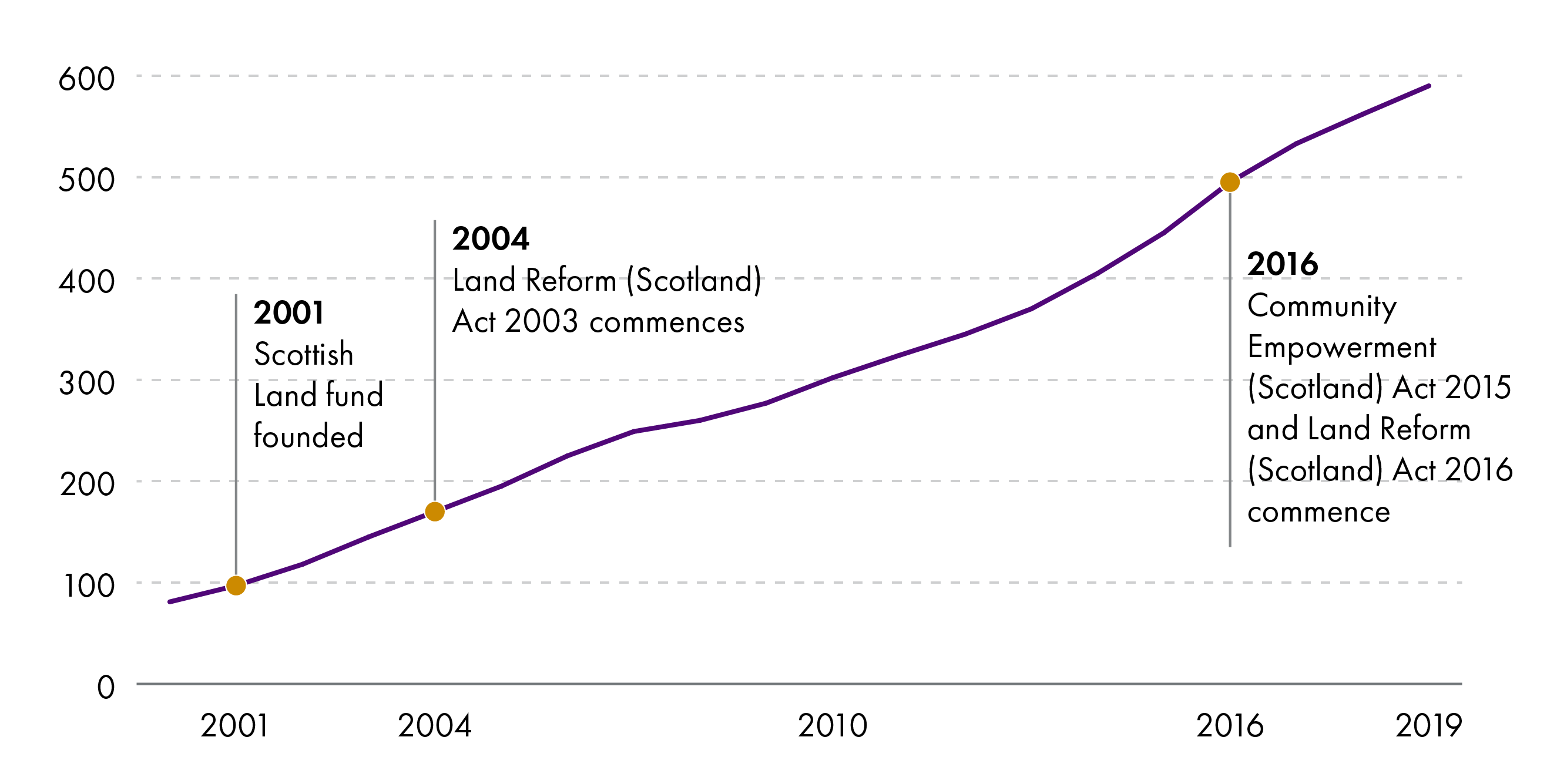
A concern commonly expressed during the passage of the Bill in 2014 and 2015 was that the legislation could act to empower the already empowered, for example wealthier areas with large numbers of professional residents. Data published by the Government show the number of assets in community ownership by SIMD quintile. So, for example, we can see that in 2019, only 51 community-owned assets – 9% of the total - were in the most deprived 20% communities. Unfortunately, we have no time series for this data, so we cannot compare with the period before the Act.
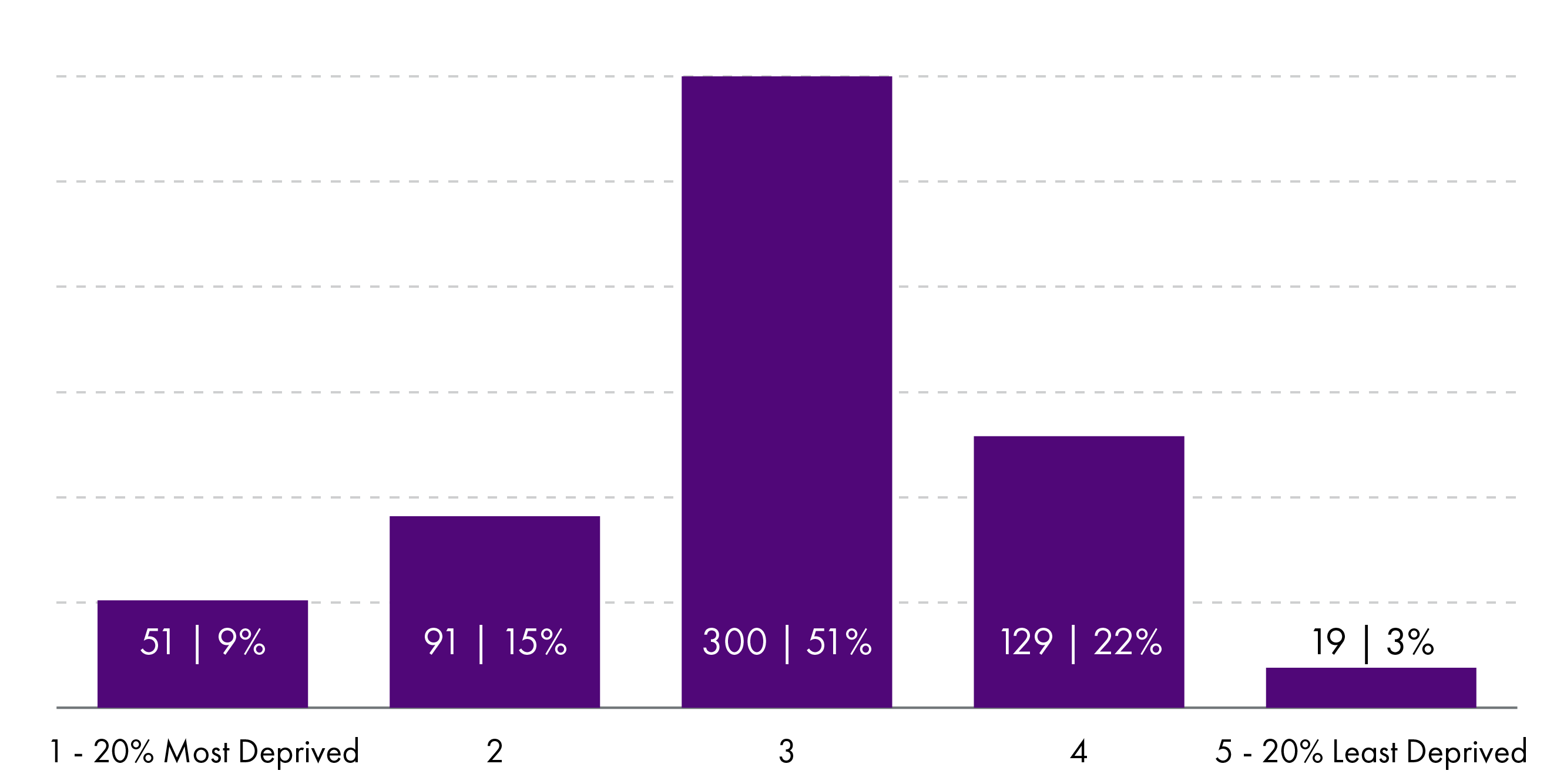
In fairness, the recent evaluation of asset transfers by Glasgow Caledonian University found that “less-advantaged communities are actively using the provisions in the Act, and that asset transfer activity is not being concentrated in areas of higher advantage”. The researchers looked at requests for asset transfer rather than the successful completion of transfers. They found that the number of requests were significantly higher in the three most deprived deciles than in the three least deprived deciles. It is important that any future analysis tracks the extent to which requests lead to successful and sustainable transfers, and what impact asset ownership has on these communities. Certainly, given the case studies highlighted recently by Community Land Scotland, the potential of asset transfer is considerable.
Where now for community empowerment?
In its response to the Local Government and Communities Committee’s report, the Scottish Government acknowledged some remaining “challenges” with its community empowerment agenda. In particular, the then Cabinet Secretary for Local Government and Communities accepted more should be done to support successful asset transfers, including “improved awareness, increased public authority buy in, better transparency of process and higher levels of reporting”. The Government announced the establishment of a National Asset Transfer Action Group, which, among other things, will look at improving the asset transfer process particularly when assets might belong to, or be operated by, an Arms-Length External Organisation (ALEO).
There are also signs that some rather more dramatic changes are on the horizon. For one, the Scottish Government and COSLA’s update on their joint Local Governance Review, spoke of “a new relationship with public services where communities have greater control over decisions”. This will involve some initial pilot projects with “new autonomous and democratically accountable decision-making bodies”. The SNP election manifesto also spoke about “reviewing” the Community Empowerment Act and consulting “on ways in which it could be expanded to put more power in the hands of people and communities and increase the amount of local funding allocated by communities themselves through participatory budgeting”.
Covid and Communities
Whatever the outcome of these reviews and policy developments, community organisations have been rightly praised for their immediate and innovative responses to the Covid pandemic. Although resilience is not the same as empowerment – one is very much reactive whilst the other is (ideally) proactive - there is a clearly a wealth of enthusiasm, talent and community solidarity across the county on which more longer-term empowerment could be built. As noted by community organisations in Glasgow, one of the few positives to come out of the last 16 months is the empowerment people feel to help their communities:
People aren’t happy with the status quo and don’t want to return to the ‘old normal.’ There’s space and energy for new ideas, new ways of doing things.
Town centres and regeneration after COVID-19
Alan Rehfisch, Senior Researcher, Planning
“First we shape the cities – then they shape us.” Jan Gehl, architect.
Town and city centres are the heart of Scotland’s economy, hubs of business, retail, culture, education, and leisure. They are the focus of our rail, bus, and road networks. These concentrations of people, industry, and learning are breeding grounds for new ideas and innovation. Just as importantly, many people also call them home.
Despite the obvious importance of such centres, the decline in “the high street” and what to do about it has long been a focus of academic, government and media interest. This chapter outlines the causes of this decline, action being taken to reverse it, the impact of the coronavirus pandemic and what the future might hold for town centres.
What challenges did our town centres face before the coronavirus pandemic?
The challenges facing many town and city centres were summarised by researchers in 2015. They identified three structural challenges:
The progressive rise of online shopping: not only has online shopping replaced some trips to physical premises, but it has also changed the nature of physical shopping, e.g. by allowing instant in-store price comparison.
The long-term and cumulative impacts of competition from out-of-town ‘one stop’ retail and office developments: easy access by car to a growing number of out-of-town centres challenged the dominance of town centres as retail, business and leisure hubs, although more recent planning policy changes have started to direct such development to town centre or edge of centre sites.
The rise of convenience culture: since the financial crisis of 2008, there has been a shift towards local and neighbourhood shopping – which has seen the growth of small metro/local supermarkets which can also serve as click and collect hubs. This is challenging the growth of very large supermarkets and some out-of-town centres.
They also noted two specific competitive pressures, these were:
The burden of business rates: business rates represented a significant and growing burden on town centre businesses, although this has been tackled to an extent in recent years through various exemption or discount schemes for smaller businesses.
The burden of too much retail/office space of the wrong type: properties available in some centres are of the wrong size or configuration, or in the wrong location, to meet current business needs.
What have previous Scottish Governments done to support town centres?
In September 2012, the Scottish Government commissioned an external advisory group to propose actions to support the recovery and regeneration of town centres. The final report of the group was published in July 2013. This identified a key policy principle of “town centres first”, which requires national and local government, the wider public sector, and businesses to put the health of our town centres at the heart of decision-making processes. It also made a series of recommendations, including:
require private and public sector housing providers to bring empty town centres properties (back) into use as affordable housing
local authorities to receive 100% of business rates collected in town centres.
establish a pilot “town centre investment zone” to trial enhanced business rate discretionary relief
a Scottish Government micro-finance fund to support new business growth.
Community planning partnerships should be strengthened, and place-based reviews carried out
town centre wi-fi established
the town centre first planning policy, which already applied to proposed retail developments, should also apply to other major trip generating developments
a masterplanning toolkit for town centres should be developed, to allow community involvement in planning and decisions on town centre development and regeneration.
The Scottish Government responded to the report in November 2013. It welcomed the recommendations and committed to working with appropriate partners to deliver them over the short, medium, or longer term. More information on Scottish Government action to support town centre regeneration is available online. Annual progress reports on the implementation of the recommendations were published in 2014 and 2016.
What impact has the coronavirus pandemic had on Scotland’s town centres?
The impact of the pandemic on town centres has been stark. Many office-based workers have now worked from home for over a year, significantly reducing town centre footfall and custom for shops, cafes, pubs, and restaurants. Non-essential retail and leisure business have been closed for extended periods. Several major retail chains, such as Arcadia and Debenhams, have gone into administration, leaving significant gaps in many town centres. The loss of such major stores, and the customers they attracted, then reduces footfall for remaining businesses.
The Scottish shop vacancy rate in quarter four of 2020 was 14.4%, although it can be significantly higher in some town centres. Commercial property firms are now left with difficult to let properties, with only two realistic options available where tenants cannot be found – reduce rents to a level that will attract tenants or repurpose buildings for alternative uses.
What can be done to support our town centres as we exit the coronavirus pandemic?
In June 2020, the Scottish Government commissioned an independent review of progress in implementing the recommendations of the 2013 report. The final report of this review was published in February 2021. It found that:
There has been progress, particularly at the policy and the local level. There has however remained a sense that more can be done to enhance town centres given their scope to meet our societal objectives. Inequalities amongst communities and places remain stubbornly persistent.
The report includes three recommendations:
Strengthen the formal positioning of towns and town centres in national planning policy, including a requirement for local authorities to produce town and town centre plans with communities and enhance data collection and use at town and town centre level.
The Scottish Government should review the current tax, funding and development systems to ensure that wellbeing, economy and climate outcomes, fairness and equality are at their heart.
Funding of demonstration projects in towns and town centres. For example, projects to encourage new town centre housing, skills development for businesses, and extended uses of new technologies.
More generally, the report focussed on the importance of independent and local businesses and community involvement in planning, decision making and ownership. It also emphasised the importance of high-quality public spaces and the role that reallocating road space from cars and parking to walking, cycling and public transport can play in animating town centres.
It also highlights the importance of town centre partnerships, for example the 40 or so Improvement Districts (previously BIDs) which have existed across Scotland since 2006, as shown in the map below. After the first COVID-19 lockdown, the Scottish Government provided £2 million of funding to help Improvement Districts prepare and adapt for the lifting of restrictions. In March 2021 the Government committed another £600,000 to “help drive local collaboration through recovery from the Covid-19 pandemic, to support digital and marketing communication and activities around safe reopening”. After the pandemic, however, Improvement Districts will have to help town centres tackle many of the longer-term challenges we highlight above.
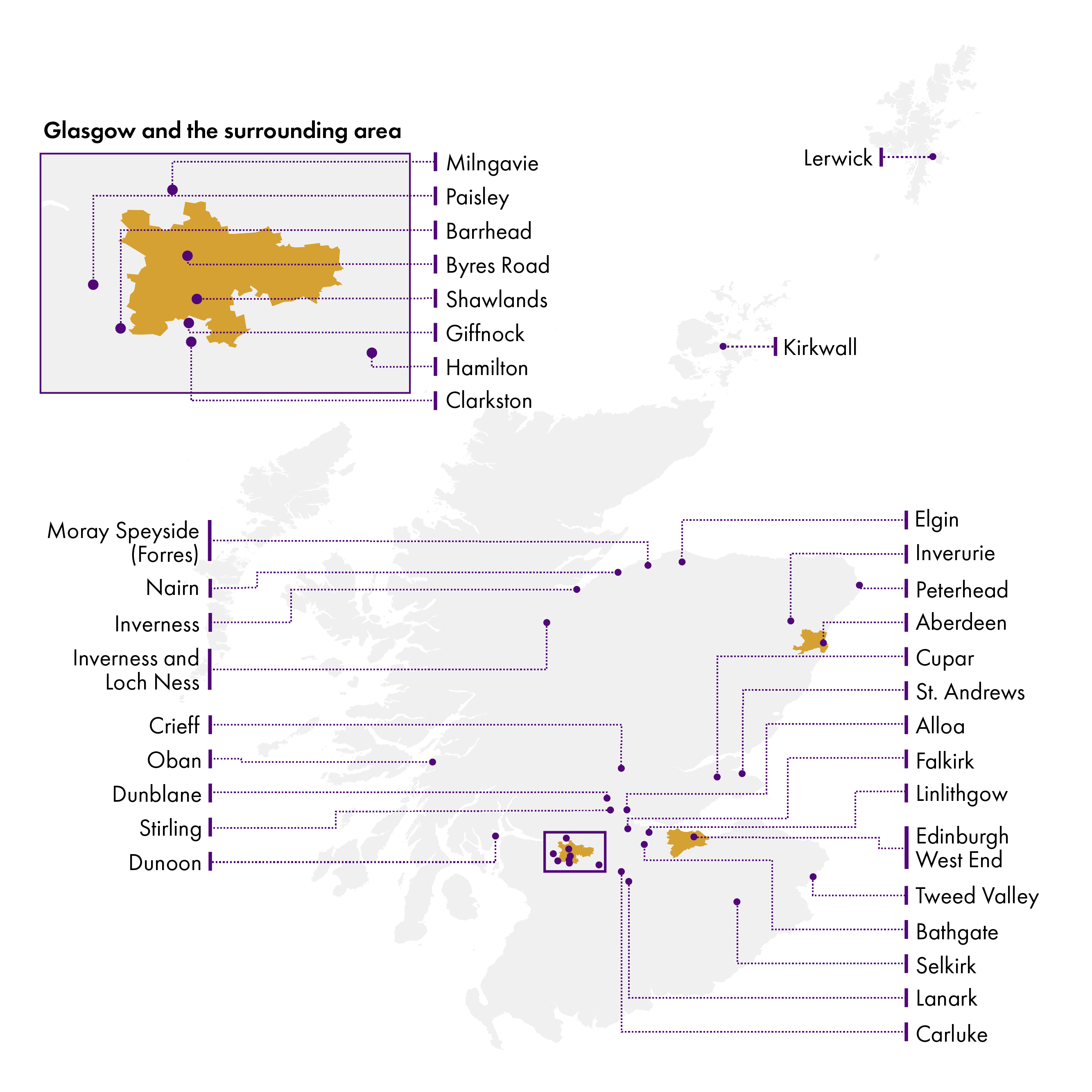
While it is difficult to predict what town centres may look like in the future, it seems probable that we might see fewer large chain stores, more independent and local businesses, more housing, fewer large offices and more local hot-desking/business hubs for office workers who continue work at home for part of the week. However, such development will only happen where it is commercially viable or is supported by the public sector.
The changing face of devolution and scrutiny
Sarah Atherton, Senior Researcher, Constitution
Constitutional politics is set to dominate Session 6. Even without the question on independence, the devolution settlement is seemingly increasingly fractured in the wake of the UK’s departure from the EU. This chapter explores some of the key constitutional issues which are likely to come before the Session 6 Parliament.
A second referendum on independence
It is difficult to envisage a situation where the question over Scotland’s constitutional future is not considered by the Parliament given the pro-independence majority.
Work in advance of a second referendum on independence has already been undertaken. The Scottish Government published a draft Scottish Independence Referendum Bill in March 2021, fulfilling its commitment made in the 2021 Programme for Government. Scotland already has a legislative framework for referendums held within the competence of the Scottish Parliament. This framework was established by the Referendums (Scotland) Act 2020.
The March 2021 draft Independence Referendum Bill envisaged that a future referendum would be held under the framework established by the Referendums (Scotland) Act 2020. As such, the referendum would need to be within the competence of the Scottish Parliament.
At the 2014 independence referendum, a section 30 Order (a type of subordinate or secondary legislation made under the Scotland Act 1998 to increase or restrict – temporarily or permanently – the Scottish Parliament’s legislative authority) was used to temporarily put a referendum on independence within the competence of the Scottish Parliament. It is likely that this route would again be favoured by the Scottish Government as it puts the legal basis of a referendum beyond legal doubt. To date, however, the UK Government has refused to consent to a Section 30 Order for a second referendum. Section 30 Orders can be initiated either by the Scottish or UK Governments but must be approved by the House of Commons, House of Lords and the Scottish Parliament.
Earlier in 2021 the SNP published a document ‘The Road to a Referendum that is Beyond Legal Challenge’. The options it sets out were echoed in the SNP 2021 manifesto - if the UK Government opposes a section 30 Order, the Scottish Government would introduce legislation which, if the UK Government challenged in the Supreme Court, the Scottish Government would defend.
There is little doubt that the referendum question will be one which comes before the Session 6 Parliament. The greater uncertainty is perhaps the timing of any referendum given the focus on COVID-19 and post-pandemic recovery.
The evolution of devolution
For years, devolution in Scotland could be understood by reference to the Scotland Act 1998. Over time this became more complicated with the passing of the Scotland Act 2012 and the Scotland Act 2016. With the UK’s departure from the EU, the European Union (Withdrawal) Act 2018, the European Union (Withdrawal Agreement) Act 2020 and the United Kingdom Internal Market Act 2020 all also need to be understood .

The result is that devolution is now much more complex and challenging to understand. The Session 6 Parliament will have to work to become familiar with the legal and practical implications of the UK’s exit on the framework of devolution.
The Parliament will need to be more aware of the effect of UK legislation on devolved areas, including the extent to which it constrains the powers of Scottish Ministers. This is because the powers of Scottish Ministers in many significant policy areas previously within the competence of the EU are now shared with UK Ministers. There is also more delegated legislation at a UK and Scottish level anticipated as a result of Ministers’ powers in the EU Withdrawal Agreement Act and other Brexit related legislation which will require scrutiny.
The impact of the United Kingdom Internal Market Act 2020 is likely to be felt in Session 6. The market access principles in the Act have the potential to undermine devolution by reducing the impact of devolved legislation. Before the Act came into force, Scottish legislation applied to all goods and services within Scotland. The UK Internal Market Act 2020 means that goods and services produced in Scotland will be subject to Scottish legislation but those coming into Scotland from elsewhere in the UK will not be so long as they meet any regulatory standards agreed between the UK nations.
There will be a need to scrutinise inter-governmental agreements in the form of common frameworks. These agreements will decide policy and the Parliament will want to ensure that they receive due scrutiny. In some cases, frameworks may have a legislative basis, but many will be non-legislative and will require a different approach to scrutiny. Similarly, the Parliament may have a greater eye on inter-governmental relations given the importance of these agreements. There may also be an emphasis on inter parliamentary relations as legislatures across the UK face similar scrutiny challenges.
Given that Scottish Ministers also have the power, under the UK Withdrawal from the European Union (Continuity) (Scotland) Act 2021, to use secondary legislation to keep pace with EU law in devolved areas, the Parliament will need to be aware of policy developments at an EU level. Such awareness will be needed not only to scrutinise the use of the keeping pace power by Ministers but also to scrutinise where Ministers decide not to exercise the power.
The Parliament will also need to be aware of the impact of any future trade agreements and their impact on devolved areas.
Members and committees are likely to need to find their feet on these matters quickly, but they are complex and numerous. It remains to be seen whether the new framework governing devolution holds or if the fall out from the UK’s exit from the EU fractures the settlement to such a degree that there is a breakdown of consensus about the functioning of devolution. If the settlement does fracture, and a referendum delivers a ‘no’ vote, the Session 6 Parliament may find itself in the position of being an architect of a new devolution settlement for the post-Brexit era.
All eyes on Glasgow – what COP26 means for Scotland and the Parliament
Alasdair Reid, Senior Researcher, Climate Change
In November 2021 up to 30,000 delegates and 200 world leaders are expected to attend COP26 in Glasgow, which is set to be the largest political summit that the UK has ever hosted.
The United Nations Framework Convention on Climate Change (UNFCCC) was adopted in 1992. It has been ratified by 196 States (including both the EU and the UK) which constitute the “Parties” to the Convention. The objective of the Treaty is to “stabilize greenhouse gas concentrations in the atmosphere at a level that would prevent dangerous anthropogenic interference with the climate system.” Every year a Conference of the Parties takes place (known as COPs).
COP26 is the most important gathering on climate change since the Paris COP in 2015, with the talks widely considered to be the last opportunity to deliver on commitments to keep global temperature rise to within 1.5 – 2°C. COP26 also offers a crucial opportunity to address how a just, resilient and green recovery from Covid-19 is delivered.
The following infographic shows global warming projections to the end of the century under a number of different scenarios:
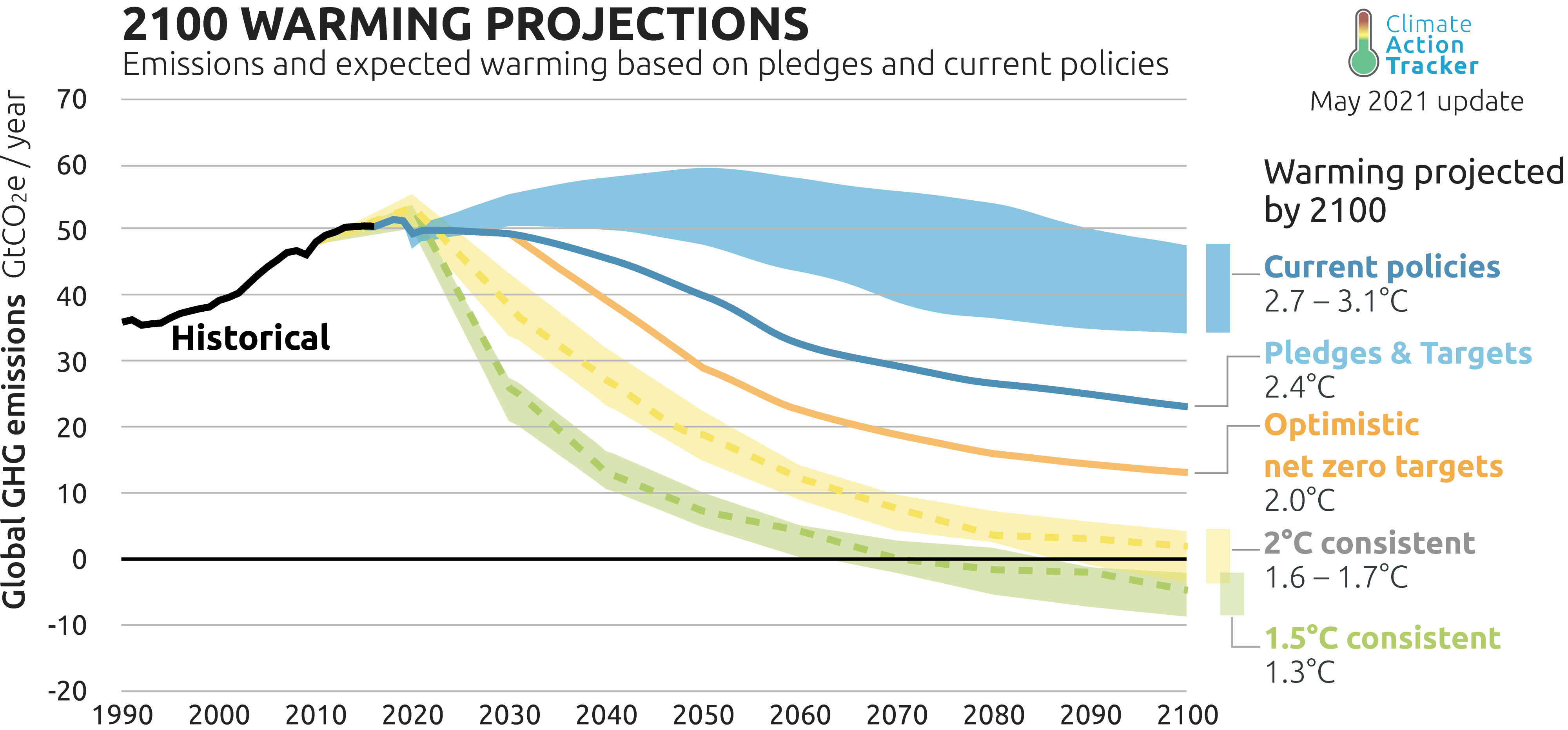
What are the key aims of the summit?
The UK and Italy are joint hosts of COP26 with Italy hosting pre-COP events, and the UK hosting the main negotiations, as well as assuming the COP Presidency at the opening of the event.
An encouraging number of net zero targets are being set by national, regional, local and city governments, businesses, universities and third sector organisations. COP26 is widely considered to be an opportunity for more commitments to be made, and for ensuring targets are backed up by plans for delivery. See our overarching theme for an introduction to the climate and nature emergency.
On 12 April 2021 the UK’s President Designate of COP26 Alok Sharma MP wrote to all parties of the UNFCCC recognising the “clear unity of purpose” and “specific priorities” that have repeatedly been referenced in his discussions. He also noted the “unprecedented negotiations agenda, incorporating unresolved issues from COP25”, the most commonly referenced priorities include:
Full implementation of the Paris Agreement from COP15 including adopting common timeframes for action as well as transparency on action.
Demonstrating tangible progress towards climate change adaptation, including a significant increase in adaptation finance.
Delivering on the Paris goal of mobilising US$100 billion per year by 2020 for climate action in developing countries.
Ensuring that COP26 takes into account and responds to any gap between the collective impact of Nationally Determined Contributions and what is required to limit global temperature rise to within 1.5 – 2°C. As Scotland is part of the UK, it cannot formally submit an NDC, however the Scottish Government has undertaken to publish an indicative one which will centre on “Scotland’s world-leading target to reduce emissions by 75% by 2030”.
Agreeing a programme of work on Action for Climate Empowerment (including a Gender Action Plan) and improved partnership working to enhance collaboration between governments and other stakeholders to enable and accelerate universal action.
What role do parliaments have?
Parliaments have a critical and ever-increasing role to play in these global emergencies – effective law making, scrutiny and budget approval is imperative in ensuring the targets and commitments made by governments are delivered.
COP26 allows for the sharing and showcasing of best practice to help parliaments around the world ensure that governments are being ambitious enough and holding them to their promises.
Alongside the formal talks, there are significant opportunities to explore and highlight the unique role of parliaments, and related opportunities for legislators to work together to drive international and domestic action.
The Scottish Parliament, which has previously demonstrated cross-party consensus on the need for more climate action, will host an International Legislators’ Summit to discuss the climate emergency on 5 and 6 November 2021. Parliamentarians from around the world will convene to discuss “accelerating climate action and delivering a green, fair and resilient recovery”. Further events are also planned at the summit itself.
Scottish Parliamentary scrutiny to date
In Session 5, the Environment, Climate Change and Land Reform Committee (ECCLR) agreed a series of key objectives for engagement with COP26, including to:
improve scrutiny of climate change by learning from international best practice
develop lasting partnerships with national and international organisations and legislatures to support climate change work over the coming decade
support operational work to scrutinise climate change work
co-ordinate, plan and deliver further opportunities offered through COP26 engagement as the UK retains the COP26 presidency into 2022.
At the penultimate meeting of ECCLR in Session 5 the Scottish Government’s developing plans and key priorities for COP26 were scrutinised. The Scottish Government has two key themes and four aims for COP26. Key themes are People and a Just Transition, and the four aims are:
A safe, secure and successful event in Scotland.
Scotland plays its full part in securing an ambitious and deliverable global deal at COP26.
COP26 fully contributes to Scotland meeting Net Zero through a Just Transition.
COP26 enhances Scotland’s place in the world and attracts innovation, investment and builds even more effective partnerships that bring benefit to Scotland, our people and our goals.
ECCLR’s Legacy Report to its successor committee recommended that the Scottish Parliament set up a Net Zero Committee to lead and drive climate change scrutiny and action in the next session.
Establishing a Net Zero Committee in advance of COP26 could have a global impact, encouraging other legislatures to look at how climate scrutiny is organised, supported and delivered. The concept of a Scottish Parliament Net Zero Committee was endorsed by the independent UK Climate Change Committee (CCC) and could have a clear mandate as a connecting, strategic committee, considering the alignment of key government strategies across portfolios with net zero goals.
Green Recovery
Effective routes to a green recovery across all nations will underpin the discussions at COP26. ECCLR conducted extensive work on Scotland’s path to a green recovery, and argued that this should be about building a more resilient Scotland, ensuring it is better equipped to deal with multi-faceted and complex shocks and challenges e.g. pandemics, climate change, biodiversity loss and geopolitical change - and to deliver a more just, equitable and healthy society and environment.
The emergence from Covid-19 offers opportunities to build more resilient, climate efficient communities. However much better policy coherence is necessary, as well as the proper and far reaching implementation of existing, known remedies.
Directly related, ECCLR found that sustainable development principles, and those of the UK CCC, were imperative but that the principles that underpin a green recovery need to go further:
A just transition must be at the heart of the green recovery, prioritising the most vulnerable and those whose paid employment is likely to be adversely affected by the transition. A wellbeing approach is necessary… and we need to further embed a human rights based approach to recovery, underpinned by the key principles of participation, accountability, non-discrimination, empowerment and law.
A truly global green recovery requires collaborative work to develop shared understandings of how to accelerate climate action and deliver a green, fair and resilient recovery. COP26 provides a critical forum to develop these bonds. Gillian Martin MSP, the former convener of ECCLR recently stated:
COP26 provides an opportunity to shine a light on the necessary contribution of parliaments in the climate and ecological emergencies – but also to candidly share where we must do better, and how we can do so. The International Legislators’ Summit at the Scottish Parliament provides an invaluable – and unique – opportunity to facilitate collaboration, open communication and shared learning. It is only by working together, across borders, that we can effectively meet the climate challenge.
Sowing the seeds of a new rural support policy
Anna Brand, Senior Researcher, Agriculture, Rural Affairs and Fisheries
Within the rural policy sector, the question of what happens after Brexit dominated Session 5 of the Scottish Parliament. Agriculture, forestry and environmental management have been heavily influenced by EU regulations and EU financial support, in large part through the Common Agricultural Policy (CAP).
While a member of the EU, the UK was part of the CAP. Participation in the CAP provided over £500m for Scottish agriculture, forestry, and environmental interventions per year. The CAP is split into two ‘pillars’.
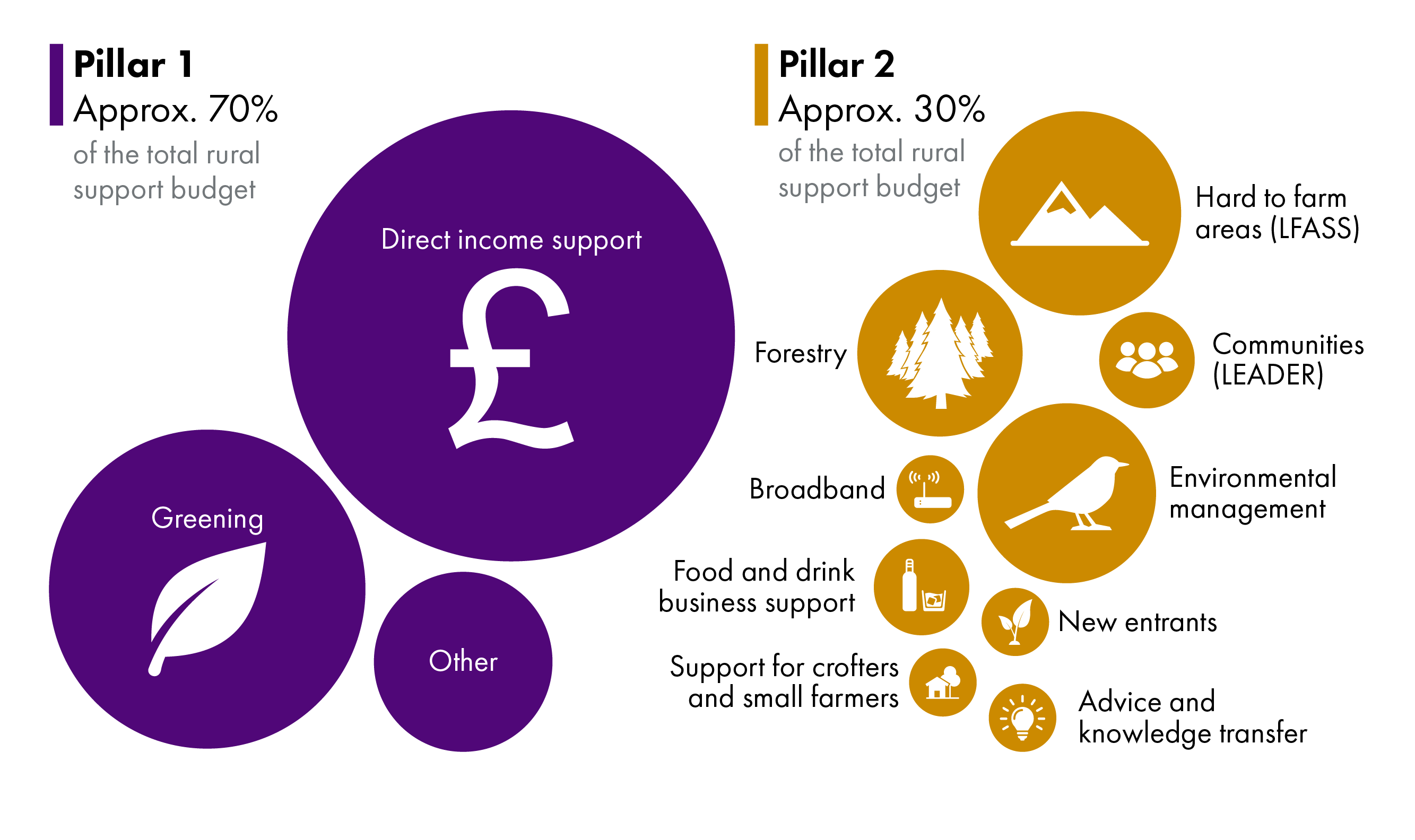
The CAP provides income support for agriculture and financial support for rural development. It is governed by an extensive set of regulations, for example around how agricultural support must be financed and run. CAP regulations also create a level playing field; all EU farmers receiving CAP support must comply with rules on the environment, animal welfare and food safety - so-called cross-compliance rules.
Post-Brexit, UK nations are no longer required to follow CAP rules nor do they receive CAP support payments. Agriculture is a devolved policy area, therefore Scotland can decide on a new policy for Scottish farmers and crofters.
The Scottish Government’s approach has centred around a period of ‘stability and simplicity’ – a transition where existing rules will be largely maintained in the short term but simplified where feasible. A consultation held in 2018 set out proposals for this period of little change to 2024, whilst a new policy is being developed to be rolled out from 2025. This is therefore likely to be a key issue for Session 6.
CAP rules largely continue to apply in Scotland, as they have been ‘retained’ as part of a new category of law called ‘retained EU law’. New legislation – the Agriculture (Retained EU Law and Data) (Scotland) Act 2020 – provided Scottish Ministers with the power to, by regulation, simplify and improve the operation of the retained CAP rules in Scotland until 2026. The Scottish Government used these powers to, for example, make changes to the greening rules.
During Session 5, the policy space was crowded with stakeholder proposals (including from the Scottish Wildlife Trust, the National Farmers Union for Scotland, Scottish Environment LINK, and Scottish Land & Estates), research, and pilots (e.g. trialling an ‘outcome-based approach’ to delivering environmental benefits). The Scottish Government convened several groups which made recommendations, including four Agriculture Champions, a National Council of Rural Advisers, a Farming and Food Production: Future Policy Group (yet to report), and latterly, sectoral groups focused on policy solutions to climate change (on suckler beef, dairy, hill, upland and crofting, pig industry, and arable sectors).
Links to other policy areas
Outcomes in several policy areas depend on a new rural policy, for example:
Climate change: the Scottish Government declared a climate emergency in Session 5. The Scottish Government’s most recent update to its climate change plans relies on a new policy to deliver commitments on agriculture and land use. For example, a new rural support policy is a key proposal to deliver “a more productive, sustainable agriculture sector that significantly contributes towards delivering Scotland’s climate change, and wider environmental outcomes”. See the chapter on COP26 for more information.
Biodiversity: agriculture and other land uses remain key pressures on biodiversity. Elements of the CAP are found to have inadequately protected biodiversity and underfunded environmental interventions, but farmers and crofters, and agricultural policies and support are also key to approaches to halt and reverse biodiversity decline. The Scottish Government’s statement of intent on the Post-2020 Scottish Biodiversity Strategy states: “We are already working in partnership to develop new rural support measures that result in transition to a sustainable sector that more directly and explicitly supports our climate and environmental ambitions.”
Strategic land use: Many demands are placed on land, resulting in both a national Land Use Strategy (which is currently in its third iteration) and proposals for Regional Land Use Partnerships aiming to maximise the benefits from land. Mechanisms under a new rural policy will influence how this is achieved.
Land reform: Recent work by the Scottish Land Commission on scale and concentration of ownership noted that the “fiscal environment surrounding agriculture, forestry, and renewable energy in particular appears to incentivise behaviour that is sometimes contrary to Scotland’s land reform objectives” and recommended that relevant fiscal incentives should be reviewed to ensure consistency with the “policy objectives of community empowerment, rural development, and land reform”.
Food and Drink: Scotland has a target to double the value of its food and drink industry by 2030. Meanwhile, industry has been affected by both Brexit and the Covid-19 pandemic, prompting the publication of an industry recovery plan, which includes discussions of resilience within food production sectors. It also links to Scotland’s overall food policy; any future rural policy will be key to Scotland’s food policy from farm to fork. See our dedicated chapter on food policy for more information.
Resilience of rural communities: The extent of support for, e.g. new entrants to farming and crofting, to crofting communities, and to support women in agriculture through a new rural policy can have a wider impact on resilience in rural communities and diversity in the agricultural sector.
Post-Brexit: Rural policy across the UK
England, Wales and Northern Ireland have also been developing new rural policies. For England, the Agriculture Act 2020 led to the development of new ‘Environmental Land Management Schemes’ as the basis for its post-CAP policy. The new approach focuses on the principle of ‘public money for public goods’ – supporting farmers to deliver environmental and animal health and welfare benefits – alongside support to improve productivity, a new approach to regulation, and ultimately phasing out direct income support and existing CAP schemes between 2021 and 2027.
In Wales, a consultation on a new legislative framework for land use proposed the replacement of existing schemes with a new payment scheme on sustainable farming practices, with wider support for supply chain and agri-food development. In Northern Ireland, a future agricultural policy is yet to be consulted on, but an announcement on its development and on short-term changes was made in November 2020.
Whilst agricultural policy is devolved, what happens across the UK may impact the development of Scotland’s rural policy. For example, the UK Internal Market Act 2020 reserved subsidy control to the UK Government, and a consultation published on 3 February 2021 asked for views on whether agricultural subsidies should be in scope for new domestic subsidy control arrangements. The proposal has been met with some concern that it would limit options within a devolved area. Moreover, evolving ‘common frameworks’ – e.g. on Agricultural Support – coordinating policy approaches across the UK may also influence outcomes. The outcome of conversations on Scotland’s constitutional future could also present another turning point: should Scotland vote for independence and elect to re-join the EU, re-joining the CAP is unlikely to be negotiable. More information on the post-Brexit constitutional framework is available elsewhere in the briefing.
As such, the shape of a new rural policy for Scotland will be a key issue for Session 6, impacting the outcome of other policy commitments, whilst being a key testing ground for the development of the UK internal market post-Brexit.
Turning the tide – Scotland’s blue economy
Damon Davies and Roxana Shafiee, Researchers, Marine Environment
Scotland’s sea area is vast, making up 62% (462,263 km2) of the UK’s waters and 8% (19,000 km) of Europe’s coastline. Our seas provide huge economic potential for fishing, aquaculture, energy and tourism industries. The marine environment also provides significant capacity for natural and industrial carbon sequestration as well as habitats for marine biodiversity. This includes internationally important areas for many species.
But these competing uses present huge challenges for the Scottish Government in protecting and enhancing Scotland’s diverse marine ecosystems while ensuring sustainable economic opportunities for communities and marine industries.
A key challenge for the Scottish Parliament in Session 6 will be to assess whether the Scottish Government takes an integrated approach to marine and fisheries policy, linking to wider policy goals for a Green Recovery from the COVID-19 pandemic. See our chapters on, for example, the climate and nature emergency and COP26 for more information.
Opportunities for scrutiny
An important opportunity for scrutiny may be provided by the commitment to introducing a ‘Blue Economy Action Plan’ promised in the Climate Change Plan update. Details on the Blue Economy Action Plan have so far been high-level. The previous Scottish Government stated that the Plan will
set out clear actions to strengthen the resilience of our marine industries;
as well as:
recognising the vital importance to our marine economy of the abundant natural capital in Scotland’s seas and rivers.
The previous Scottish Government also published its review of the National Marine Plan ahead of the election campaign period, as required by the Marine (Scotland) Act 2010. This key policy document sets the framework for managing marine activity to ensure the protection and enhancement of the marine environment and sustainable development of marine industries.
An early task for Scottish Minsters in Session 6 is to consider this review and decide whether the National Marine Plan will need amending or replacing. The review identifies a clear need to replace the Plan considering significant national and global developments since its publication in 2015, such as:
EU exit
the impact of the climate change on marine ecosystems
the socio-economic impact of the coronavirus pandemic.
Reversing marine ecosystem decline
Scotland’s marine environment faces many pressures, such as:
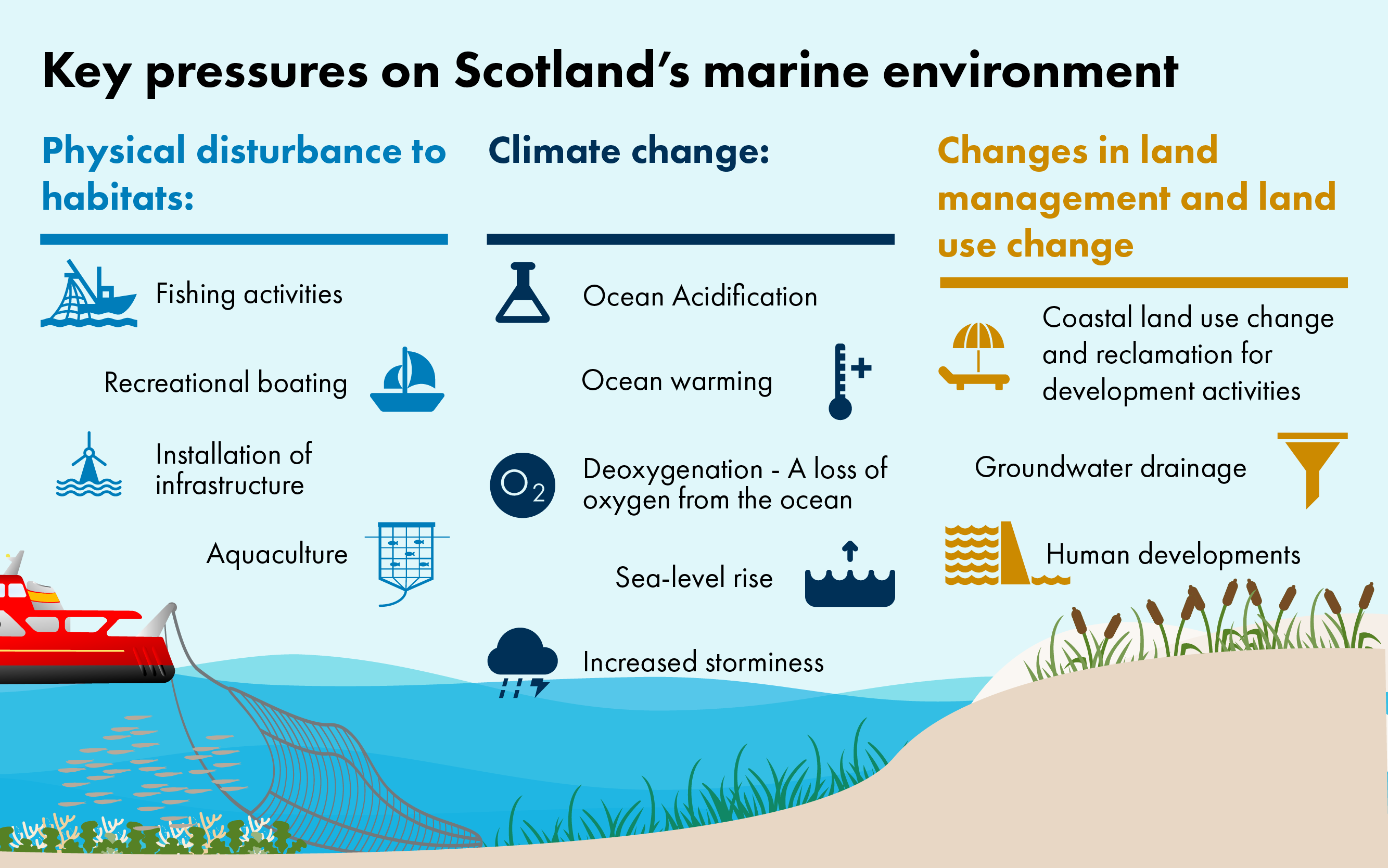
Scotland is also failing to meet international targets on marine biodiversity and the UK as a whole is failing in most indicators for achieving ‘good environmental status’ in UK seas.
The Marine (Scotland) Act 2010 requires the Government to protect and enhance the health of the Scottish marine area, and to assess its condition. The most recent Marine Assessment was published in 2020. It highlighted pressures associated with non-indigenous species, climate change and ocean acidification. Pressures associated with bottom-contacting and pelagic (mid-water) fishing were cited as being the most geographically widespread.
In Session 5, there was good progress in expanding the network of Marine Protected Areas in Scotland’s waters. The network now covers approximately 37% of Scotland’s seas.
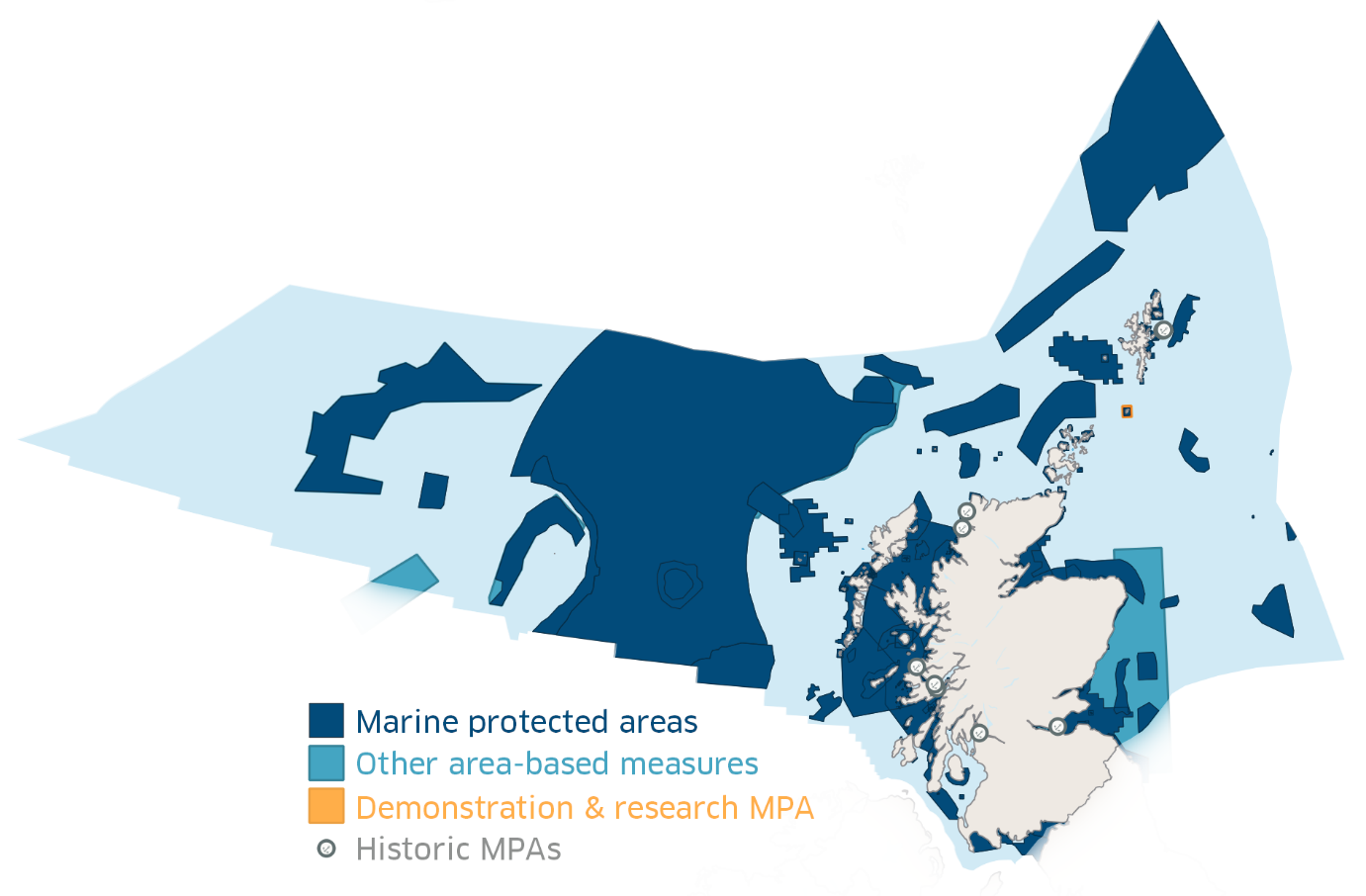
However, Marine Protected Area designations alone do not offer protection to vulnerable habitats from potentially damaging activities such as bottom trawling and dredging. Fisheries management measures are required.
A recent report by the Marine Conservation Society estimated that bottom trawling takes place in 98% of the UK’s offshore Marine Protected Areas and there has been growing pressure from environmental groups campaigning for greater protection for the seabed in inshore regions. This has increased tension between these groups and the inshore trawling and dredging fleet, who are concerned their livelihoods are under threat.
The Scottish Government has introduced some fisheries restrictions in inshore Marine Protected Areas such as the Lamlash Bay No Take Zone, the Lochcarron Marine Protected Area and recent action to protect endangered Flapper Skate within the Inner Sound of Skye.
Reversing marine ecosystem decline in Scotland’s waters will likely require further protection measures. The challenge will be ensuring a collaborative approach among marine stakeholders with conflicting interests and views.
A (Blue) Green Recovery for coastal communities
Scotland’s coastal communities have been hit hard by the combined impacts of EU exit and COVID-19. The Scottish seafood industry relies heavily on exports to the EU and suffered lengthy border delays from late 2020 and into 2021 caused by COVID-19 restrictions and new post-Brexit export requirements. Seafood markets have collapsed due to the impact on the hospitality sector and tourism to rural coastal regions has been severely affected.
The anticipated boost in fishing opportunities delivered from EU exit was not as lucrative as many in the fishing industry hoped and campaigned for. Furthermore, the oil and gas industry - which is a key source of employment and economic activity - is facing the challenge of achieving a just transition to a net-zero economy.
These factors leave coastal communities in stormy waters. But the expansion of marine industries, particularly marine renewables, may put coastal communities at the heart of a Green Recovery.
A key issue for Session 6 will be ensuring that the expansion of marine industries brings sustainable economic opportunities in coastal communities in a way that is compatible with addressing the twin climate and nature crises. In Session 5, the Environment, Climate Change and Land Reform Committee identified Regional Marine Planning as a potential key driver in delivering these aims and enabling local input into coastal development.
EU exit also provides an opportunity for an overhaul in fisheries management to deliver a more equitable share of fishing opportunities across the Scottish fleet and ensuring the protection of marine ecosystems. In the coming Session, the Scottish Parliament may wish to consider whether the Future fisheries: management strategy - 2020 to 2030 is compatible with a Green Recovery. There will also be a role for the Parliament in scrutinising UK frameworks for fisheries management through the development of Joint Fisheries Statements and Fisheries Management Plans.
Integrating blue carbon into marine and climate change policy
Blue carbon refers to carbon that is sequestered (captured) and stored in coastal and marine environments. Scotland’s blue carbon environments store 9,636 megatonnes of carbon dioxide equivalent (Mt CO2-eq), which exceeds the carbon stored in Scotland’s land-based ecosystems (9, 546 Mt CO2-eq) such as peatlands, forestry and other soils. Sediments that cover Scotland’s seafloor sequester and store the majority of Scotland’s blue carbon (>99%), with the remaining carbon stored in saltmarshes, seagrasses, biogenic reefs (e.g. maerl beds) and machair.
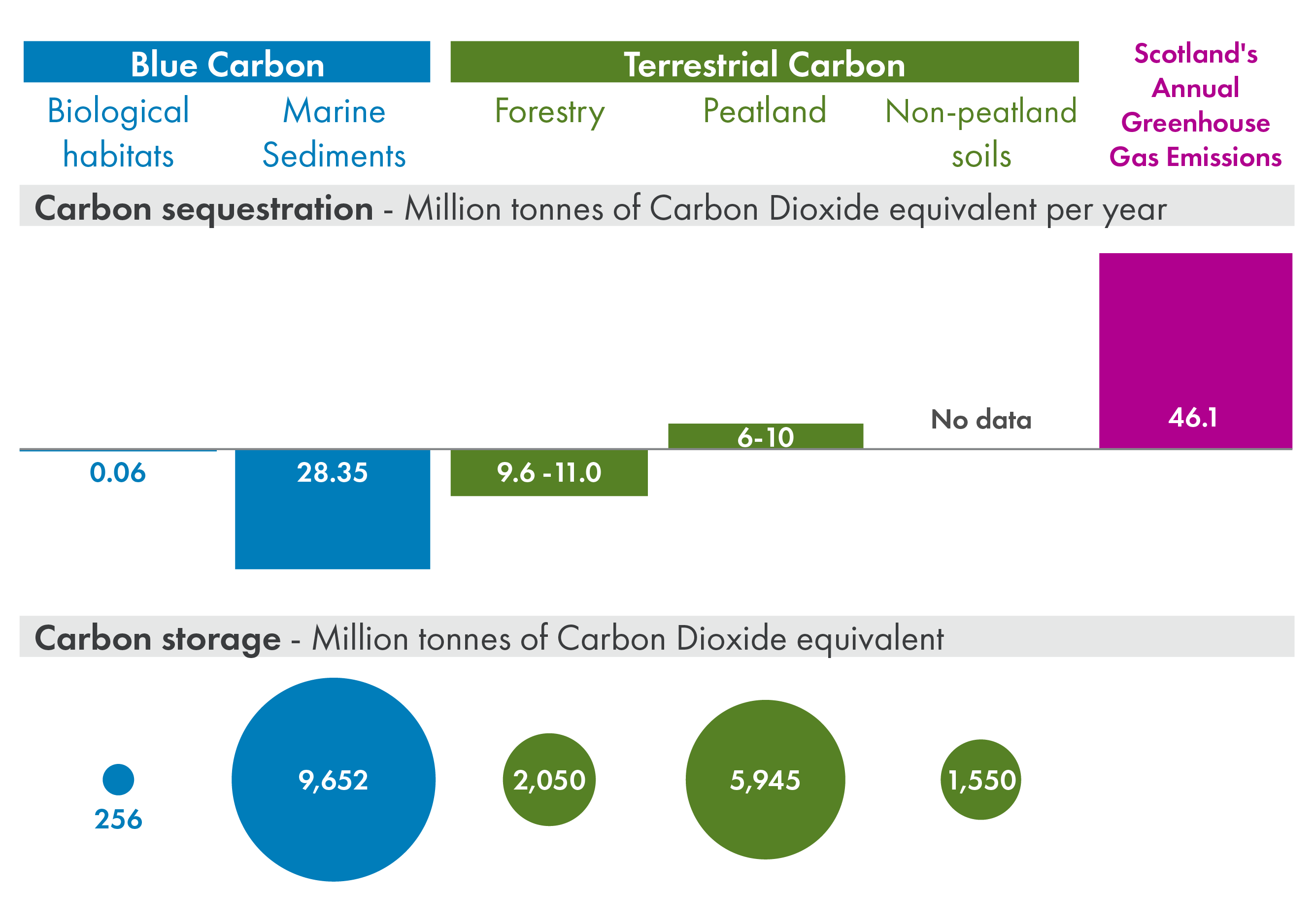
The main threats to Scotland's blue carbon are physical disturbances (e.g. bottom-towed fishing), climate change, and land-use and land management changes. If unprotected from threats, blue carbon habitats may release their stored carbon and be unable to sequester carbon in the future.
Blue carbon policy is less developed compared to policy on terrestrial environments. Some Scottish blue carbon habitats are protected from threats based on their contributions to Scotland's biodiversity in the form of Marine Protected Areas and Priority Marine Features.
There are currently no Marine Protected Areas designated purely or partially on the basis of protecting carbon stores, but there are opportunities for Scottish ministers to do so under the UK and Scottish Marine Acts and Climate Change legislation. The potential replacement of the National Marine Plan presents an opportunity for Scottish Ministers to update and develop new policies to protect blue carbon based on climate change mitigation.
Food Policy in Scotland: Where next for the Good Food Nation?
Anna Brand, Anne Jepson, Lizzy Burgess, Nicki Georghiou and Camilla Kidner, Senior Researchers
Food, and access to it has been high profile in recent times – with production, supply and choice affected by Covid-19 and Brexit. This has happened against a backdrop of evolving food policy in recent years. Progress toward a Good Food Nation Bill – overarching framework legislation on food - was paused early in the pandemic, and Session 5 ended with outstanding commitments. A key issue for Session 6 will be how the Scottish Government approaches food policy in the round. Food is such a cross-cutting topic that it relates to a wide range of other chapters in this briefing, on the climate and nature emergency, rural support policy and COVID recovery.
Where does food fit?
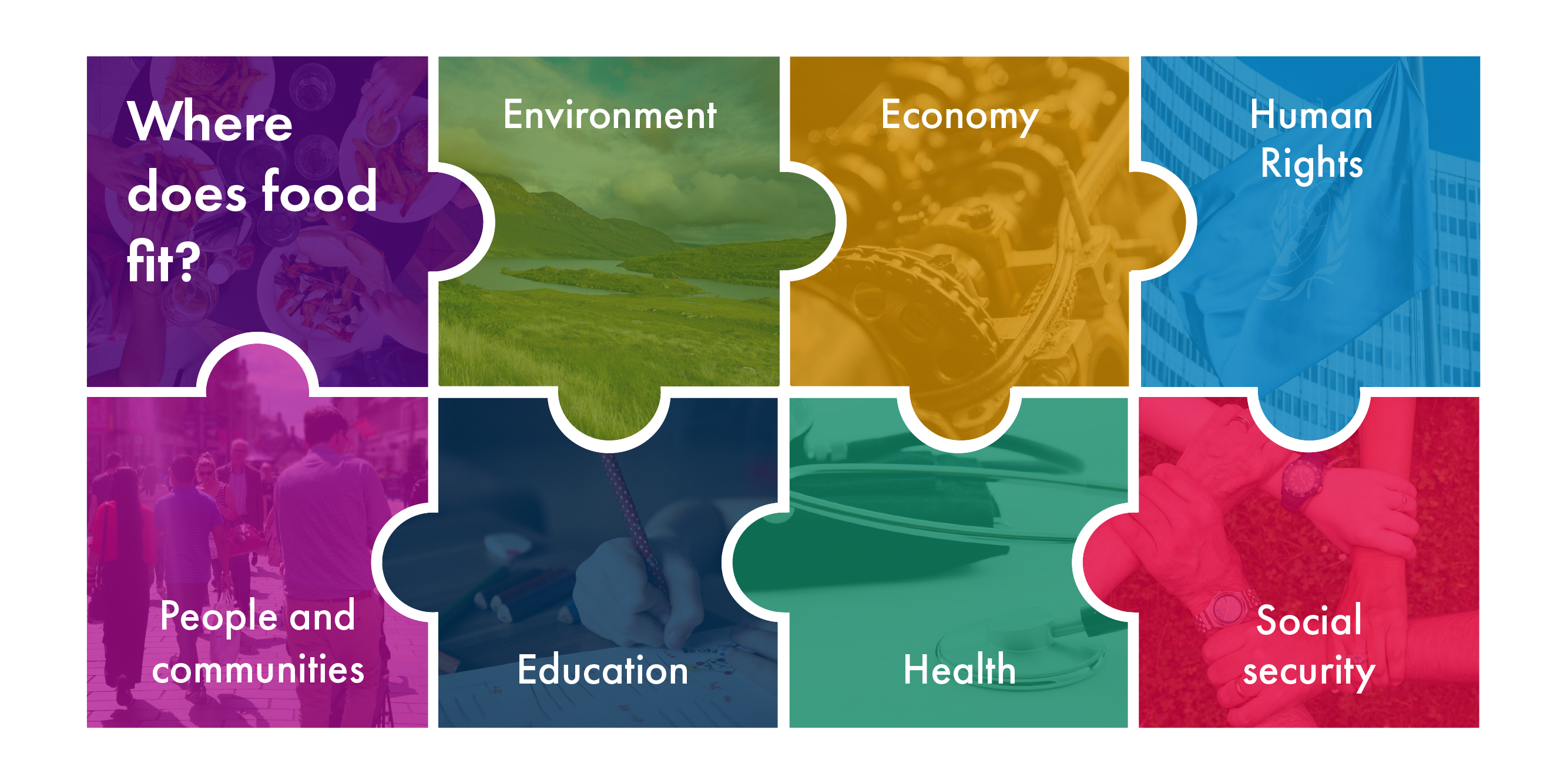
Food affects people in many ways and affects overall outcomes in a large number of different policy areas. These include:
Health: Diet affects health; Scotland has consistently missed its dietary goals. This relationship is complex: poor diet no longer means a lack of calories (cheap, processed food can be calorie rich, and high in e.g. salt, fat and sugars) but can be related to a lack of availability and access to more nutritious foods that are less processed. In addition, objectives are sometimes in conflict. Greater food processing adds economic value for processors and retailers, while overconsumption of highly processed foods can contribute to poorer health outcomes. Diet is also linked to health inequalities. People with higher socio-economic status are in a position to make healthier food choices, with the burden of diet-related disease falling disproportionately on the most deprived groups. But this too is a complex area for research with multiple factors at play.
Economy: Food and drink production, including farming, crofting, fishing, and manufacturing is worth approximately £14bn per year, and is Scotland’s top international export sector. Ambition 2030, Scotland’s food and drink industry growth strategy, aims to double the value of food exports by 2030.
People and communities: The food and drink sectors account for 4.7% of Scottish employment. Primary production (farming, crofting, fishing) is central to many communities in rural areas; employment in food and drink-related sectors is highest in Aberdeenshire and Highland.
Environment: According to new research, food systems account for approximately one-third of global greenhouse gas emissions. In Scotland, agriculture is the third-largest emitting sector, comprising 18% of Scottish emissions. Practices in agriculture and fisheries are drivers of biodiversity decline, but primary producers are also key to approaches to halt and reverse biodiversity decline and to reducing emissions from food production. Food waste is another source of greenhouse gases and pressure on the environment.
Education: Healthy school meals generally and free school meals are an important source of food and nutrition for many children.
Social security: Approximately 1 in 10 people in Scotland experience food insecurity (worrying about not having enough food, eating less or going without food due to a lack of money). The pandemic also put a spotlight on food insecurity, which worsened for some people due to economic instability, isolation and lack of or changes to food access and availability.
Human rights: The UN International Covenant on Economic, Social and Cultural Rights (ICESCR) includes a right to an adequate standard of living, including the right to adequate food.
Developing Good Food Nation policy
Scotland’s most recent national food and drink policy – Becoming a Good Food Nation – was produced in 2014.
The document recognised both Scotland’s food production successes, as well as the paradox of Scotland’s “uneasy relationship with food” when it comes to inequality and health, and the impact of food production on the environment.
As part of the strategy, a non-statutory Scottish Food Commission was established in 2015. In 2017, it recommended that new framework legislation should be brought forward to join up food-related issues across policy areas. The group recommended that it should include statutory duties on public bodies, measures to tackle food poverty, an independent statutory body on food, and measures to improve healthy eating.
At the start of Session 5, the Scottish Government announced intentions to consult on a cross-cutting Good Food Nation Bill. Later the same year, a Short-Life Working Group on food poverty recommended that a right to food should be enshrined in Scots law. In its response, the Scottish Government stated intentions to explore this through the Good Food Nation Bill. A consultation on the Bill was published in late 2018. It did not propose to enshrine the right to food as part of this bill, but rather for it to be considered as part of wider work to incorporate human rights.
In a Good Food Nation:
"It is the norm for Scots to take a keen interest in their food, knowing what constitutes good food, valuing it and seeking it out whenever they can.
People who serve and sell food – from schools to hospitals, retailers, cafes and restaurants – are committed to serving and selling good food.
Everyone in Scotland has ready access to the healthy, nutritious food they need.
Dietary-related diseases are in decline, as is the environmental impact of our food consumption.
Scottish producers ensure that what they produce is increasingly healthy and environmentally sound.
Food companies are a thriving feature of the economy and places where people want to work.
Other countries look to Scotland to learn how to become a Good Food Nation.”
From the Scottish Government’s Good Food Nation consultation
A Good Food Nation Bill was committed to in the 2019-20 Programme for Government; however due to the COVID-19 pandemic, the Bill was postponed on 1 April 2020. Instead, in August 2020, the Cabinet Secretary stated that a statement of policy on food:
will incorporate the experience gained in response to the Covid-19 pandemic, ongoing work under the umbrella of the Good Food Nation policy and, more widely, work such as the EU Farm to Fork Strategy and the UK Government’s National Food Strategy. The intention is that this work will be led by the Ministerial Working Group on Food to ensure that the cross cutting approach that is needed to take forward key aspects of national policy is in place.
The Cabinet Secretary reiterated that work was underway in January 2021, but this was not published before the end of Session 5.
Key issues for Session 6
A key issue for Session 6 will be the approach to food policy taken by the Scottish Government, with the previous government having already consulted on new framework legislation.
There are outstanding commitments, not least the Good Food Nation Bill itself, but also the statement of policy on food, and commitments from the 2020-21 Programme for Government reflecting early experiences in the pandemic, such as a local food strategy.
An overarching food policy will likely be developed alongside other policies and legislation with links to food – for example, replacements to the EU Common Agricultural Policy (CAP) and the EU Common Fisheries Policy (CFP), both of which set frameworks for how food is produced, and its social and environmental outcomes.
Food has also been in focus throughout the Covid-19 pandemic, and the Brexit transition period. The pandemic highlighted fragility in some supply chains as markets closed and habits rapidly changed, and following the Brexit transition period, food and drink exports to the EU fell significantly. An industry recovery plan was published in November 2020, and is in place to guide recovery in the sector.
Finally, the National Taskforce for Human Rights Leadership has recommended incorporation of ICESCR, which includes the right to food, as part of a new statutory framework for human rights in Scotland. The wider proposals on human rights are explored more generally in another section of this briefing.
Driving down driving
Alan Rehfish, Senior Researcher, Transport
The Scottish Government’s draft Climate Change Plan update (CCPu) included a commitment to “reduce car kilometres by 20% by 2030”, from the level recorded in 2019. This commitment was repeated in the SNP manifesto.
Cars were driven a total of 36.747 billion kilometres in Scotland during 2019. A reduction of 20%, 7.349 billion kilometres, would mean taking car travel back to a level last seen in Scotland during 1994.
Since the opening of the Scottish Parliament in 1999, the distance travelled annually by car in Scotland has increased by 14.5%. This trend is predicted to continue for the foreseeable future. Transport Scotland modelling forecasts a 25% increase in car trips and a 37% increase in distance driven (including freight transport) between 2018 and 2037. For more information on the climate emergency see our introductory chapter and the chapter on COP26.
Reducing car travel - what works?
Research indicates that there are two broad approaches to reducing travel by car:
Push (coercive): Measures that directly discourage car use, such as vehicle and fuel taxation, road closures, road pricing, parking controls and reduced speed limits.
Pull (non-coercive): Measures that encourage the use of alternative modes, such as cheaper, quicker or more reliable public transport, park and ride sites, multi-modal ticketing, better cycling facilities and flexible and home working.
Researchers have found that a combination of push and pull measures are necessary to reduce car use. This chimes with evidence given to the Rural Economy and Connectivity Committee by Professor Tom Rye at its meeting of 8 February 2017, where he stated that:
…If we want to focus on and bring about mode shift, we need to improve the alternatives, but I am afraid that all the evidence suggests that we also need to make car use a bit more difficult…What has to be borne in mind is that, if we only improve public transport without making car use a bit more inconvenient, the new passengers on public transport will primarily be people who have been attracted to it from walking or cycling.
How does the Scottish Government intend to achieve the reduction in car travel?
The Scottish Government will set out how it intends to achieve the 20% reduction in the distance travelled by car in a “route map”, likely to be published later in 2021. Michael Matheson MSP, Cabinet Secretary for Transport, Infrastructure and Connectivity was asked to summarise the probable contents of the route map at the Rural Economy and Connectivity Committee meeting of 10 February 2021, where he indicated that:
We will incentivise people to make better use of public transport and will ensure that public transport is decarbonised as much as it can be. We will also consider the use of measures such as workplace parking levies and low-emission zones…20-minute neighbourhoods… bus prioritisation and increasing rail services.
The draft CCPu included a commitment of £50m to support the development of “active travel freeways”, cycle and walking routes that serve town centres and other major trip attractors.
The role of the UK Government
Control over two significant “push” measures, vehicle excise duty and fuel duty, is reserved to the UK Government. The draft CCPu indicated that the Scottish Government would:
…work with the UK Government on options to review fuel duty proposals, in the context of the need to reduce demand for unsustainable travel and the potential for revenue generation.
Fuel duty rates have been frozen by the UK Government for the last 11 years. However, the UK Government Budget 2021 included a commitment that “Future fuel duty rates will be considered in the context of the UK’s commitment to reach net-zero emissions by 2050.” Without change, receipts from fuel and vehicle duties will fall, along with the cost of driving, as the uptake of electric vehicles increases. Possible future scenarios are explored in research, such as that produced by the Institute for Fiscal Studies in 2019.
The impact of COVID-19 on travel in Scotland
Transport Scotland statistics show that travel by car, bus, rail and ferry has been running well below normal levels since March 2020. However, travel by car has been closer to normal levels than any other mode. This is perhaps unsurprising given Scottish Government guidance to avoid public transport for all but essential travel.
It is difficult to predict what these changes in travel patterns, combined with possible increases in working from home, might mean for the longer term while we are still living with COVID-19 and restrictions on travel and activity.
Do other Scottish Government transport commitments support reducing the distance travelled by car?
The Scottish Government is committed to several major trunk road enhancement projects, such as dualling the A9 and A96. Such investment may run counter to efforts to reduce travel by car. The expansion of road capacity can stimulate additional trips by car through a process known as “induced demand”. In addition, cost and travel time are the two most important factors in how people choose to travel. Investment which reduces car journey times, relative to travel by rail or bus, may result in travellers switching from public transport to car, as public transport journey times become less competitive.
Analysis
A full analysis of the Scottish Government’s approach to reducing car travel must wait for the publication of the “route map”. However, it is clear that a step change in action is necessary. The distance driven by car continues to grow and there has been no meaningful switch from travel by car to alternative modes in recent years, as shown below:
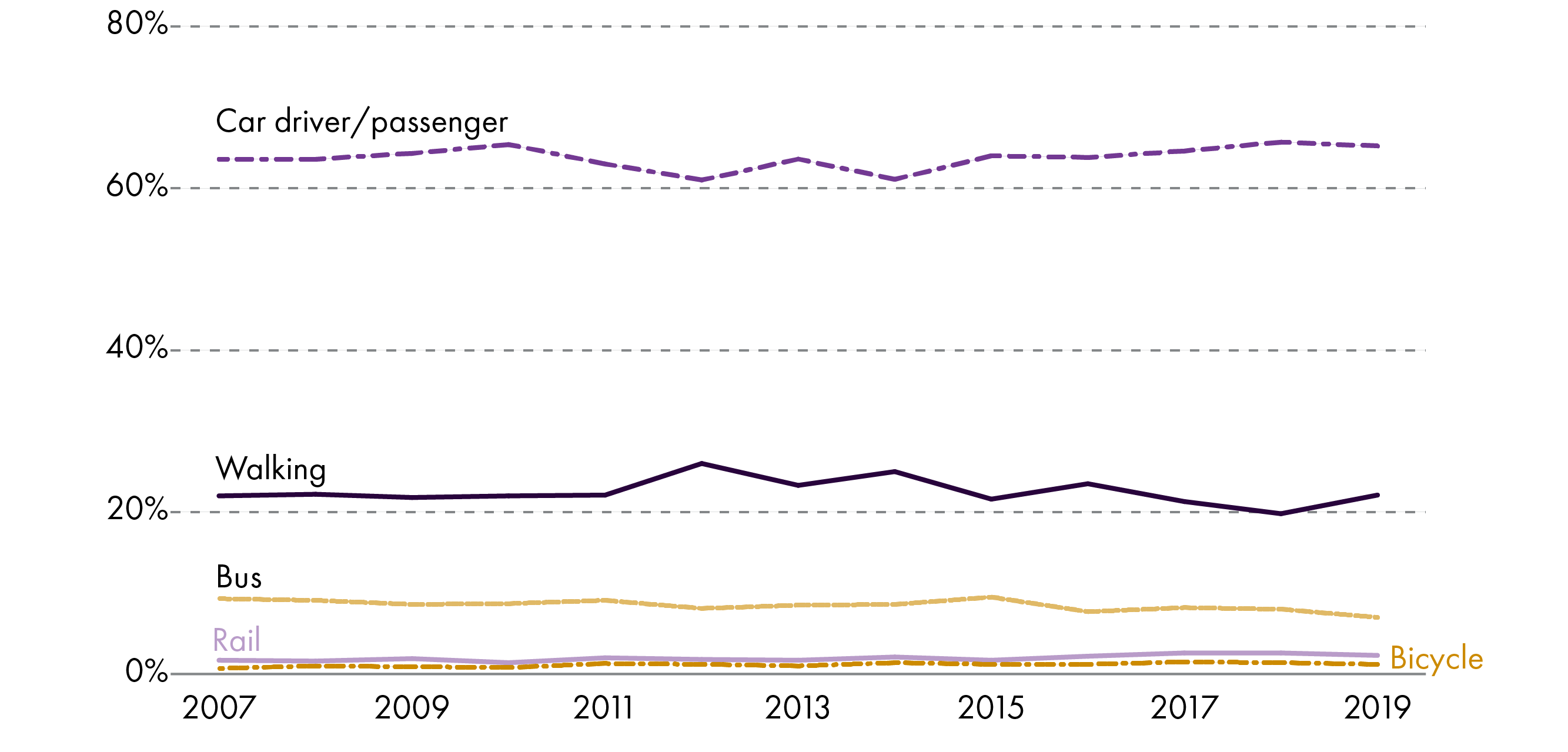
This chart was updated on 17 May 2021.
The reasons behind these travel trends are explored in a SPICe Spotlight post.
To date, Scottish Government policies aimed at encouraging drivers to switch to bus, rail, walking or cycling have fallen into the “pull” category, despite research indicating that a mix of pull and push policies are required for success.
It is noticeable that push policies included in the draft CCPu or mentioned in evidence by the Cabinet Secretary for Transport, Infrastructure and Connectivity are reliant on action by other administrations, including:
The UK Government being responsible for any review of vehicle excise duty and/or fuel duty.
The introduction of a workplace parking levy or Low Emission Zone being a matter for individual local authorities.
Local authorities have shown limited enthusiasm for these measures. Only two authorities (Edinburgh and Glasgow) have indicated any interest in the workplace parking levy and four authorities (Aberdeen, Dundee, Edinburgh and Glasgow) have committed to the introduction of a Low Emission Zone. It is unlikely that such piecemeal, local action would produce a significant reduction in car travel.
Additionally, the Scottish Government’s pursuit of a road building programme that may produce more, rather than fewer, car journeys may make achieving the desired reduction in car travel more difficult. The Scottish Government will also have to carefully manage demand for car travel as we exit the coronavirus pandemic.
During Session 6, the Scottish Parliament will need to:
assess whether the proposals set out in the Route Map will reduce the distance driven by car by 20%
monitor progress and suggest any remedial action required to ensure the target can be met
ensure the policies pursued do not disproportionately impact already disadvantaged groups.
A Scottish foreign policy?
Iain McIver, Senior Researcher, International
Session 5 was dominated by the decision and subsequent negotiations relating to the United Kingdom’s departure from the European Union. Session 6 provides an opportunity for the Scottish Parliament to focus on Scotland’s engagement with both the EU and the rest of the world. For more on the post-Brexit devolution settlement see our introductory chapter.
Should Scotland have a foreign policy?
Although international relations and foreign affairs are reserved competences, successive Scottish Governments have ensured an international presence and pursued a foreign policy. This approach dates back to the first Scottish administration which established an office in Brussels in 1999.
A number of commentators (see Chris Deerin and Gerry Hassan) have argued that Scotland should adopt a distinctive foreign policy aimed at developing Scotland’s profile internationally, irrespective of the debate over independence.
This would be to pursue its own external interests and seek the economic and political benefits that might accrue from better international engagement. For example, Chris Deerin, from Reform Scotland, argued that Scotland needs a foreign policy and that having one is “simply a matter of economics, good government and soft power”.
Research by the British Council set out what “soft power” is and why it is important:
Soft power builds a country or a region's attractiveness and influence through culture, public diplomacy and positive global contribution. Countries, regions and cities around the world are using soft power to improve international relations and bolster trade and tourism.
In this research, the British Council found that Scotland ranks second overall in its review of ten regions around the world and their soft power influence. It found that Scotland’s greatest soft power resources include Education, Enterprise and Digital - where it ranks first of these ten regions.
What kind of foreign policy?
A Scottish foreign policy is likely to focus on achieving influence on a small number of significant issues rather than seeking influence in a wide range of areas. For example, the previous Scottish Government sought influence on the global stage through telling the story of Scotland’s climate change legislation. Our chapter on Glasgow’s hosting of the COP26 summit this November shows how the summit is another opportunity to present Scotland’s approach to climate change to the world.
Another area Scotland has sought to develop an expertise in is conflict resolution through groups such as Beyond Borders Scotland which is “dedicated to facilitating international dialogue and cultural exchange between nations”.
In their election manifestos, the Scottish National Party, the Scottish Labour Party and the Scottish Liberal Democrats all committed to establishing a Scottish Council for Global Affairs (SCGA). The objective of such a body would be to develop Scottish policies and a Scottish approach to international issues. A blog for the Centre on Constitutional Change set out why an SCGA would be beneficial:
In the face of today’s global challenges, political parties across Scotland are coming together in recognising the need for a concerted focus on international affairs. An SCGA would establish an institutional framework that can marshal the formidable international expertise that exists within Scotland, helping to inform public debate, impact policymaking, and deliver world-class policy-relevant research.
The relationship with the EU after Brexit
A significant focus for the next Scottish Government will be developing Scotland’s post-Brexit relationship with the European Union. Anthony Salamone, Managing Director of European Merchants, has suggested that Scotland’s relationship with the EU will require significant work and resources with Scotland now on the outside:
As the experiences of other countries and regions demonstrate, building influence within the Union from that position requires substantial investment, often for minimal results.
The further development of the Scottish Government’s international presence (particularly in the EU) is an indication that the Scottish Government understands resources will be needed. The Brussels Office’s identified priorities show a continued attempt to try to influence EU policy development, and aim to create opportunities for Scottish cooperation with partners across Europe in areas such as knowledge exchange and EU funding opportunities.
Scotland’s international footprint
Following the Brexit vote, the Scottish Government has developed its international footprint, opening new offices in London, Dublin, Berlin and Paris. These offices complemented the Scottish Government’s offices in Brussels, Beijing, Ottawa and Washington DC.
In addition to the Scottish Government’s international presence, Scottish Development International has a large international footprint with over 30 offices across the globe.
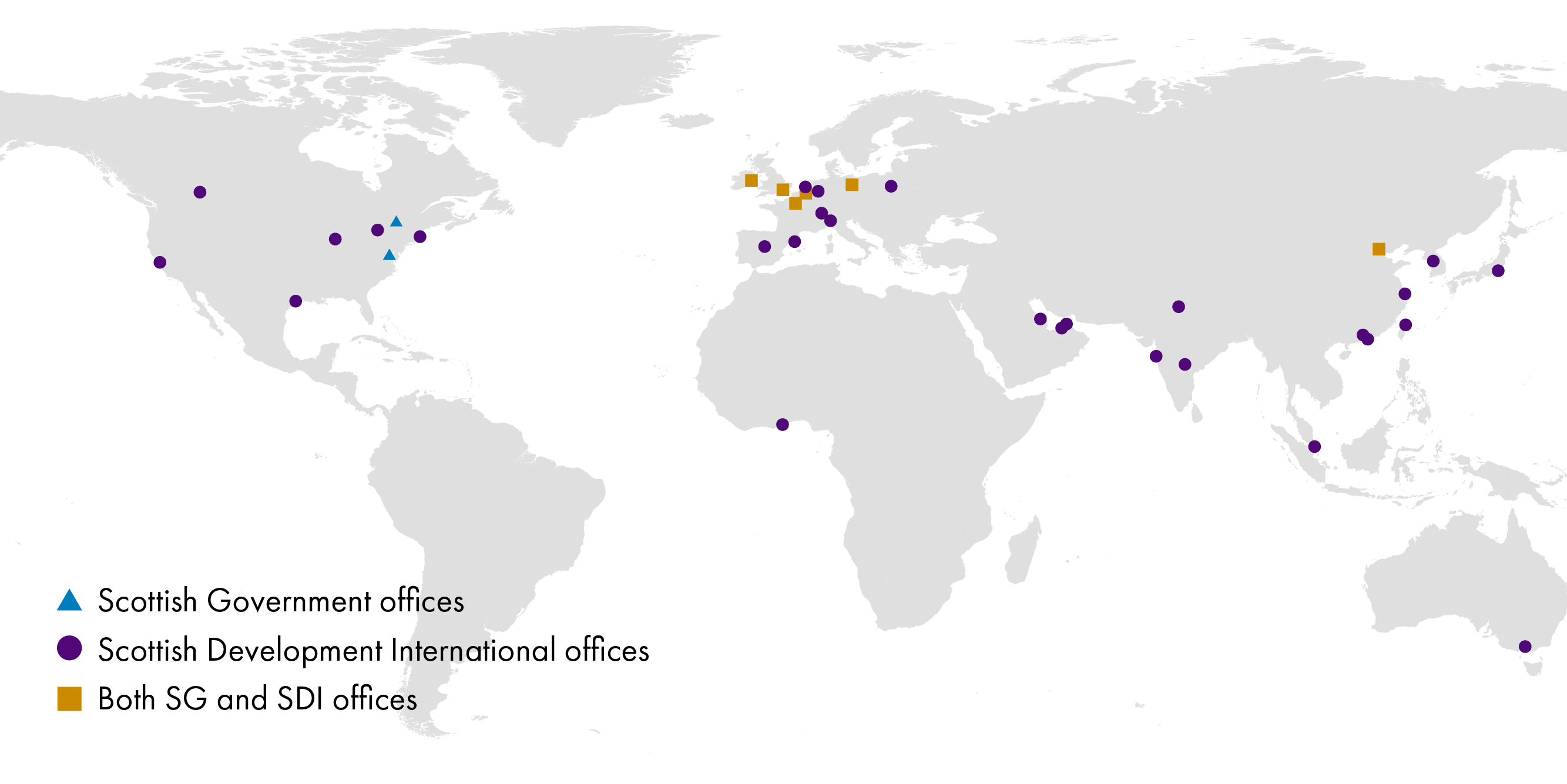
Scotland’s growing number of international offices will be expected to boost trading and political opportunities along with taking advantage of Scotland’s soft power.
Another key element of Scotland’s international footprint is its diaspora. A Scottish Government paper on the diaspora in 2009 put the number of people across the world claiming some sort of Scots ancestry at between 28 million and 40 million people. In the United States of America, the 2020 census indicated that just under five million Americans identify themselves as of Scottish descent, with four million more as Scots-Irish.
Diasporas can provide links to boost economic growth as demonstrated by the Scottish Government’s Global Scots network. The Scottish Conservative Party manifesto highlighted the role of the Global Scots network and pledged to maximise the use of the diaspora to sell Scotland by expanding the network to enhance Scotland’s international presence and exports.
How can Scotland’s international footprint be developed?
The Scottish National Party election manifesto set out that the new Scottish Government will expand Scotland’s international network by establishing new innovation and investment hubs for the Nordic and Baltic regions.
This approach fits with the previous Scottish Government’s policy to develop closer links with the Nordic countries (as set out in its Nordic Baltic Policy Statement published in March 2014) and the Arctic (set out in Arctic Connections: Scotland's Arctic policy framework published in September 2019).
The Scottish Green Party manifesto proposed further extending Scotland’s international footprint with new offices in Warsaw, Oslo, San Francisco, Atlanta, Delhi, São Paulo, Nairobi and Tokyo. The manifesto also proposed seeking associate membership of the Nordic Council and observer status of the Arctic Council.
The role for the Scottish Parliament
Whilst the opportunities for the Scottish Parliament to scrutinise the UK’s departure from the EU were limited, scrutiny of the Scottish Government’s international policies present an opportunity in Session 6. Through scrutiny, it is possible MSPs will be able to influence the geographic focus and policy aims of the Scottish Government.
However, evaluating Scotland’s international engagement is likely to be particularly challenging as much of the work of pursuing foreign policy is difficult to quantify in direct benefits (especially in the short term). In written evidence to the European and External Relations Committee in 2014, Dr Daniel Kenealy from the University of Edinburgh suggested that measuring success in achieving foreign policy goals was difficult as not all policy will have outcomes that can be measured. He added that:
What is, however, essential to evaluation on this basis is a clear statement, at the outset, of the goal being pursued. The fact that many of the benefits are intangible need not be an excuse for failing to be clear about goals. Only by doing that can any form of evaluation be carried out.
The Scottish Government’s National Performance Framework includes measurements for Scotland’s export statistics and Scotland’s international reputation which are informed by Scottish Government international policy.
The bottom line
Scotland will need to work harder to maintain its international profile following Brexit. It is likely that Session 6 will see an increased drive from the Scottish Government to develop a distinct foreign policy for Scotland. It will be important that the Scottish Parliament seeks to scrutinise, influence and evaluate the effectiveness of that policy.